Forums
- Forums
- Duggy's Reference Hangar
- USAAF / USN Library
- Republic F-105 Thunderchief
Republic F-105 Thunderchief
Post a reply
- Go to Previous topic
- Go to Next topic
- Go to Welcome
- Go to Introduce Yourself
- Go to General Discussion
- Go to Screenshots, Images and Videos
- Go to Off topic
- Go to Works in Progress
- Go to Skinning Tips / Tutorials
- Go to Skin Requests
- Go to IJAAF Library
- Go to Luftwaffe Library
- Go to RAF Library
- Go to USAAF / USN Library
- Go to Misc Library
- Go to The Ops Room
- Go to Made in Germany
- Go to Campaigns and Missions
- Go to Works in Progress
- Go to Juri's Air-Raid Shelter
- Go to Campaigns and Missions
- Go to Works in Progress
- Go to Skinpacks
- Go to External Projects Discussion
- Go to Books & Resources
-
3 years agoMon Dec 25 2023, 01:50pmDuggy
 Main AdminThe F-105 Thunderchief was the first supersonic tactical fighter-bomber that was developed from scratch for this role. All others before it were adaptations of aircraft that had originally been developed as pure fighters. The Thunderchief has the distinction of being the largest single-seat, single-engined fighter ever built.
Main AdminThe F-105 Thunderchief was the first supersonic tactical fighter-bomber that was developed from scratch for this role. All others before it were adaptations of aircraft that had originally been developed as pure fighters. The Thunderchief has the distinction of being the largest single-seat, single-engined fighter ever built.
Although designed for the nuclear strike role, the Thunderchief gained distinction for the role it played in the Vietnam War in delivering conventional ordinance on targets in the North. It was the primary USAF strike aircraft during the Rolling Thunder operations against targets in North Vietnam, and the two-seat version went on to perform superlatively in the Wild Weasel flak suppression role. At high speed at very low altitudes, there were no other aircraft that could catch it. Although a large, heavy, and relatively sluggish-maneuvering aircraft, the Thunderchief nevertheless managed to shoot down 27 1/2 enemy fighters during that conflict. The F-105 was known under several nicknames such as "Super Hog", "Ultra Hog", and "Lead Sled", but the aircraft is now remembered as the "Thud". The price paid was relatively high--397 of the 833 F-105s built (almost half the total) were lost in combat or in operational accidents during the Vietnam conflict.
The F-105 had its origin as far back as 1950. The F-84F Thunderstreak swept-wing fighter bomber had yet to make its first flight when, in June 1950, the Air Force was already asking Alexander Kartveli of the Republic Aircraft Corporation to initiate design studies for its successor. Kartveli and his staff looked at 108 different configurations under the company designation AP-63 (where AP stood for "Advanced Project") before settling on a single-seat, single-engine, swept-winged aircraft. The role was to be primarily that of nuclear strike, but a secondary air-to-air capability was envisaged. A Mach 1.5 maximum speed was anticipated. The airframe was to be matched to the extremely exacting requirements of high-speed, low-level operation.
The initial contractor proposal to the Air Force was issued by Republic in April of 1952. It contained most of the features that the Air Force would have liked to have had provided on the F-84F had they been technically feasible at the time. The aircraft was to be powered by an Allison J-71 turbojet. In May of 1952, the Air Staff endorsed this proposal in lieu of trying to create an improved supersonic version of the F-84F. The designation F-105 was assigned.
No General Operational Requirement (GOR) was issued at that time, but a letter contract was issued in September of 1952 for 199 F-105 aircraft, the first of which was to be ready for service by 1955. For its primary mission, the aircraft would be expected to carry a nuclear store in an internal bomb bay. Because of the large size of the nuclear weapons of the day, the bomb bay had to be 15 feet 10 inches long, 32 inches wide, and 32 inches deep.
In October of 1952, the Air Force awarded Republic a contract for pre-production engineering, tooling, and material procurement for the aircraft. However, in March 1953, the expected end of the fighting in Korea and the inability of the Air Force to define detailed operational requirements caused the program to be reduced to 37 F-105As and nine RF-105As. The F-105A was to be a pure fighter-bomber version, whereas the RF-105A was to be a photographic reconnaissance variant. The RF-105A was expected to bear much the same relationship to the F-105A as did the RF-84F Thunderflash to the F-84F Thunderstreak.
The Republic design team came up with a large single-seat aircraft with a mid-mounted sweptback wing. The aircraft was to be powered by a single J71-A-7 rated at 14,500 lb.s.t. with afterburner. The engine was fed by a pair of intakes mounted in the wing roots a la RF-84F Thunderflash. The main landing gear retraced inwards into the wings. Since the undercarriage was so stalky, much of the internal volume in the wing was taken up with the stowed landing gear, leaving no space for internal fuel. All the fuel had to be carried in fuselage tanks or inside externally-mounted droptanks. A low-mounted all-flying horizontal tail was fitted. From the outset, the aircraft was planned on a massive scale with an internal bomb bay able to accommodate up to 8000 pounds of nuclear or other weapons. The nuclear weapon was to be delivered using the new MA-8 fire control system, using a "toss-bombing" technique. In addition, as much as 4000 pounds could be carried externally on four underwing pylons or on an under-the-fuselage hardpoint. A defensive armament of four T-130 0.6-in machines was provided, with 200 rpg.
The F-105 mockup was inspected on October 27, 1953. By that time, it was apparent that the design had become so large and heavy that the J-71 engine originally earmarked for the F-105 would not meet the thrust requirements. The extremely advanced Pratt and Whitney J75 turbojet was substituted in its place. The J75 was rated at 16,000 lb.s.t. dry and at nearly 25,000 lb.s.t. with afterburning. At the same time, the four T-130 machine guns were replaced by a single General Electric T-171D 20-mm rotary cannon capable of firing up to 6000 rounds per minute. An ammunition drum was provided that could hold up to 1028 20-mm shells
It seemed likely that this new J75 engine would not be available for several years, so it was decided that the Pratt & Whitney J57 would be used in the initial machines for tests, with the J75 being introduced on the production line when it was finally available. The J57-powered machines were designated F-105A, with the J75-powered version being designated F-105B.
The advanced MA-8 fire-control system consisted of an AN/APG-31 ranging radar, a K-19 sight, a toss-bomb computer and the T-145 "special stores" release system. The combat weight was now up to 28,530 pounds.
In December of 1953, the Air Force suspended procurement of the F-105 because of excessive delays at Republic. Procurement was reinstated in February of 1954, but reduced to 15 aircraft.
By 1954, the design had crystallized sufficiently for a development contract to be placed under the WS-306A weapon system designation. On June 28, 1954, a formal contract was awarded for fifteen F-105As, all to be powered by the J57 engine. Further slippages led the Air Force to decide in September 1954 to reduce the program to three aircraft. However, next month, the number of aircraft was restored to six.
On December 1, 1954, the Air Force finally issued a General Operational Requirement covering the F-105. Designated GOR-49, it called for a J75-powered tactical strike aircraft with inflight refuelling capability and carrying an advanced fire control system. The GOR also called for an inertial navigation system, which was an extremely advanced feature for the day.
In February 1955, the Air Force again authorized acquisition of the 15 test aircraft. However, the contract was at that time amended and subdivided into 2 YF-105As, 10 F-105Bs, and 3 photographic- reconnaissance RF-105As.
While the first two YF-105As were under construction, Republic engineers learned of the difficulties being encountered by Convair with its YF-102 all-weather interceptor. In particular, engineering calculations of the transonic drag on the YF-102 had proven to be way off, and the aircraft could not exceed the speed of sound in level flight. Convair had found that the cure for the problem was the so-called "Area Rule", in which the cross-sectional area of the fuselage is narrowed in the region of the wing roots, so that the total effective cross section over the entire length of the airplane varies in a smooth and continuous fashion. Republic engineers decided to adopt the same sort of change for their F-105, the new "wasp waist" to be first incorporated on the F-105B. An immediate benefit from the reduction in drag produced by the adoption of the area rule was that full advantage could be taken of the increased thrust offered by the J75 engine, making a Mach 2 high-altitude performance possible.
Another innovation was the replacement of the plain flat intakes on the wing leading roots by two-dimensional sharp-edged forward-swept variable-geometry intakes to improve their efficiency at high Mach numbers. This resulted in the F-105 having a distinctive M-shape when seen in plan view.
Construction on the J-57-powered YF-105A continued unabated while these redesign efforts were underway. The YF-105A retained the straight-sided fuselage without the "wasp-waisting" that was to be introduced on the B-version, and it retained the plain flat wing-root air intakes.
The F-105 had a set of "clover-leaf" speed brakes attached to the end of the tailpipe. During braking, these petals unfolded to stand at right angles to the airflow. A ventral fin was added to the bottom of the rear fuselage to provide good stability at high speeds.
The first YF-105A rolled out of the factory in the autumn of 1955. It was shipped to Edwards AFB for initial trials over the Mojave Desert. The first flight of the YF-105A (54-098) took place on October 22, 1955, with Republic test pilot Russell M. Roth at the controls. It easily exceeded the speed of sound on its first flight, although, as expected, the transonic drag was quite high. It was the largest and heaviest single-seat fighter ever built up to that time. The maximum speed attained was Mach 1.2, even though it was powered only by a J57 engine and lacked a fuselage that was area-ruled.
On December 16, the aircraft was extensively damaged when Russell Brown was forced to make an emergency landing at Edwards AFB after the right main landing gear had been torn away after having been inadvertently extended during high speed flight. The pilot was uninjured. The aircraft was returned to the factory because of the damage, but repair costs turned out to be too high to justify returning 54-098 to flight status.
The second YF-105A (54-099) flew for the first time on January 28, 1956. It was identical to the first YF-105A. The second YF-105A was damaged beyond repair in an emergency crash-landing on the lakebed at Edwards AFB after the landing gear failed. The pilot walked away without injury.
Serials of the YF-105A:
54-098/099 Republic YF-105A-1-RE Thunderchief
Specification of the Republic YF-105A Thunderchief:
Engine: One Pratt & Whitney J57-P-25 turbojet, rated at 10,200 lb.s.t. dry and 15,000 lb.s.t. with afterburner. Performance: Maximum speed: 857 mph at 36,000 feet, 778 mph at sea level. Stalling speed was 185 mph. An altitude of 30,000 feet could be reached in 17.6 minutes. Combat ceiling was 49,950 feet. Normal range was 1010 miles and maximum range with full external fuel was 2720 miles. Fuel: Fuel capacity was 850 US gallons internal fuel. With full external fuel capacity, a total of 2500 US gallons of fuel could be carried. Dimensions: wingspan 34 feet 11 inches, length 61 feet 5 inches, height 17 feet 6 inches, wing area 385 square feet. Weights: 21010 pounds empty, 28,966 pounds combat, 40,561 pounds maximum takeoff. Armament: Armed with one 20-mm M61 rotary cannon. Up to 8000 pounds of ordinance could be carried.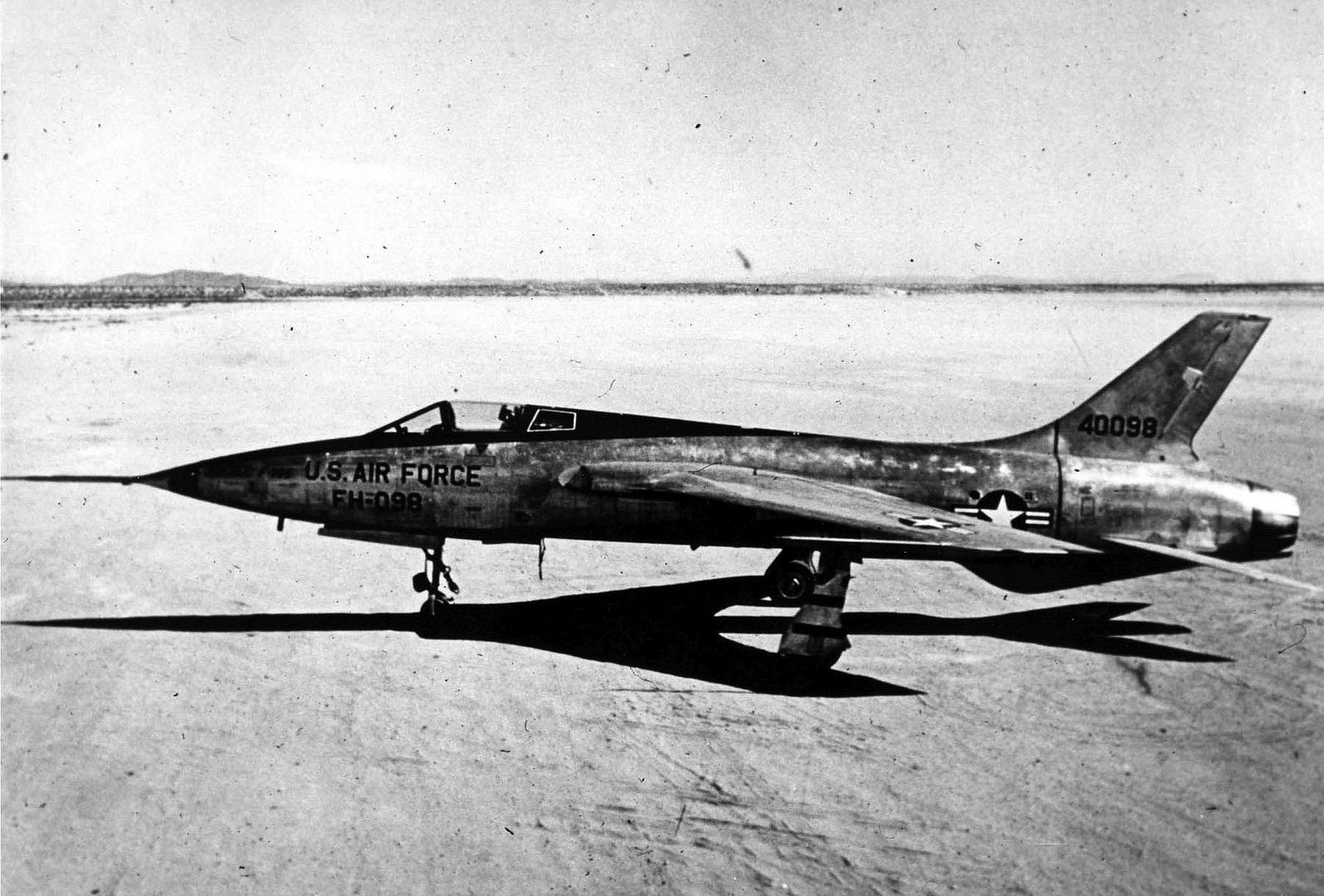
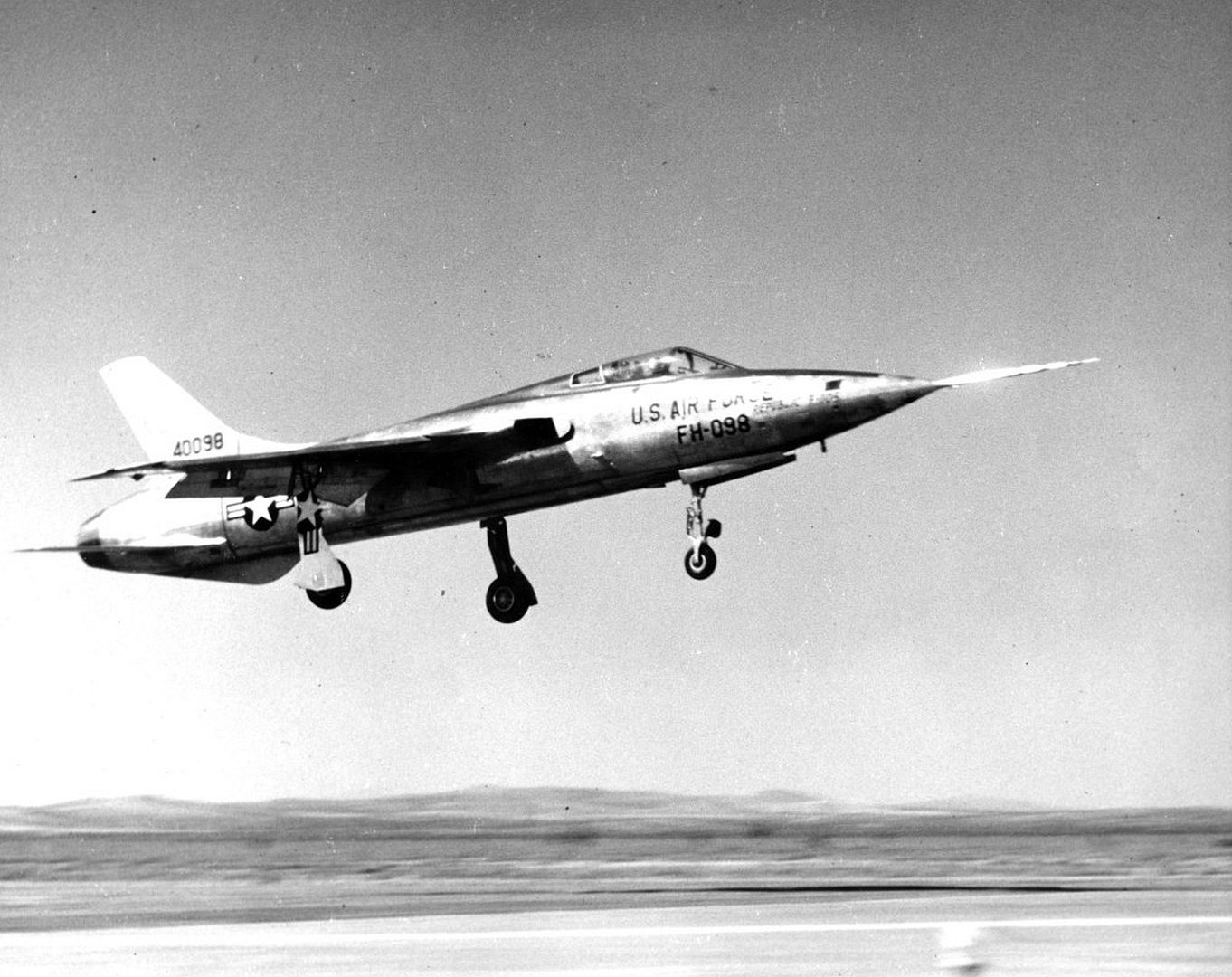
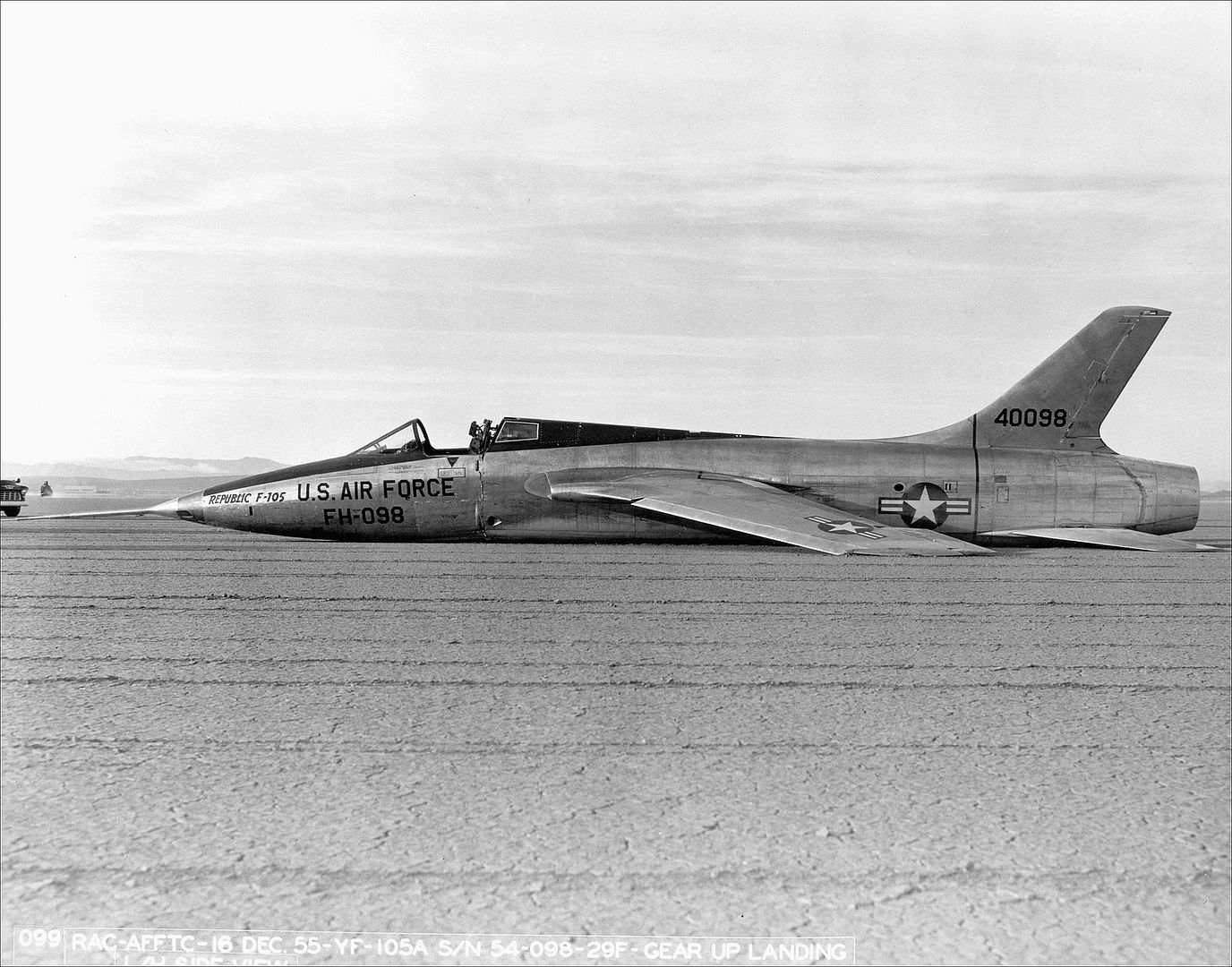
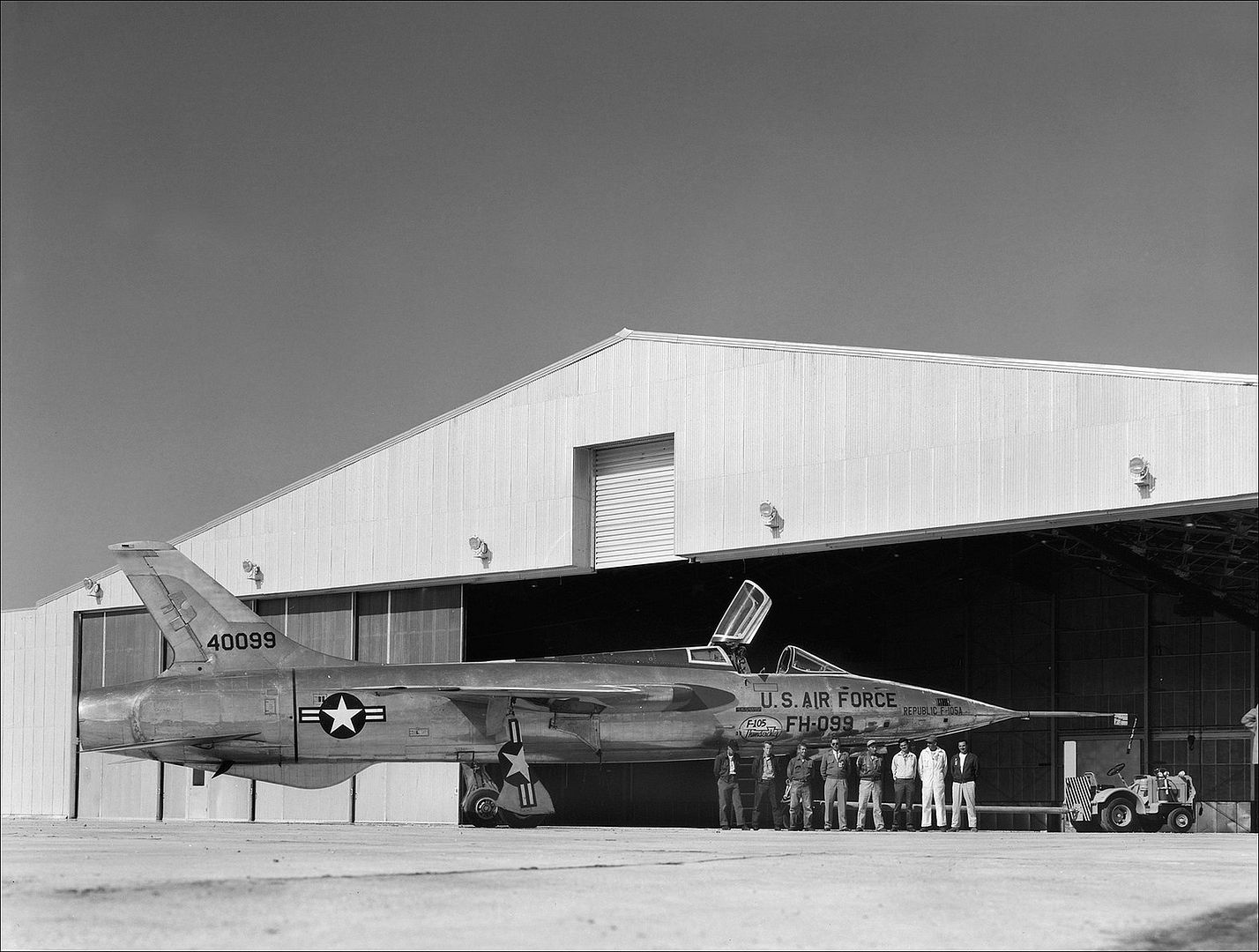
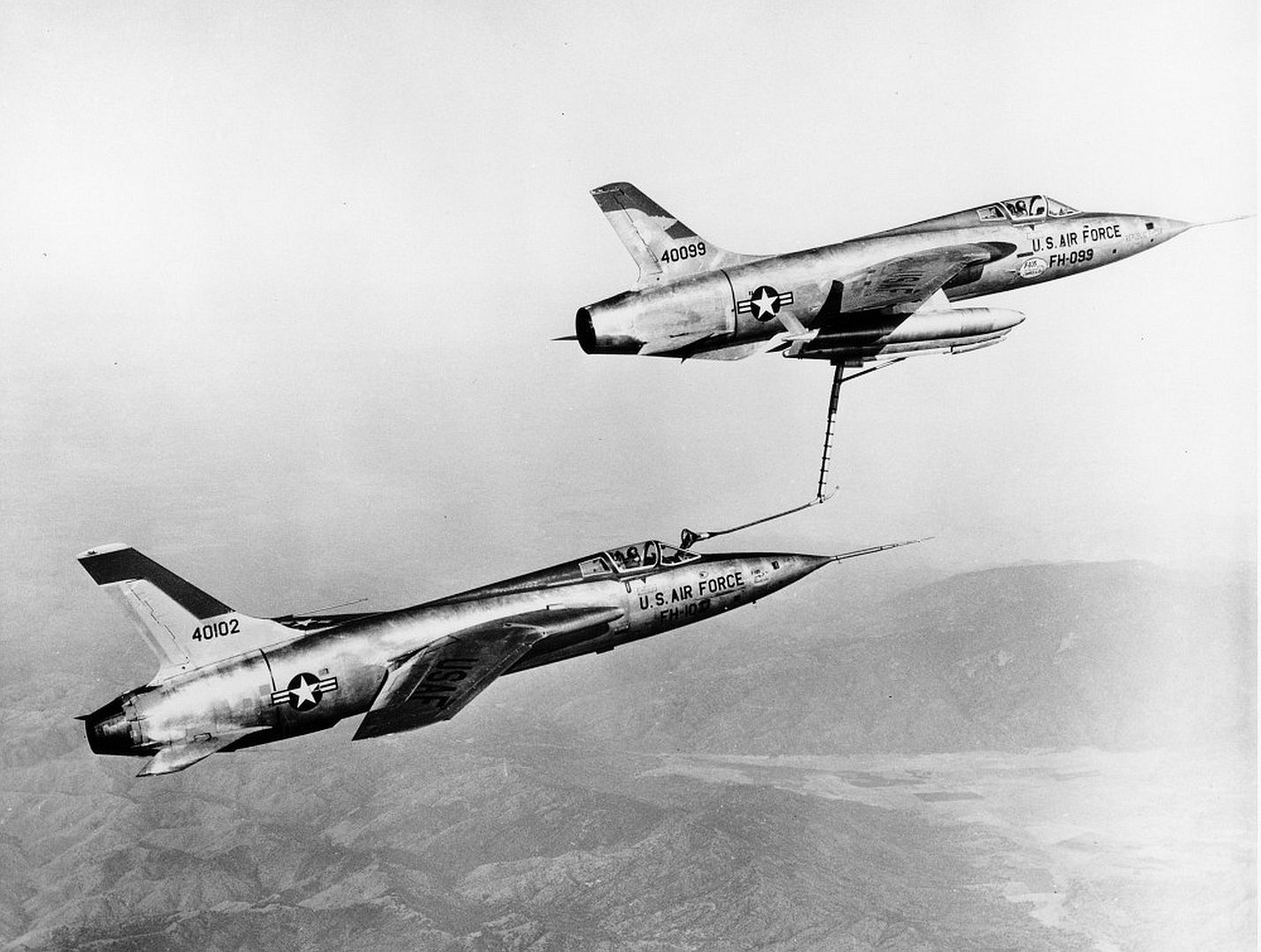
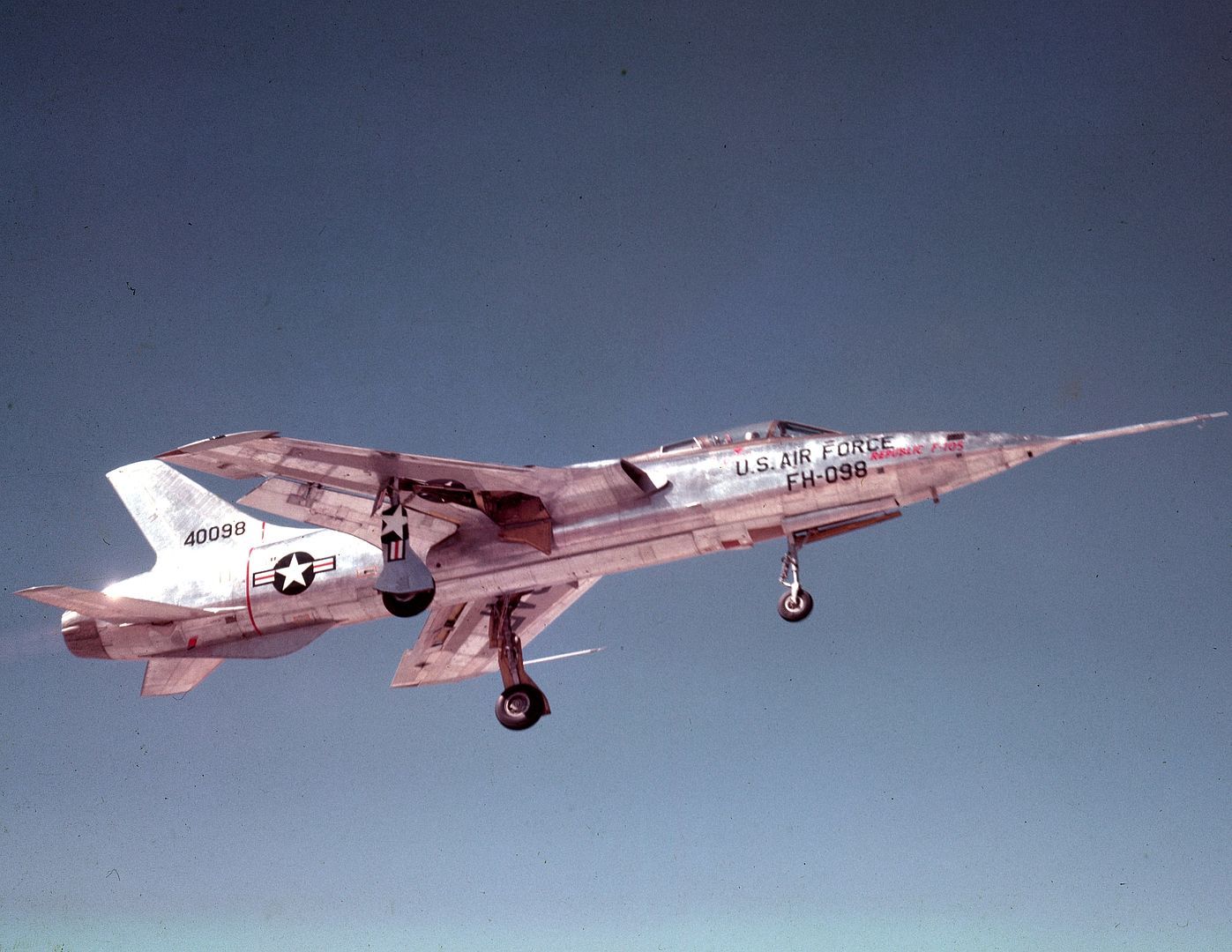
-
 Main AdminThe F-105B was the initial production version of the Thunderchief. It was powered by the new high-thrust Pratt & Whitney J75 turbojet, rated at 23,500 pounds of thrust with afterburning. The airframe was extensively revised to take full advantage of the new J75 turbojet, and had a fuselage that was reconfigured according to the Area Rule devised by Richard Whitcomb.
Main AdminThe F-105B was the initial production version of the Thunderchief. It was powered by the new high-thrust Pratt & Whitney J75 turbojet, rated at 23,500 pounds of thrust with afterburning. The airframe was extensively revised to take full advantage of the new J75 turbojet, and had a fuselage that was reconfigured according to the Area Rule devised by Richard Whitcomb.
The RF-84F-style air intakes fitted to the YF-105A were replaced by a set of swept-forward air intakes that would take advantage of the increased engine power and would make a Mach 2 performance possible. A boundary layer fence was located in front of each intake next to the fuselage. There was a variable plug inside each duct which could be moved forwards or backwards under the control of a Bendix central air data computer to provide proper airflow to the engine as a function of Mach number. These ramps were fully retracted at low speeds, allowing maximum air ingestion, and at high speed they were fully extended to decrease air flow.
A set of auxiliary air inlets were provided that could be opened automatically whenever negative pressure existed in the ducts to provide needed airflow at low speeds. These air inlets could be opened only when the landing gear was extended, an interlock keeping the doors fully closed whenever the landing gear was retracted. Just in front of the engine compressor stage there were a set of bleed doors in the intake ducting that could dump any excess airflow which would tend to force the shock wave out of the duct throat.
In order to prevent vertical tail flutter (which had been a problem with both the earlier F-100A and with the YF-105A as well), the vertical tail and rudder on the F-105B were increased in both height and chord. A ram-air intake was fitted to the base of the vertical fin, capturing air for the cooling of the aft end of the aircraft. In addition, on F-105B production aircraft the small rear vision windows behind the canopy (a carryover from the F/RF-84F) were deleted.
The F-105B also introduced a four-petal, cloverleaf set of air brakes fitted around the jet engine exhaust orifice at the extreme rear of the aircraft. The four segments could be deployed in several different configurations, depending on the needs of the mission. They could be opened outward to a maximum angle of 90 degrees. During landing, only the two side segments could be deployed because the bottom segment had insufficient ground clearance and the top segment would block the brake 'chute deployment.
Four YF-105B service test prototypes were built (serials were 54-100/103). They were powered by the YJ75-P-3 turbojet, rated at 16,470 lb.s.t. dry and 23,500 lb.s.t. with afterburning.
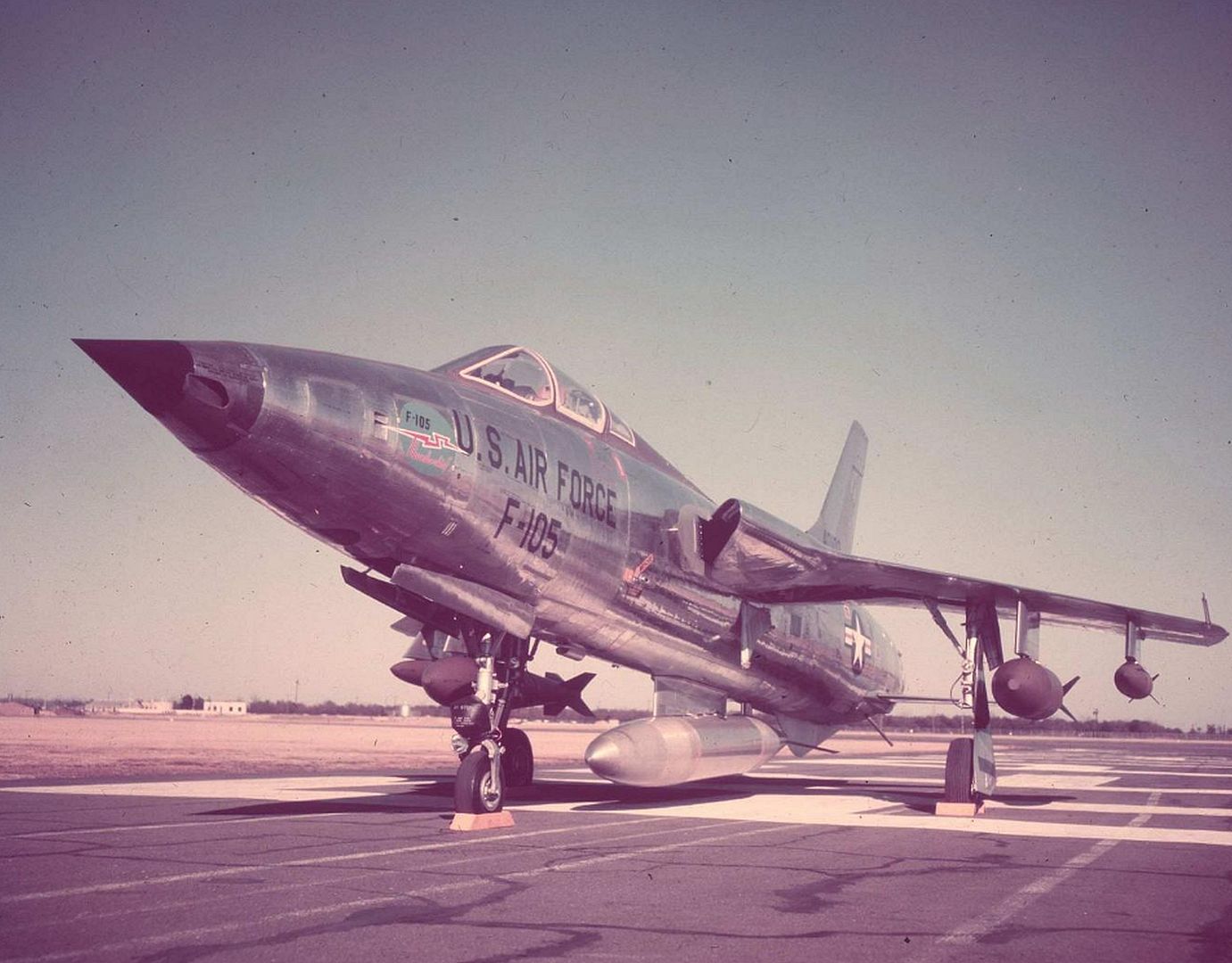
The first YF-105B (54-100) flew on May 26, 1956, piloted by Republic test pilot Lin Hendrix. It flew for one hour but was damaged on landing when the nose gear failed to extend. It was damaged beyond economical repair when it was dropped by the crane operator while it was being removed from the runway at Edwards AFB.
On June 19, 1956, the name Thunderchief was officially given to the F-105.
On January 30, 1957, the next YF-105B (54-101) took off on its first flight. It too ended up on its belly after yet another landing gear failure. The problem was traced to an interference between the main landing gear and auxiliary air intakes, and was fairly easily fixed.
Further schedule slippages and excessive costs generated numerous changes in USAF procurement planning. In March of 1956, the Air Force released funds for the acquisition of 65 F-105Bs and 17 RF-105Bs. The RF-105B was a photographic reconnaissance version of the F-105B fighter bomber and was designed to replace the RF-84F. In June, five two-seat F-105Cs were added to the program.
The maximum speed reached during tests was Mach 2.15, which was remarkable considering the weight of the plane. The tests proved generally satisfactory as far as aircraft performance was concerned. However, other key systems had reliability problems, including the General Electric MA-8 fire control system and its principal components (E-34 radar ranging set, E-50 gyroscopic sight, E-30 toss-bombing set, and nuclear weapon safing and arming system), the Bendix navigation computer, and the General Electric FC-25 autopilot. The complexities of the F-105's subsystems compounded the contractor's difficulties,
In January of 1957, GOR 49 was amended to call for the incorporation of the APN-105 all-weather navigation system.
The first production F-105B (54-104) took off on its maiden flight on May 14, 1957, Henry G. Beaird Jr. being at the controls. It was accepted by the Air Force on May 27, three years later than originally anticipated.
On November 22, 1957, GOR 49 was revised once again, and the inertial navigation system was deleted in favor of the projected AN/APN 105 system. Several requirements were added, e.g., a new cockpit instrument display, a tow target subsystem, and a TX-43 nuclear weapon capability.
The F-105B was equipped with the MA-8 fire control system, which consisted of an E-50 sighting system operating in conjunction with an E-34 radar ranging gunsight mounted in the extreme nose and an E-30 bomb toss computer.
The roomy fuselage had a capacious bomb bay in the belly. The bay was originally designed to carry a nuclear weapon, since the original role of the Thunderchief was tactical nuclear strike. Later, as the use of nuclear weapons in warfare became less likely, the internal weapons bay was redesigned so that it could carry an additional fuel tank or other types of conventional weaponry. Conventional weapons could also be carried on four underwing hardpoints and on one ventral hardpoint underneath the fuselage.
The fuel was carried in seven separate fuel tanks lined up along the upper rear fuselage behind the pilot. Total internal fuel capacity was 1160 US gallons, of which 25 gallons of useful fuel was actually located in the fuel lines. Two 450-gallon drop tanks could be carried under the inboard underwing pylons, and an additional 450 or 650-gallon drop tank could be carried on a hardpoint underneath the fuselage. In addition, the bomb bay could accommodate a 390 gallon fuel tank in place of the "special store". Total fuel load (internal plus external) could be as high as 3100 US gallons.
A retractable probe-and-drogue type of midair refuelling probe was mounted on the left side of the fuselage nose just ahead of the pilot's cockpit.
The public got its first view of the F-105B at a display at the Andrews AFB Open House on July 28, 1957, which celebrated the 50th anniversary of military aviation.
Production F-105Bs began to roll off the line at Farmingdale in 1958, and the Air Force officially accepted its first machine on May 27, 1958. The first unit to receive the F-105B was the 335th Tactical Fighter Squadron of the 4th Tactical Fighter Wing of the TAC. This outfit was first based at Eglin AFB, then later at Seymour Johnson AFB. The 335th began to work up with the F-105B in August 1958, and in January of 1959 the unit was declared operational with the type. Since various delays had precluded the completion of all the pre-operational tests, the 335th had to carry out some of these tests. However because of maintenance difficulties and production slippages the 335th did not become fully operational with the F-105B until 1960. There were significant problems with the autopilot, the central air data computer, and the MA-8 fire control system. In addition, there was an acute shortage of spare parts which kept many aircraft from flying. In early 1960, all the F-105Bs flying with the 335th had to be grounded for various regions, including a lack of spare parts. Nevertheless, the F-105B did manage to complete its first year of service without a single major accident, becoming the first aircraft in USAF service history to be so fortunate.
On December 11, 1959, an F-105B piloted by Brig. Gen. Joseph Moore (commander of the 4th TFW) set a new world speed record of 1216.48 mph over a 100-kilometer closed circuit.
The other two squadrons of the 4th Tactical Fighter Wing (the 334th and 336th) received F-105Bs by the end of 1960. These squadrons were destined to be the only USAF operational combat units to use the F-105B. The fourth squadron of the 4th TFW (the 333rd TFS) was not reequipped until 1961, when the first F-105Ds became available.
These three squadrons were assigned the duties of carrying out Category III testing at Williams AFB in Arizona and at Nellis AFB in Nevada. The number of available F-105Bs remained insufficient to equip all of the squadrons and serviceability was low due to lack of spares and the chronic unreliability of the electronic components. Problems with maintenance and serviceability continued through 1961, and the F-105B required about 150 maintenance hours for each hour spent in the air. However, whenever everything was working as advertised, the F-105B handled well and had a good performance. Most F-105B deficiencies were eventually corrected under Project Optimize.
Despite the aircraft's large size and weight, in May of 1963 the F-105B was selected to replace the F-100C Super Sabres of the Thunderbirds flight demonstration team. The last of nine specially modified F-105Bs was delivered on April 16, 1964, ten days before the first scheduled public performance with the new planes. The aircraft had the 20-mm cannon and associated ammunition, the Doppler equipment, and other associated military items deleted and replaced with ballast and a baggage compartment. A smoke system was installed in the bomb bay, with a pair of pipes on the ventral fuselage surface directing smoke oil into the aircraft's exhaust. Standard F-105B flaps and landing gear were replaced by those from the later F-105D. Four of the Thunderbirds F-105Bs were fitted with a steel tail to withstand the increased stress when flying in the slot or when performing the "knife edge" maneuver. This also made it possible for the aircraft to fly the "slot" position without risking thermal damage to the fin from the exhaust of the lead aircraft. Despite some misgivings about the use of so large and heavy an aircraft as the F-105, the team had few problems in adapting to the Thunderchief.
The Thunderbirds team flew a few demonstrations with their F-105Bs, but a serious accident occurred in May. Captain Devlin was killed when his F-105B (57-5801) disintegrated after hitting a mast. The modifications directed as a result of this accident prevented the use of the F-105Bs in any more public airshows. Because of its heavy schedule, the Thunderbirds team was hastily re-equipped with eight F-100D Super Sabres. The F-100Ds remained with the Thunderbirds until 1969, when the team re-equipped with F-4E Phantoms. The remaining F-105Bs were brought back to combat standards and were delivered to the 141st TFS of the New Jersey Air National Guard.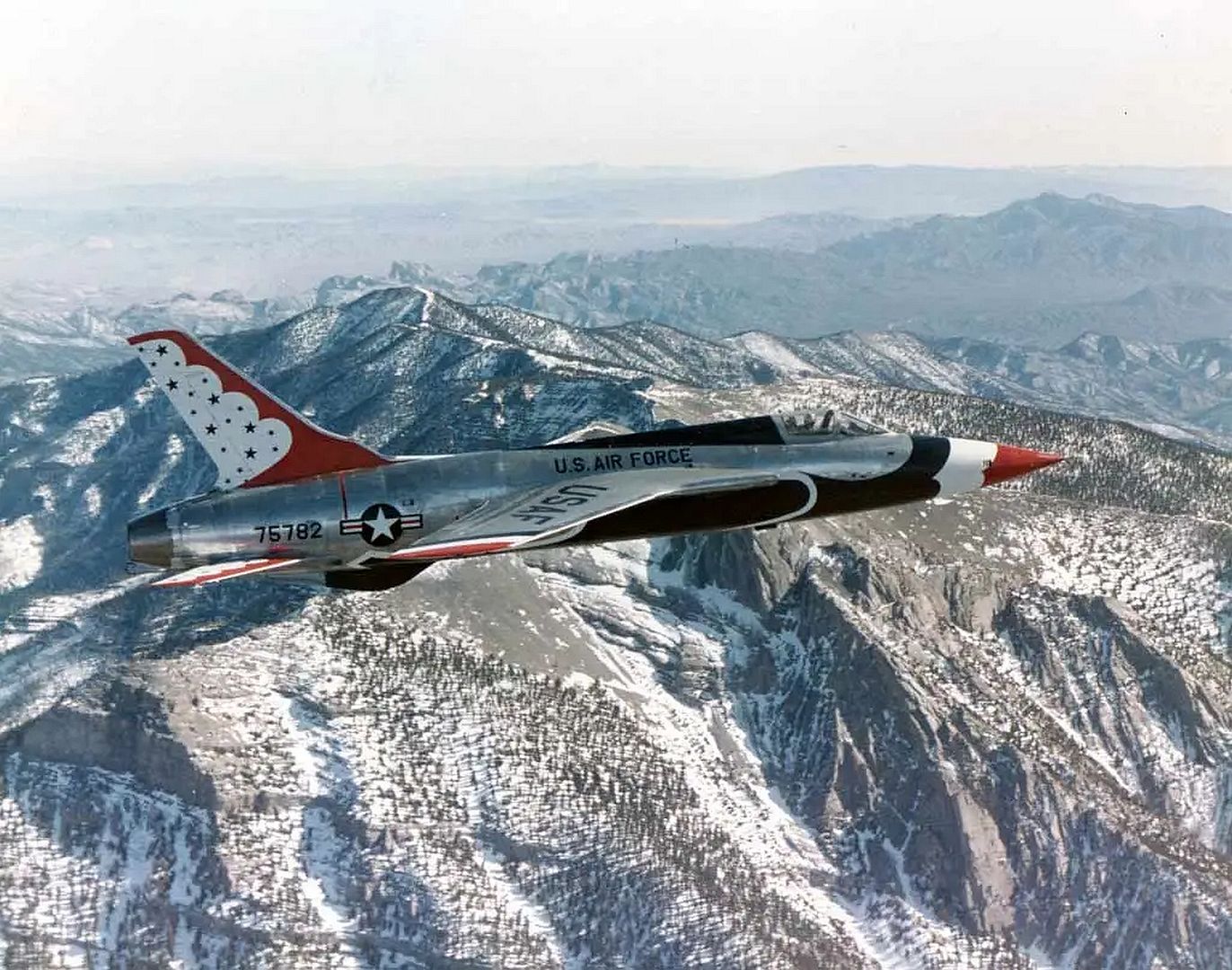
Aircraft from the first F-105B production blocks were powered by the J75-P-5 engine, but the F-105B-20-RE block was given the J75-P-19 engine with an additional thousand pounds of thrust. Subsequently, this engine was retrofitted to earlier production block aircraft.
The F-105B's service with the USAF was relatively brief, being superseded by the all-weather F-105D version beginning in 1964. The surviving USAF F-105Bs were then transferred to the Air National Guard. The first surplus F-105Bs reached the 108th TFG, New Jersey ANG on April 16, 1964. The New Jersey ANG retained a few F-105Bs until 1981, when they were finally sent off to the boneyards.
Although the Air Force disposed of most of its F-105Bs during 1964-65, they retained a few F-105Bs for training purposes at McConnell AFB in Kansas until late 1969. A few F-105Bs served with the 508th Tactical Fighter Wing of the Air Force Reserve at Hill AFB in Utah beginning in 1973, the last examples finally going off to the boneyards in 1981. At least five have been turned over to museums.
The following Air Force units flew the F-105B:
4th Tactical Fighter Wing, Seymour Johnson AFB
334th Tactical Fighter Squadron (June 1959-Jan 1964)
335th Tactical Fighter Squadron (May 1958-June 1960)
336th Tactical Fighter Squadron (Aug 1959-Jan 1964)
The following Air Force Reserve units flew the F-105B:
508th Tactical Fighter Wing, Hill AFB
466th Tactical Fighter Squadron (Jan 1973-May 1981)
The following Air National Guard units flew the F-105B:
177th Tactical Fighter Group, New Jersey ANG, NAFEC Atlantic City
119th Tactical Fighter Squadron (June 1970-Jan 1973)
108th Tactical Fighter Group, New Jersey ANG, McGuire AFB. Changed designation to 108th TFW in Dec 1974.
141st Tactical Fighter Squadron (April 1964-May 1981)
Serials of F-105B:
54-100/103 Republic F-105B-1-RE Thunderchief
0100 at McClellan Aviation Museum, CA
54-104 Republic F-105B-5-RE Thunderchief
54-105 Republic JF-105B-1-RE Thunderchief
54-106/107 Republic F-105B-5-RE Thunderchief
54-108 Republic JF-105B-1-RE Thunderchief
54-109/110 Republic F-105B-5-RE Thunderchief
54-111 Republic F-105B-6-RE Thunderchief
54-112 Republic JF-105B-2-RE Thunderchief
57-5776/5784 Republic F-105B-10-RE Thunderchief
5782 to Thunderbirds
57-5785/5802 Republic F-105B-15-RE Thunderchief
5790 to Thunderbirds
5793 to Thunderbirds
5797 to Thunderbirds
5798 to Thunderbirds
5801 to Thunderbirds
5802 to Thunderbirds
57-5803/5840 Republic F-105B-20-RE Thunderchief
57-5841/5845 Cancelled contract (believed for F-105B)
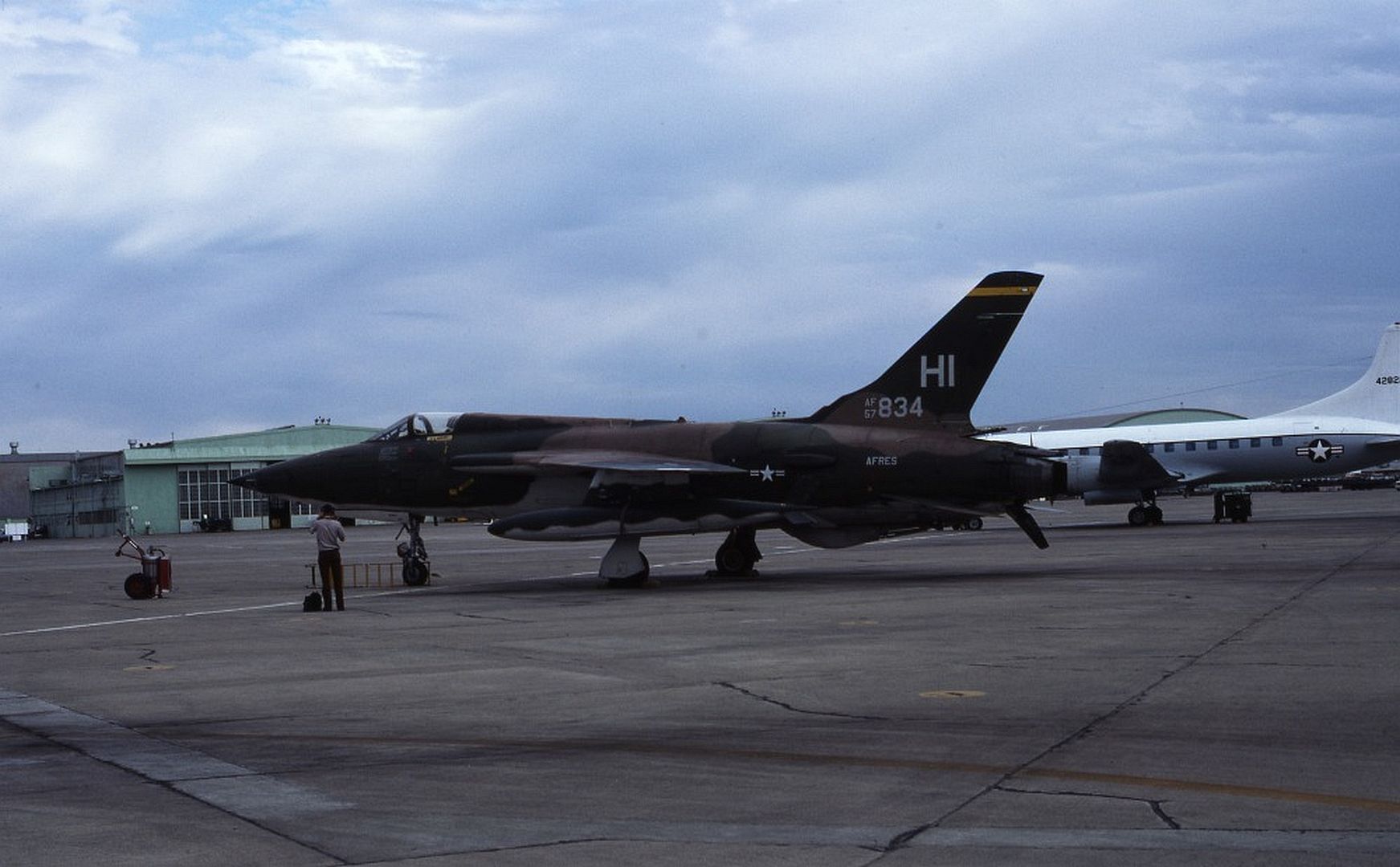
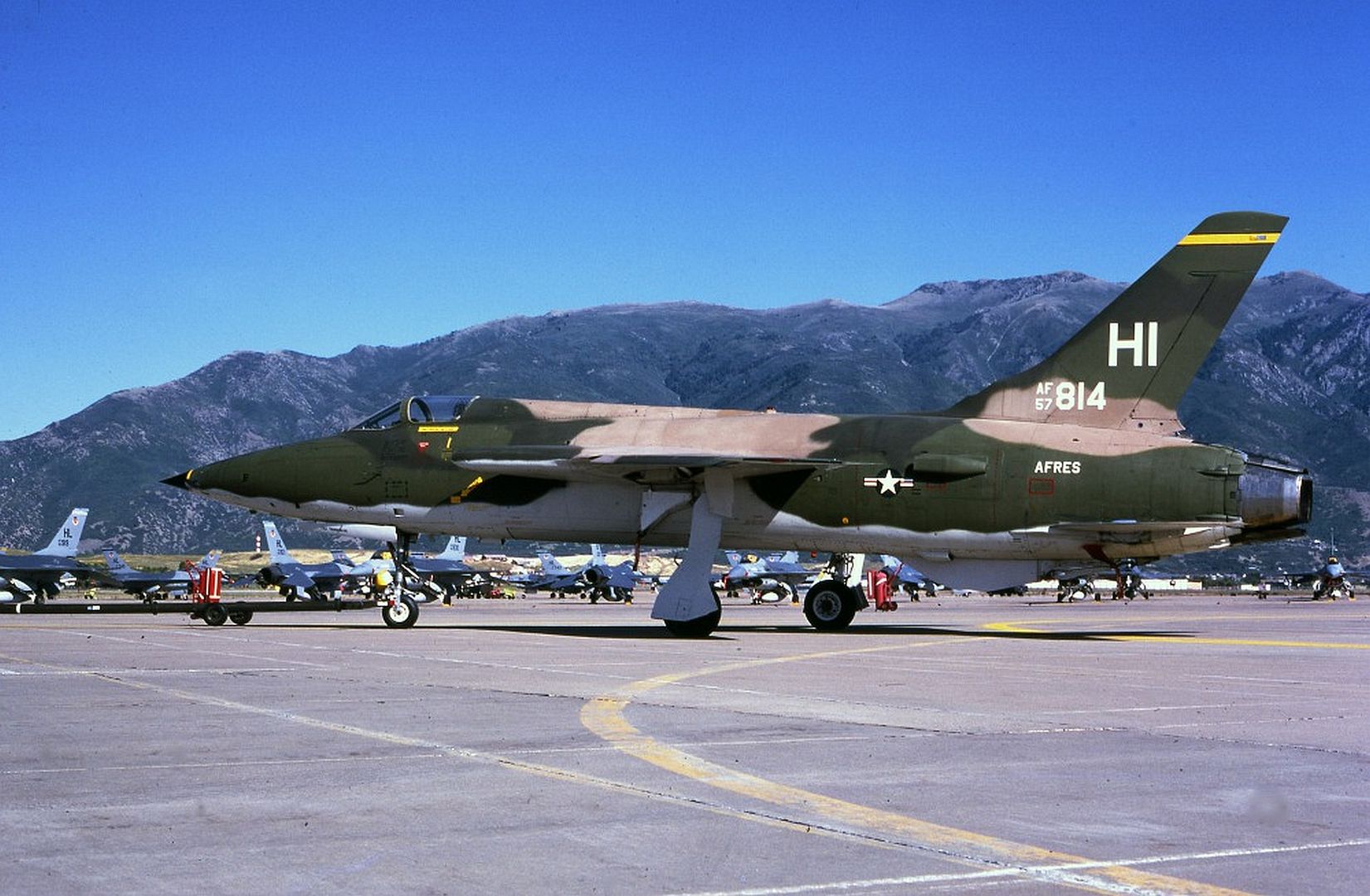
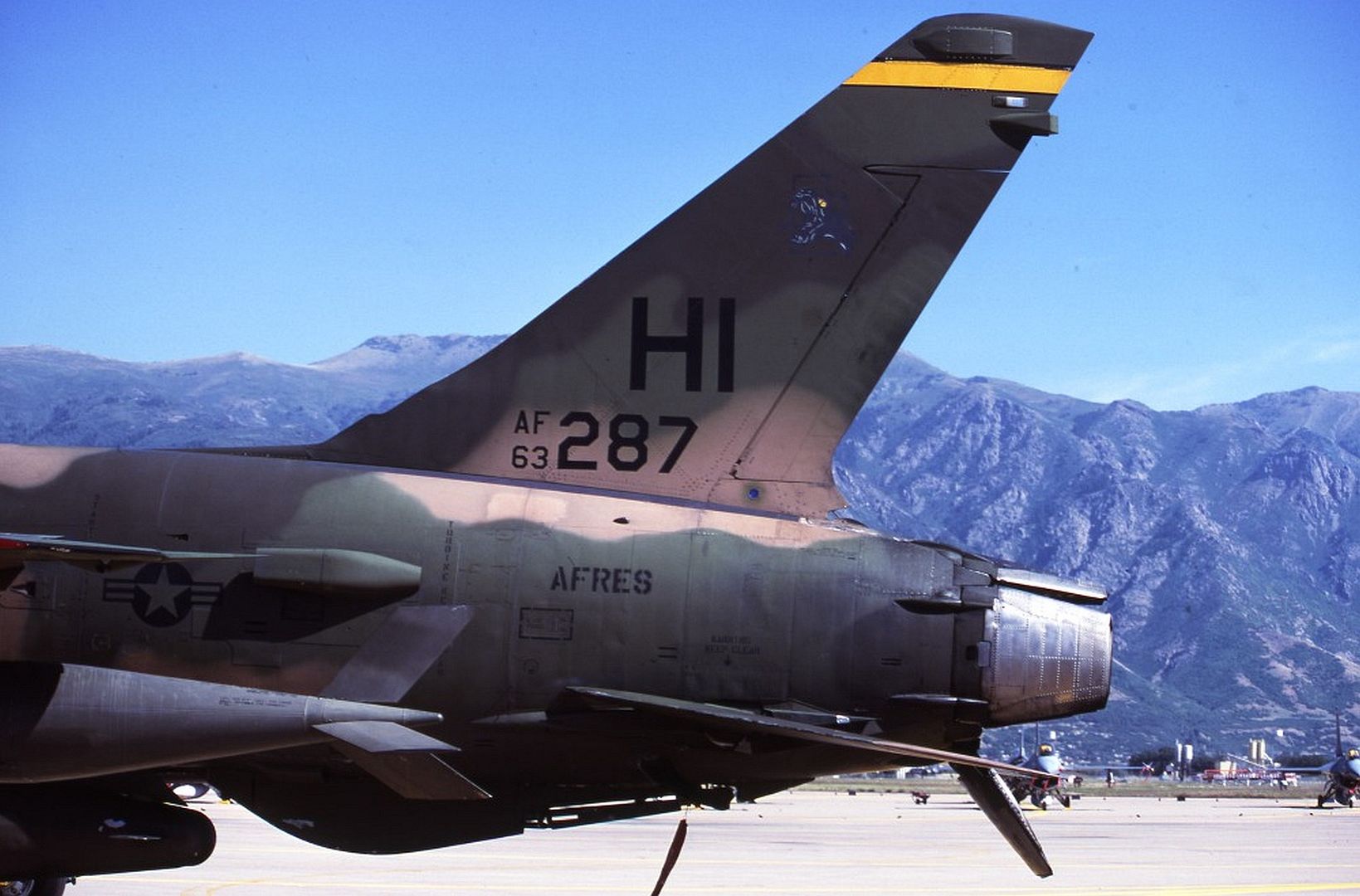
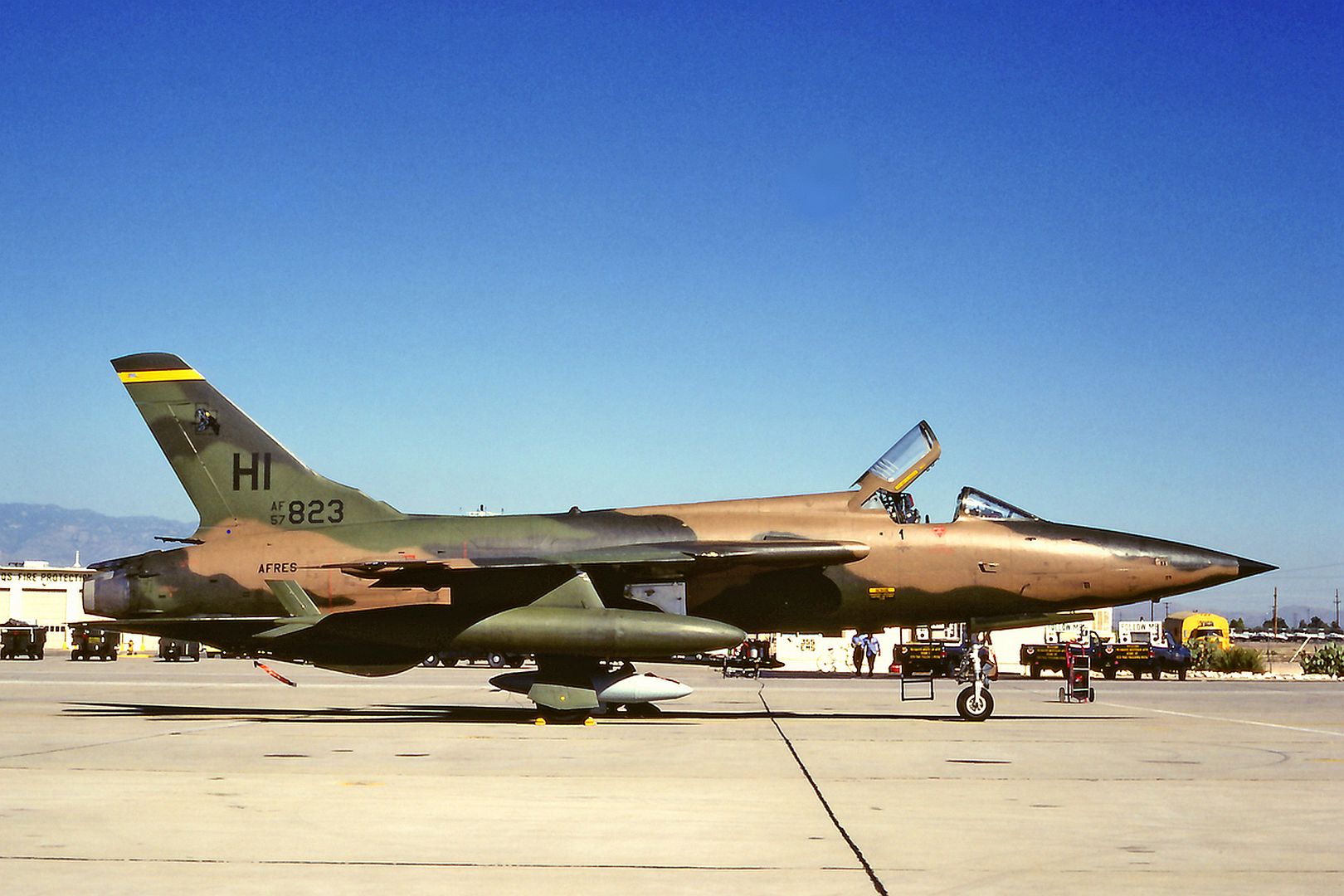

-
3 years agoFri Jan 07 2022, 12:45pmDuggy
 Main AdminThe F-105D was the major production version of the Thunderchief series. It was essentially an all-weather version of the basically day-only F-105B.
Main AdminThe F-105D was the major production version of the Thunderchief series. It was essentially an all-weather version of the basically day-only F-105B.
In November 1957, the USAF had revised GOR 49, calling for an all-weather version of the Thunderchief to follow the F-105B. This was to be designated F-105D. In addition, the F-105D was to be capable of carrying the new Mk 43 nuclear weapon on either centerline or inboard underwing pylons.
Externally, the F-105D differed from the F-105B in having a slightly longer and wider nose, which housed the AN/ASG-19 "Thunderstick" fire control system. This was designed to meet the all-weather requirement specified in the November 1957 revision of GOR 49. The AN/ASG-19 was designed around the NASARR R-14A all-purpose monopulse radar. This radar was optimized in both air-to-ground and air-to-air modes and was capable of performing both low-level and high-level missions. This system had a ground an contour-mapping feature. The aircraft was equipped with a General Electric FC-5 flight control system which operated in conjunction with the R-14A radar to provide the F-105D with full all-weather capability. The system comprised a toss bomb computer, a sight system, an AN/APN-131 Doppler navigator, an air data computer, missile launch computer, autopilot, and search and ranging radar. The radar installation also incorporated a terrain guidance mode which permitted the pilot to let down through bad weather in unfamiliar territory and to hug the ground in order to avoid detection.
The F-105D was powered by a higher-thrust J75-P-19W engine equipped with water injection. This engine offered 1000 pounds more thrust than the P-19 engine of the F-105B. In order to provide the increased airflow required by the more powerful engine, the interior contours of the air intakes and ramps were redesigned, and the air data computer had to be reconfigured. The plumbing for the water injection system required some redesign of the rear fuselage.
A new cockpit was provided with a new instrument panel with many of the old circular dials replaced by vertical "tape" instruments, which were easier to read.
With all of this new equipment, the F-105D was over 1000 pounds heavier than the F-105B. The higher gross weight of the F-105D required the provision of a stronger main landing gear and more robust brakes.
Externally, the F-105D could be distinguished from the B by its longer and wider nose ,the D is about 15 inches longer than the B, with the larger radome for the NASARR radar. The F-105B carried only a simple radar ranging sight for its cannon, so its radome was considerably smaller. In addition, the F-105D had a pitot tube mounted on the extreme tip of the nose rather than at the wingtip as it was in the F-105B. The two aircraft were otherwise quite similar.
The F-105D had an arrester hook mounted on the rear of the ventral fin. This hook was intended to engage a wire in case the aircraft overshot the end of the runway during a landing. The Thunderchief was certainly NOT ever intended for carrier-based operations.
The first F-105D (58-1146) flew on June 9, 1959 with Lin Hendrix at the controls. The first F-105D was accepted by the TAC at Nellis AFB on September 28, 1960. The initial contract for 59 F-105Ds was increased to nearly 300 by the end of 1961. Ultimately, 610 F-105Ds were built, making it the major variant of the Thunderchief. At one time, there were plans to build over 1500 F-105Ds, but the advent of the F-4 Phantom led Secretary of Defense Robert McNamara to decide to equip no more than 7 combat wings with the F-105D, cutting the eventual production to about half of that originally planned.
The first unit to receive the new F-105D was the 335th Tactical Fighter Squadron of the 4th Tactical Fighter Wing, which exchanged its older F-105Bs for the new D-model in June of 1960. These planes were essentially flight test machines and did not have much of the equipment that was planned for the F-105D The 335th was again forced to carry out part of the evaluation program with the F-105D, just as they had with the B. The Thunderchief's first European deployment came in May of 1961, when the 36th TFW based at Bitburg in Germany received its first F-105Ds. It was soon followed by the 49th TFW. F-105Ds were also supplied to the 4520th Combat Crew Training Wing based at Nellis AFB plus the 36th TFW (22nd, 23rd, and 53rd Squadrons), the 49th TFW (7th, 8th, and 9th Squadrons), the 18th Fighter Bomber Wing (12th, 44th, and 67th squadrons), the 355th FBW (354th and 357th Squadrons), and the 388th TFW. The 36th and 49th Wings went to Europe at the end of 1961 to provide NATO with nuclear strike capability. The 8th and 18th Wings were stationed in Japan from 1962 onwards.
In June of 1961, the F-105D demonstrated its ability to carry and deliver seven tons of bombs during special tests at Eglin AFB in Florida. This was the heaviest load of bombs ever carried by a single-engined fighter. This feat was repeated in October of 1961 at Fort Bragg, North Carolina, with President Kennedy being one of the eyewitnesses.
All F-105Ds were briefly grounded in December 1961 after the aircraft's main fuselage frame failed during a laboratory fatigue test at Wright-Patterson AFB. However, subsequent tests indicated that the frame had still retained considerable strength even after cracking. Republic had suitable adapters and tools to do the required corrective work, so the grounding was relatively brief.
A strike at the Republic plant lasting two and a half months in the spring of 1962 resulted in additional delays in F-105D deliveries. A Taft-Hartley injunction ended the strike on June 18, but production was delayed sufficiently to disrupt USAF service plans.
In June of 1962, there were two major accidents at Nellis AFB, and all F-105Bs and Ds were once again grounded, this time for replacement of chafed electrical wires and the correction of flight control deficiencies. In addition, it was discovered that several inflight failures had been caused by moisture getting through seals and disrupting electronics and avionics. This maintenance and upgrade project was known under the code name Look Alike. The project started in mid 1962, but it turned out that these modifications took a lot longer than expected, and were subsequently expanded in scope to include a bringing of all available F-105D aircraft up to F-105D-25-RE standards. This quadrupled their conventional weapons capacity, increasing it from four to sixteen 750-pound bombs. Wiring and control equipment were added for carrying and launching Martin AGM-12B or C Bullpup air-to-surface missiles. A tailhook was installed under the fuselage for short or rough-field operations. Another innovation which helped to alleviate the moisture problem was to apply a layer of silver acrylic paint to the entire surface of the aircraft. These modifications were not fully completed until mid-1964.
The F-105D was originally intended for the nuclear strike role, with the primary armament being a "special store" (a euphemism for a nuclear weapon) housed in the internal weapons bay. This weapon was usually a Mk 28 or a Mk 43. However, an Mk 61 could be carried underneath the left or right inboard underwing pylon and a Mk 57 or a Mk 61 could be carried underneath the centerline pylon. However, as nuclear war became less and less likely, the nuclear weapon carried in the internal weapons bay was usually replaced by a 390-gallon internal fuel tank, the offensive load being carried on four underwing pylons and on a pylon mounted underneath the fuselage on the centerline. From the F-105D-20-RE production block onward, the Thunderchiefs had increased emphasis on conventional weapons delivery, with the capability of carrying a wide-ranging combination of external stores underneath the wings and fuselage. Many of the earlier production block F-105Ds were eventually upgraded to this standard.
At the time of the design of the F-105, TAC was equipped with hose-and-drogue tankers such as converted KB-50s, whereas boom tankers such as KC-97s and KC-135s had been assigned to SAC. In order that it be capable of being refuelled in midair by the KB-50 fleet, the F-105 was fitted with a retractable midair refuelling probe which swung outward from a slot in the forward fuselage just ahead of the cockpit. Unfortunately, the retirement of the KB-50 tankers left TAC dependent on SAC's boom tankers. Although a hose extension could be attached to the end of the flying boom of the KC-135 so that it could handle probe-and-drogue receiving aircraft, it was thought that it would be beneficial for TAC to have aircraft that were fully compatible with SAC booms. Consequently, the last few F-105Ds off the production line (production block -31) were given the capability of refuelling from either a flying boom or a hose-drogue type of tanker. This was done by fitting a flush-mounted retractable door-type receptacle in front of the windshield which could accept a flying-boom type of midair-refuelling probe. Some earlier F-105Ds were retrofitted with these receptacles.
In service, the seven TAC wings using the F-105D experienced lots of accidents and operational problems which led to no less than ten groundings. The aircraft came to be known under the rather derogatory nickname "Thud", and had a questionable reputation for being too heavy, having too long a takeoff run, and being a maintenance nightmare. All throughout the early and mid-1960s, the F-105D continued to experience a series of accidents due to engine failures, fuel leaks, and malfunctions of the fuel venting system. These problems were not fully corrected until 1967.
The F-105D was destined to become a major participant in the war in Vietnam. In response to the Tonkin Gulf incident, the PACAF sent eight F-105Ds from the 18th TFW from Yokota from Yokota AB in Japan to Korat RTAFB in Thailand. The first action took place when aircraft from the 36th TFS flying a rescue mission over Laos attacked a antiaircraft site in the Plaine des Jarres. F-105D 62-4371 was hit by ground fire, but the pilot managed to eject safely and was recovered.
On January 13, 1965, sixteen aircraft from the 44th TFS and 67th TFS destroyed a bridge at Ben Ken in northern Laos with 750-pound bombs and AGM-12B Bullpup missiles.
On March 1, 1965 Operation Rolling Thunder began, which was the systematic bombing of North Vietnam that was destined to last until 1968. On March 2, F-105Ds from the 67th TFS bombed an ammunition depot at Xom Bong, 20 miles north of the DMZ. After a series of TDY deployments to Korat and Tahkli, two large F-105D wings were set up in Thailand--the 355th TFW which moved from McConnell AFB to Tahkli in August 1965 and the 388th TFW which moved to Korat in April of 1966 to replace the temporary 6234th TFW. The 355th and 388th Tactical Fighter Wings based in Thailand used the F-105D to carry the brunt of the air war to North Vietnam.
The Thunderchief made an excellent tactical bomber. The internal bomb bay had originally been designed with nuclear weapons in mind, but for operations in Southeast Asia, the internal bay of the F-105D rarely carried any ordnance, usually being fitted with a 365-gallon auxiliary fuel tank. With the exception of the ammunition for the M61A1 cannon, all the ordnance was carried externally. With multiple ejector racks the F-105D could carry an impressive load of external fuel, ECM gear, and up to eight 750-pound bombs on long-range missions. On short-range missions, it could carry sixteen 750-pound bombs. Alternative combat loads were two 3000-pound bombs or three drop tanks. On a typical mission over North Vietnam, the F-105D would carry six 750-pound bombs or five 1000-pound bombs, along with two 450 US-gallon drop tanks. The D could also carry the Martin AGM-12 Bullpup air-to-surface missile, but this weapon was to prove almost useless in Vietnam against hardened targets. The F-105D could carry 2.75-inch rocket pods, napalm canisters, as well as four AIM-9 Sidewinder infrared homing air-to-air missiles. The M61A1 Gatling-type 20-mm cannon proved invaluable in the dual role of air-to-air combat and ground strafing. With its size and range, the F-105D could carry twice the bombload further and faster than the F-100.
However, the F-105D was somewhat less successful as a fighter, often being hard pressed by enemy MiG-17 and MiG-21 fighters. It had a wing loading that was much too high for it to be able to maneuver effectively against the more nimble MiGs. Since all the ordnance was carried externally, maximum performance could only be reached once the bombs and rockets had been released and the aircraft was departing the target. However, when jumped by MiGs, the enormous thrust of the J75 engine enabled a cleaned-up Thunderchief to go supersonic "on the deck", quickly leaving its pursuers behind in a cloud of half-burned kerosene. When forced to fight, the F-105D did manage to shoot down 27 1/2 enemy fighters during the course of 1966 and 1967. Most of these kills were by the 20-mm Vulcan cannon, although two were downed by Sidewinders. On the other side, seventeen F-105s claimed by the North Vietnamese to have been downed by MiGs have been correlated with known USAF air-to-air losses. North Vietnam also claims that an additional 10 F-105s acknowledged by the USAF to have been lost to ground fire or other causes were actually lost to MiGs, plus another 13 where no loss has been acknowledged by the USAF.
Strikes against targets near Hanoi involved 1250-mile round trips from Tahkli. The high ambient temperatures which usually existed in Thailand degraded takeoff performance, which often required departures with less than maximum fuel load, while climb to altitude in the hot, thin air resulted in higher fuel consumption. Consequently, F-105Ds operating out of bases in Thailand usually had to be refuelled in the air by KC-135s over Laos before crossing into North Vietnam. This refuelling operation often had to be repeated on the way back, especially if afterburners had to be used to evade enemy defenses. On occasion, KC-135 tankers would take extra risks and penetrate into North Vietnamese airspace to come to the rescue of F-105Ds short on fuel or suffering from battle damage. Many an F-105 pilot escaped being an unwilling guest in the "Hanoi Hilton" because of the courage and skill of these KC-135 crews.
When approaching Hanoi from Thailand, the F-105Ds had to cross "Thud Ridge", the name given by Thunderchief pilots to a series of hills located between the Red and Black Rivers. Once over "Thud Ridge", the F-105s would approach their targets low and fast, an environment in which the F-105D excelled. Maneuverability and stability during low-level, high-speed flight were excellent due to the aircraft's high wing loading.
Throughout the Southeast Asia War, the F-105D was repeatedly modified to meet changing conditions. Many F-105Ds were retrofitted with armor plating, backup flight control systems, X-band beacons, new radar altimeters, and AN/ASG-19 Thunderstick gun bombsights which provided for automatic or manual and blind or visual weapons delivery, with automatic or manually-controlled weapons release. Initially, the hydraulic system was extremely prone to failure due to combat damage. A single lucky hit in a vital area could take the whole flight control system out, resulting in the loss of the entire aircraft. The hydraulic system was made more redundant and armor was added to critical points--once it was improved the F-105D could take severe battle damage and still keep flying. The pilot ejector seat was improved, and AN/APR-25(U)-26(V) radar homing and warning (RHAW) antennae were added to the tip of the vertical fin to help warn the pilot when MiGs were sneaking up on his tail or when a SAM was about to be launched. In addition, the refueling probes of the early F-105Ds were brought up to later standards. Several F-105Ds were provided with a combat camera mounted in a protrusion on the lower nose just behind the radome. Many F-105Ds were fitted in the field with ram air intake scoops on the rear fuselage to address an afterburner cooling problem which had resulted in some engine fires. Unfortunately, heat and high humidity often played havoc with the reliability of delicate electronic systems, with failures all too often occurring just as the aircraft was approaching its target.
Camouflage was reintroduced in 1965 on the F-105 and other high-flying tactical aircraft in order to hide them from high-flying enemy interceptors. The entire F-105 fleet and all other tactical aircraft in the USAF, both in the Southeast Asia combat zone and at bases in the USA and Europe were painted in dark green (FS 34079), olive green (FS 34102) and tan (FS 30219) on their upper surfaces and in light grey (FS 36622) on the underside.
All throughout the 1960s, the AN/ARN-85 LORAN system of the F-105D had caused severe problems during combat because of its poor reliability. In 1969, 30 F-105Ds were re-equipped with AN/ARN-92 LORAN equipment for more precise navigation. These planes could easily be identified by the presence of a long dorsal spine extending all the way from the canopy to the tail fin. They were known as Thunderstick IIs, or T-Stick II for short. With the Thunderstick II, a bombing accuracy as small as 50 feet could be obtained from an altitude of 15, 1000 feet. The first T-Stick aircraft flew on August 9, 1969. They served with the 23rd TFW in the continental US, but never saw any combat. When the F-105 was transitioned into the Air National Guard/Air Force Reserve, the Thunderstick II F-105Ds were transferred to the 457th TFS of the Air Force Reserve at Carswell AFB in Texas. They stayed there until January of 1980, when they replaced by F-4DS
The most famous F-105D raid occurred on August 2, 1967, when pilots of the 335th and 388th TFS attacked and heavily damaged the Paul Doumer bridge north of Hanoi. This bridge was vital for moving war supplies between China and North Vietnam, and was a prime target. However, the bridge was eventually repaired. Nevertheless, it was hit and knocked down again--several times.
The weapons available before the era of laser-guided "smart" bombs required delivery from low altitude or from a shallow dive, which brought the F-105Ds within range of densely-concentrated North Vietnamese AAA, and losses were heavy. The high attrition rate of F-105Ds in Southeast Asian operations soon became a problem. The conversion of USAFE units to the F-4D Phantom enabled some of the European-based F-105Ds to be transferred to Southeast Asia, but this was not sufficient to offset the heavy attrition rate. At one time, serious consideration was given to reopening the Thunderchief production line at Farmingdale to make up for the losses. However, by this time the Air Force was thoroughly committed to the F-111 and the F-4, so this was not a politically-feasible option. As more and more F-4s entered service with the Air Force, the Phantoms began to take over more responsibility for attacks on targets in North Vietnam. By 1969, the F-4 Phantom had taken over the primary responsibility for bombing raids over North Vietnam, with the F-105D being restricted to targets in Laos where the anti-aircraft fire was less intense. In 1969, the 388th TFW gave up its F-105Ds and the 355th TFW returned with its aircraft to the USA in November of 1970, bring to an end the combat use of the single-seat Thunderchief.
Over 20,000 combat missions were flown by Thunderchiefs in Vietnam. A total of over 350 Thunderchiefs (Ds and Fs) were lost in combat, most of them to North Vietnamese anti-aircraft fire. This was over half of all Thunderchiefs built. 126 F-105s were lost in 1966 alone, 103 of them to AAA. At one point in 1965-1968, it was calculated that a F-105 pilot stood only a 75 percent chance of surviving 100 missions over North Vietnam. Although the total number of losses was rather high, the actual loss rate was not that bad considering the total number of missions that were flown.
Following their withdrawal from Southeast Asia, the few Thunderchiefs to survive combat in Vietnam served with active duty Air Force units for a couple more years, primarily with the 23rd TFW at McConnell AFB and with the 18th TFW at Kadena AB on Okinawa. Beginning in 1971-1972, some of these aircraft were handed over to units of the Air National Guard, which continued to operate them until 1983, when the last example was retired. Other F-105Ds were transferred to the Air Force Reserve. The Air Force Reserve acquired its first F-105Ds in July of 1972. The last Air Force reserve unit to operate the F-105D, the 466th TFS of the 508th TFW, made the last flight with the type on February 25, 1984.
Following their withdrawal from Air Force Reserve and Air National Guard service, surviving F-105Ds were delivered to the boneyards at Davis-Monthan AFB, where most of them were scrapped. A few ended up being turned over to museums. None are still flying today.
The following Air Force units flew the F-105D:
4th Tactical Fighter Wing, Seymour Johnson AFB
333rd Tactical Fighter Squadron (Jan 1961-Dec 1965)
334th Tactical Fighter Squadron (Jan 1964-Nov 1966) 334th to Tahkli RTAFB Aug 1965-Feb 1966.
335th Tactical Fighter Squadron (June 1960-Nov 1966) 335th to Tahkli RTAFB Nov 1965-Dec 1966.
336th Tactical Fighter Squadron (Jan 1964-Nov 1966)
8th Tactical Fighter Wing, Itazuke AB, Japan
35th Tactical Fighter Squadron (?)
36th Tactical Fighter Squadron (Jan 1963-June 1964) (at Tahkli RTAFB May 1964-June 1964)
80th Tactical Fighter Squadron (Jan 1964-Feb 1964) Transferred to Yokota AB Feb 1964 without any wing assignment, then to Korat RTAFB in Thailand in May 1964 to June 1964. Returned to Yokota, where it remained until Dec 1967.
18th Tactical Fighter Wing, Kadena AB, Okinawa
12th Tactical Fighter Squadron (Oct 1962-?)
44th Tactical Fighter Squadron From Aug 1964-Dec 1967, at Korat RTAFB
23rd Tactical Fighter Wing, McConnell AFB
561st Tactical Fighter Squadron at Korat RTAFB from March 1965-July 1965.
562nd Tactical Fighter Squadron (Feb 1964-July 1972) from Aug 1965-Dec 1965, at Tahkli RTAFB
563rd Tactical Fighter Squadron (Feb 1964-July 1972) from Jun 1964-?, at Tan Son Nhut AB, South Vietnam from March 1965-Aug 1965, at Tahkli RTAFB
36th Tactical Fighter Wing, Bitburg AB, Germany (May 1961-Dec 1966)
22nd Tactical Fighter Squadron
23rd Tactical Fighter Squadron
53rd Tactical Fighter Squadron
49th Tactical Fighter Wing, Spangdahlem AB, Germany (Oct 1961-Sept 1967)
7th Tactical Fighter Squadron
8th Tactical Fighter Squadron
9th Tactical Fighter Squadron
57th Fighter Weapons Wing, Nellis AFB, Nevada (Feb 1966-Oct 1971)
4537th Fighter Weapons Squadron (the Willy Weasel College)
347th Tactical Fighter Wing, Yokota AB, Japan
80th Tactical Fighter Squadron at Yokota AB Jan 1968-Feb 1968 In Thailand from Mar 1968-Dec 1968. back to Yokota AB Dec 1968-Oct 1972
355th Tactical Fighter Wing, Tahkli RTAFB, Thailand
333rd Tactical Fighter Squadron (Dec 1965-Dec 1970)
357th Tactical Fighter Squadron (Jan 1966-Dec 1970
354th Tactical Fighter Squadron (Dec 1965-Dec 1970)
44th Tactical Fighter Squadron (Oct 1969-Dec 1970)
388th Tactical Fighter Wing, Korat RTAFB, Thailand
13th Tactical Fighter Squadron (Nov 1965-Oct 1967)
34th Tactical Fighter Squadron (Jan 1968-May 1969)
36th Tactical Fighter Squadron (Aug 1964-Jan 1968)
44th Tactical Fighter Squadron (Apr 1967-Oct 1969)
421st Tactical Fighter Squadron (Nov 1965-Sept 1968)
469th Tactical Fighter Squadron (Apr 1966-Nov 1968)
4520th CCTW, Nellis AFB, Nevada
4537th Fighter Weapons Squadron (March 1961-Jun 1968)
The following Air Force Reserve squadrons were equipped with the F-105D:
508th Tactical Fighter Wing, Hill AFB
466th Tactical Fighter Squadron (May 1981-Oct 1982). Later became part of the 419th TFW
419th Tactical Fighter Wing, Hill AFB
466th Tactical Fighter Squadron (Oct 1982-Feb 1984)
301st Tactical Fighter Wing, Carswell AFB
457th Tactical Fighter Squadron (July 1972-Dec 1982)
507th Tactical Fighter Group, Tinker AFB (May 1972-Oct 1980)
465th Tactical Fighter Squadron (?-?)
The following Air National Guard Squadrons flew the F-105D:
113rd Tactical Fighter Group, District of Columbia ANG, Andrews AFB
121st Tactical Fighter Squadron (July 1971-July 1981) Name changed to 113rd Tactical Fighter Wing in December 1974
184th Tactical Fighter Group, Kansas ANG, McConnell AFB
127th Tactical Fighter Squadron (Mar 1971-Nov 1979)
116th Tactical Fighter Group, Georgia ANG, Dobbins AFB
128th Tactical Fighter Squadron (Aug 1979-Aug 1983)
192nd Tactical Fighter Group, Virginia ANG, Byrd Field ANGB
149th Tactical Fighter Squadron (Jan 1971-FY 1982)
Perhaps because of its complexity and high cost, the F-105D was never exported to any foreign air forces.
Specification of F-105D:
Engine: One Pratt & Whitney J75-P-19W turbojet, rated at 17,200 lb.s.t. dry and 26,500 lb.s.t. with afterburner. Performance: Maximum speed: 1420 mph at 38,000 feet, 1372 mph at 36,000 feet, 1122 mph at 50,000 feet, 836 mph at sea level. Stalling speed was 208 mph. Initial climb rate was 34,500 feet per minute (clean). Service ceiling was 32,100 feet, combat ceiling was 48,500 feet, and absolute ceiling was 50,000 feet. Combat range was 778 miles and maximum range with full external fuel was 2208 miles. Fuel: The internal weapons bay can accommodate a 390 US gallon auxiliary tank which supplements the normal internal fuel load of 1160 US gallons. This fuel load can be further augmented by a 450 or 650 US gall external tank on the fuselage centerline plus a 450 US gallon tank on each of the inboard underwing stores pylons. Dimensions: wingspan 34 feet 11 inches, length 64 feet 3 inches, height 19 feet 8 inches, wing area 385 square feet. Weights: 27,500 pounds empty, 35,637 pounds combat, 48,400 pounds gross, 52,546 pounds maximum takeoff. Armament: Armed with one 20-mm M61A1 rotary cannon with 1028 rounds. Up to 8,000 pounds of ordinance could be carried in the internal weapons bay. In addition, a further 6000 pounds of ordinance could be carried on external weapons racks (four underneath the wings, one underneath the fuselage).
Serials of F-105D:
58-1146/1148 Republic F-105D-1-RE Thunderchief
58-1149/1173 Republic F-105D-5-RE Thunderchief
58-1174/1190 Cancelled contract (believe for F-105)
59-1717/1757 Republic F-105D-5-RE Thunderchief
59-1758/1774 Republic F-105D-6-RE Thunderchief
59-1775/1816 cancelled contract for F-105D
59-1817/1826 Republic F-105D-6-RE Thunderchief
60-0409/0426 Republic F-105D-6-RE Thunderchief
60-0427/0535 Republic F-105D-10-RE Thunderchief
60-5374/5385 Republic F-105D-10-RE Thunderchief
61-0041/0106 Republic F-105D-15-RE Thunderchief
61-0107/0161 Republic F-105D-20-RE Thunderchief
61-0162/0220 Republic F-105D-25-RE Thunderchief
62-4217/4237 Republic F-105D-25-RE Thunderchief
62-4238/4276 Republic F-105D-30-RE Thunderchief
62-4277/4411 Republic F-105D-31-RE Thunderchief
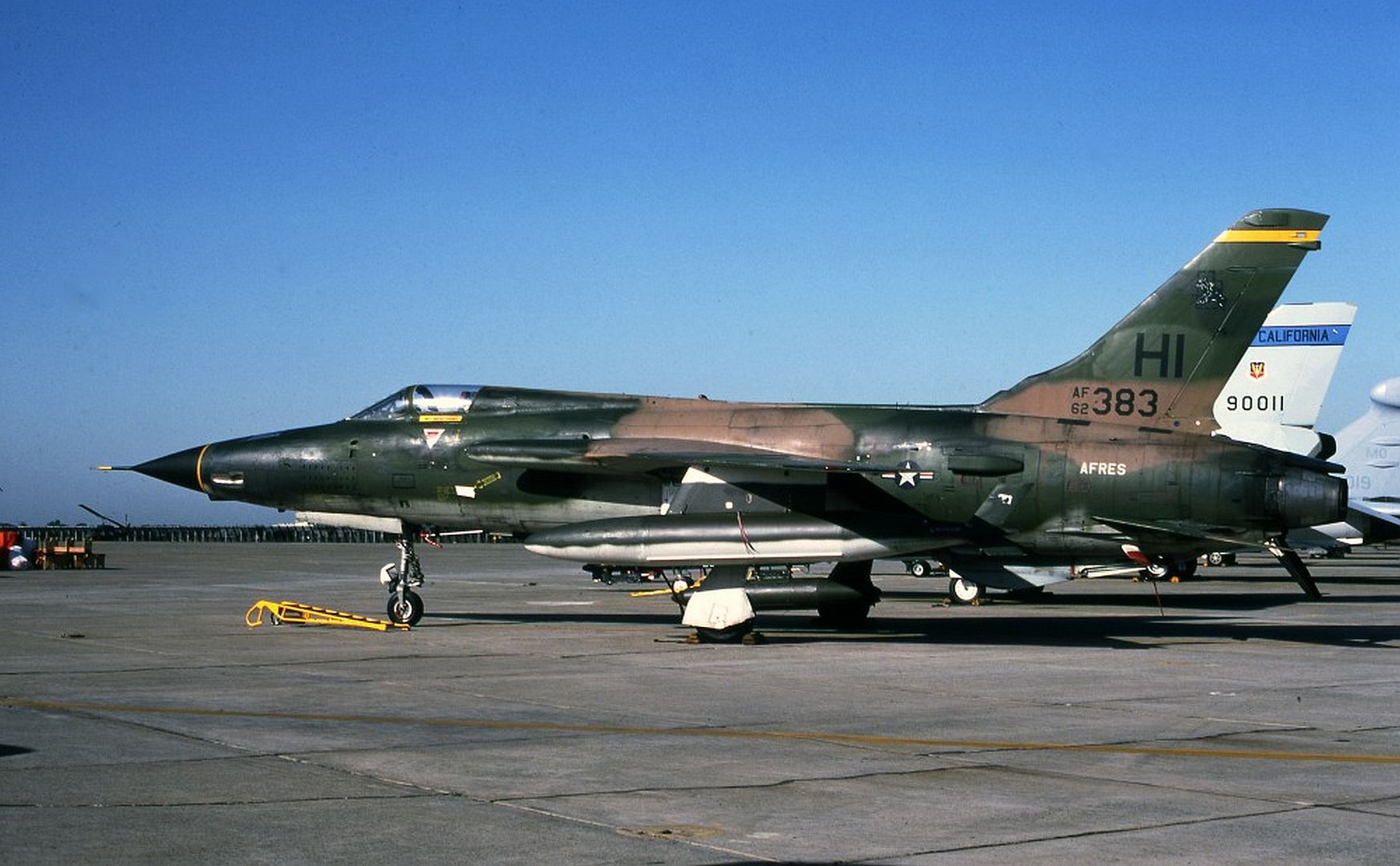
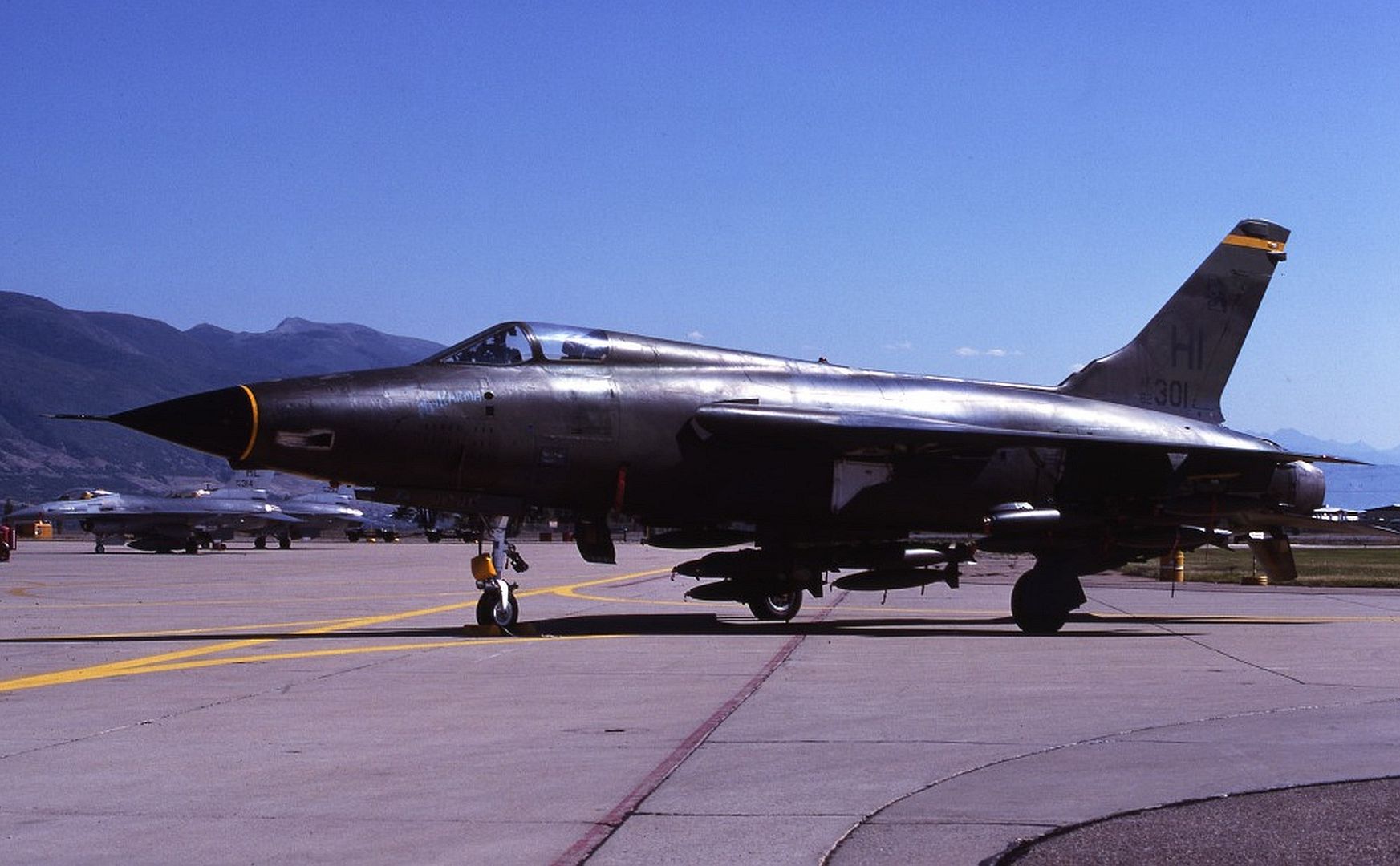
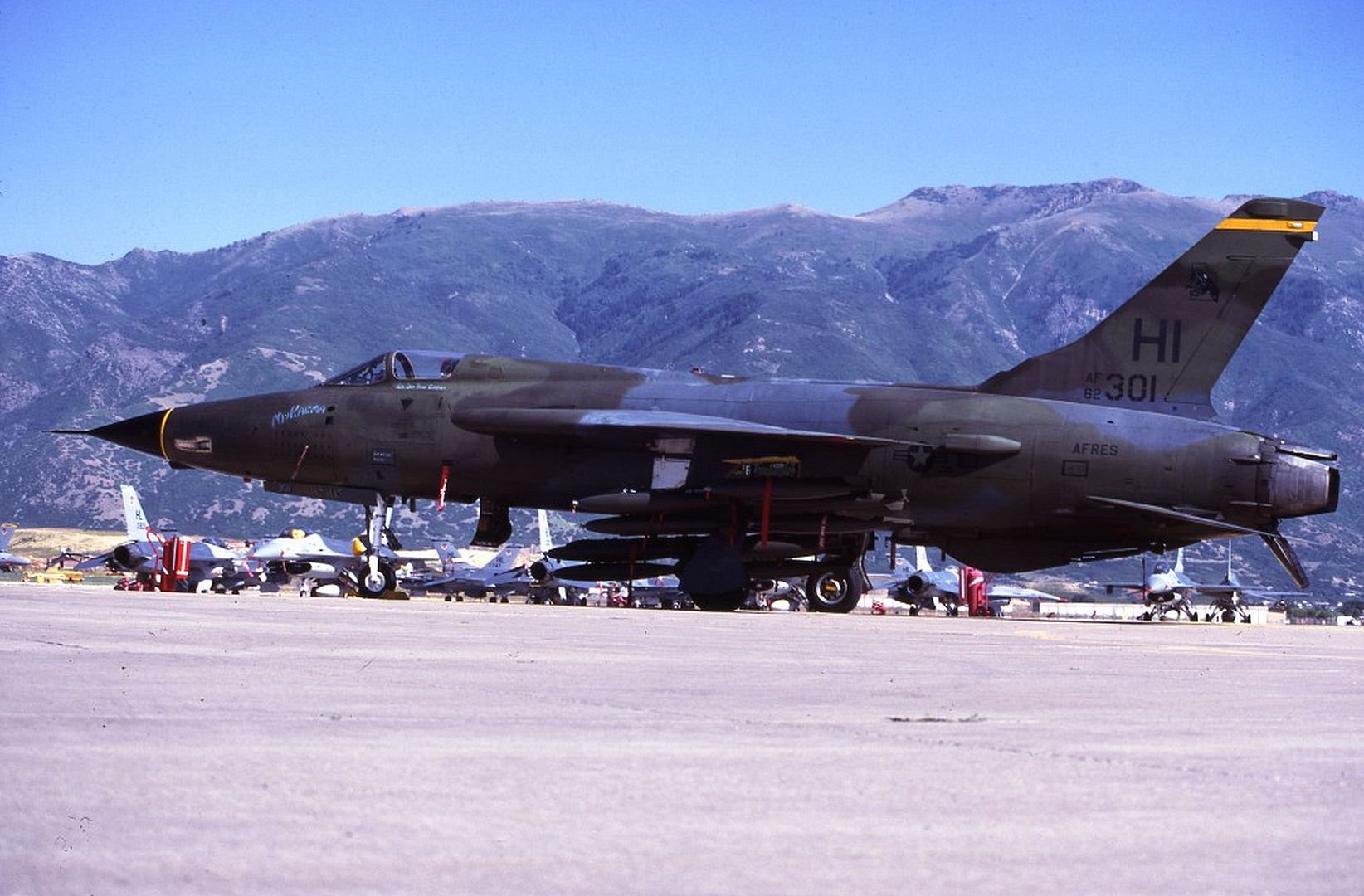

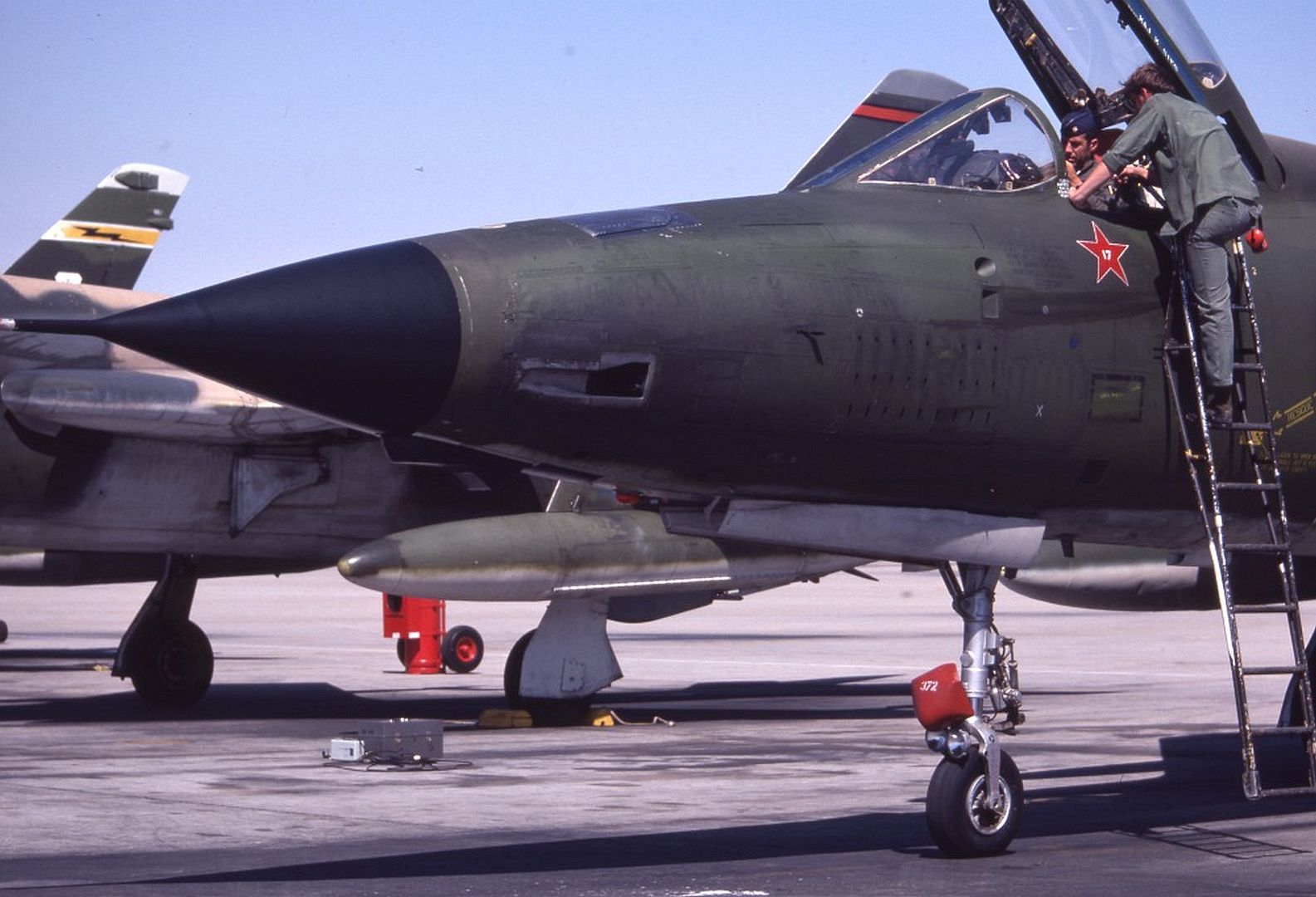
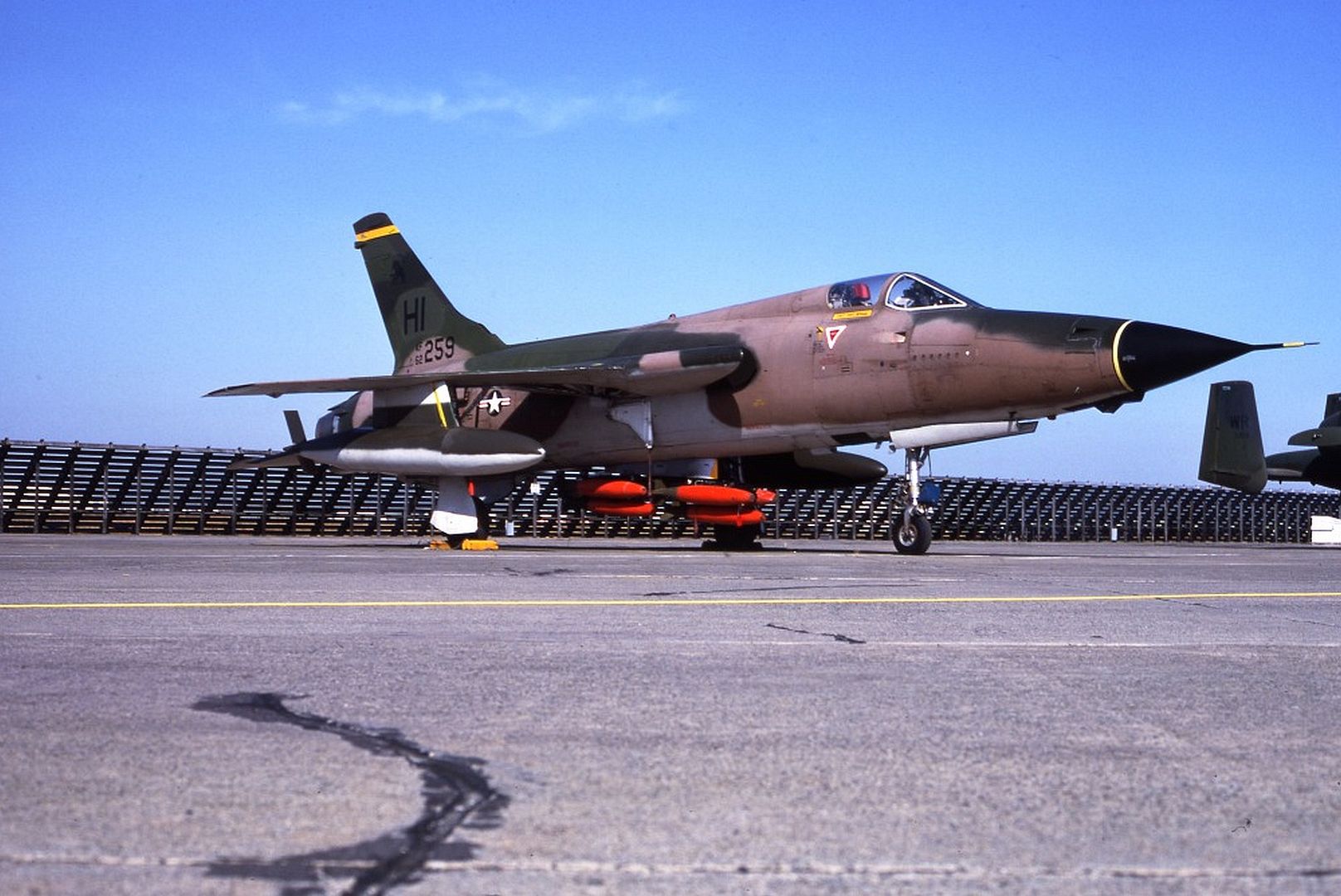
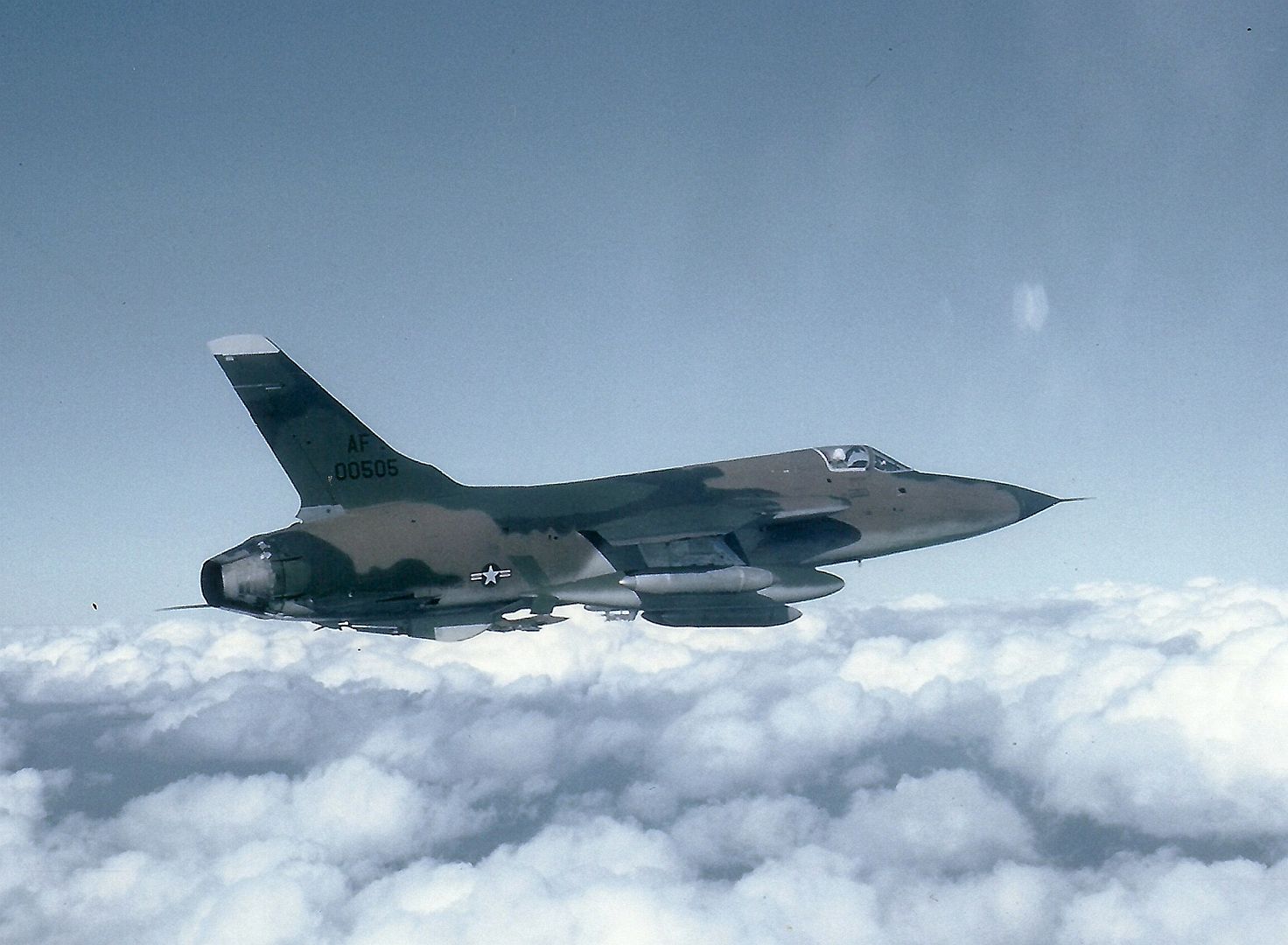

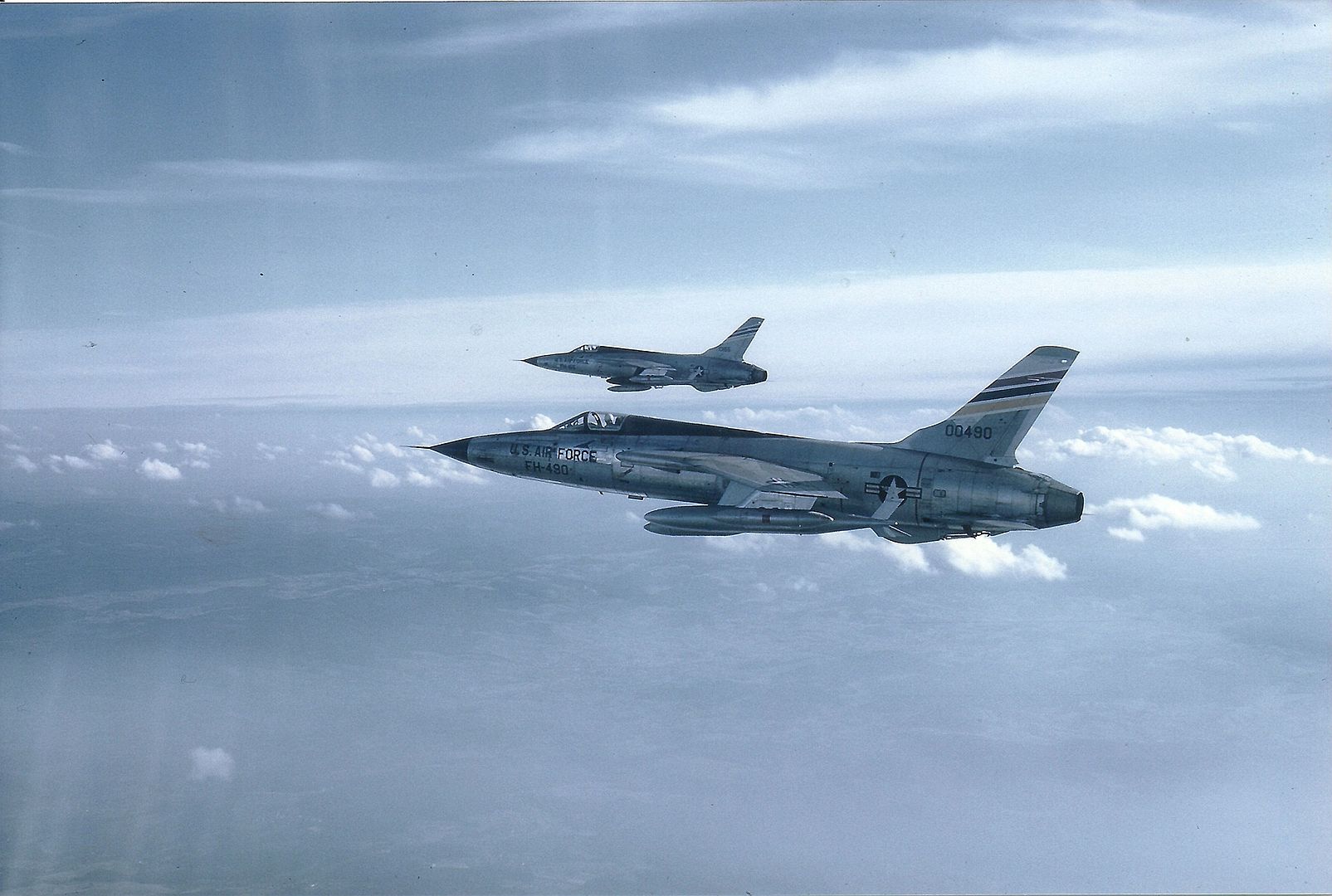
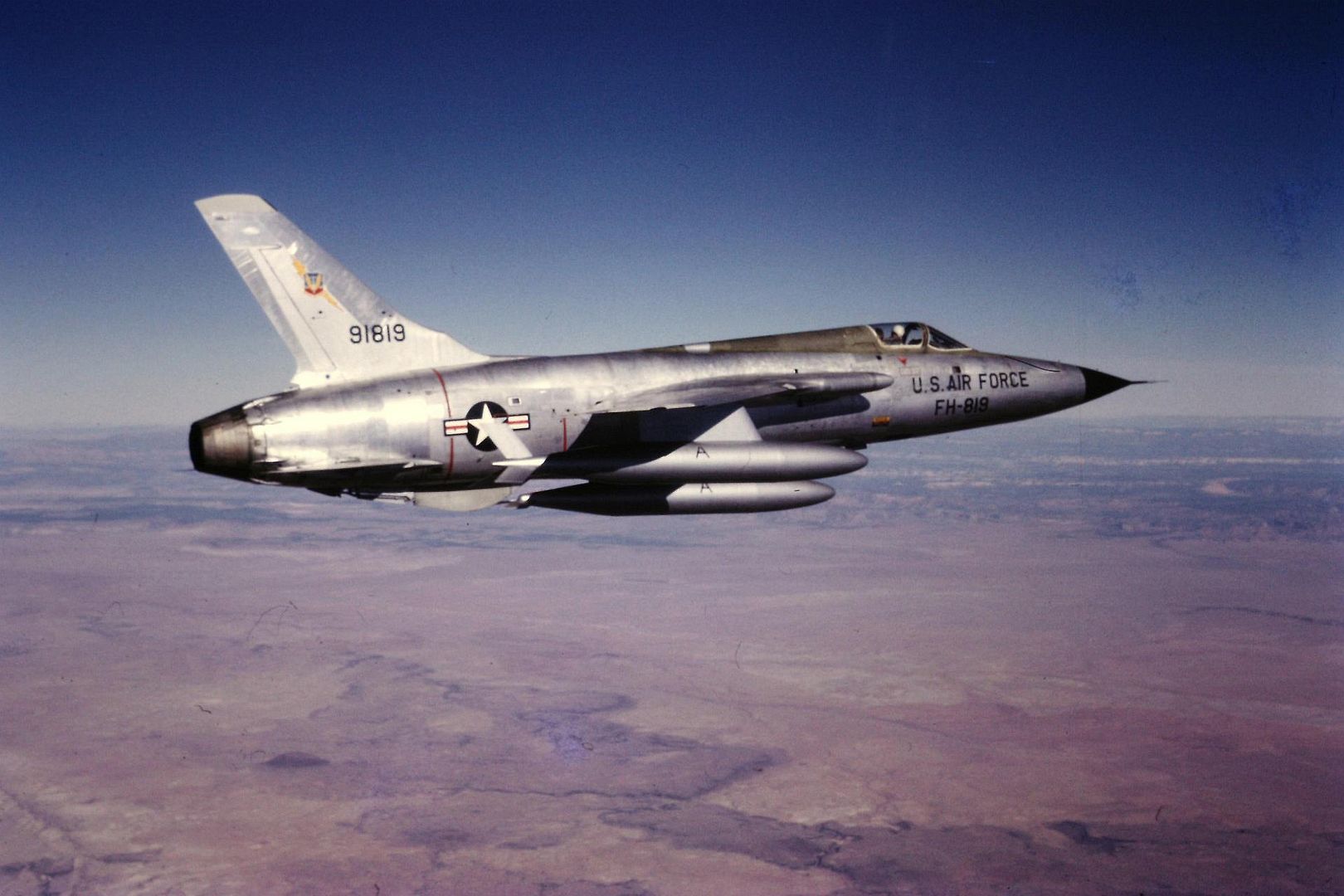

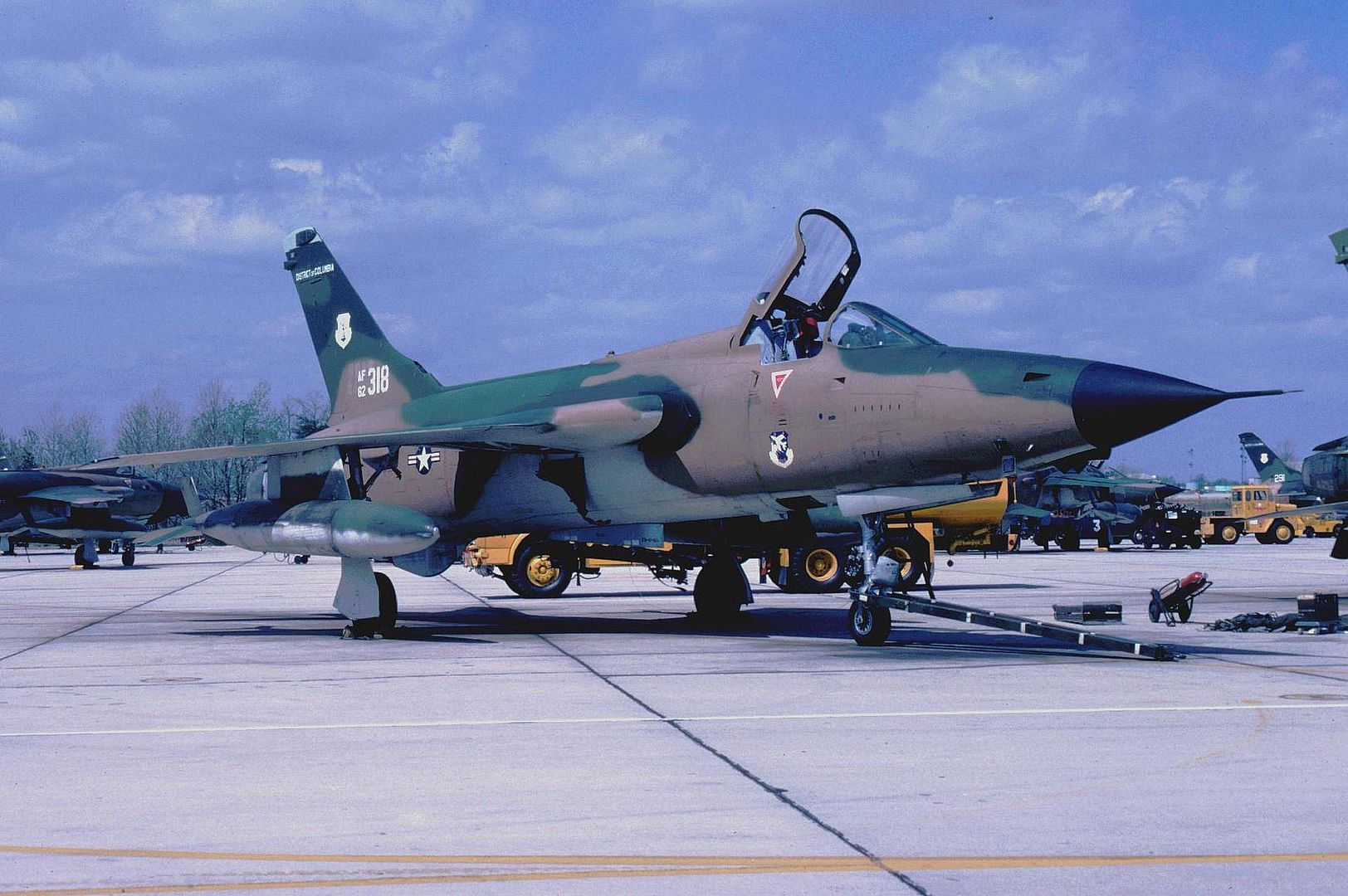

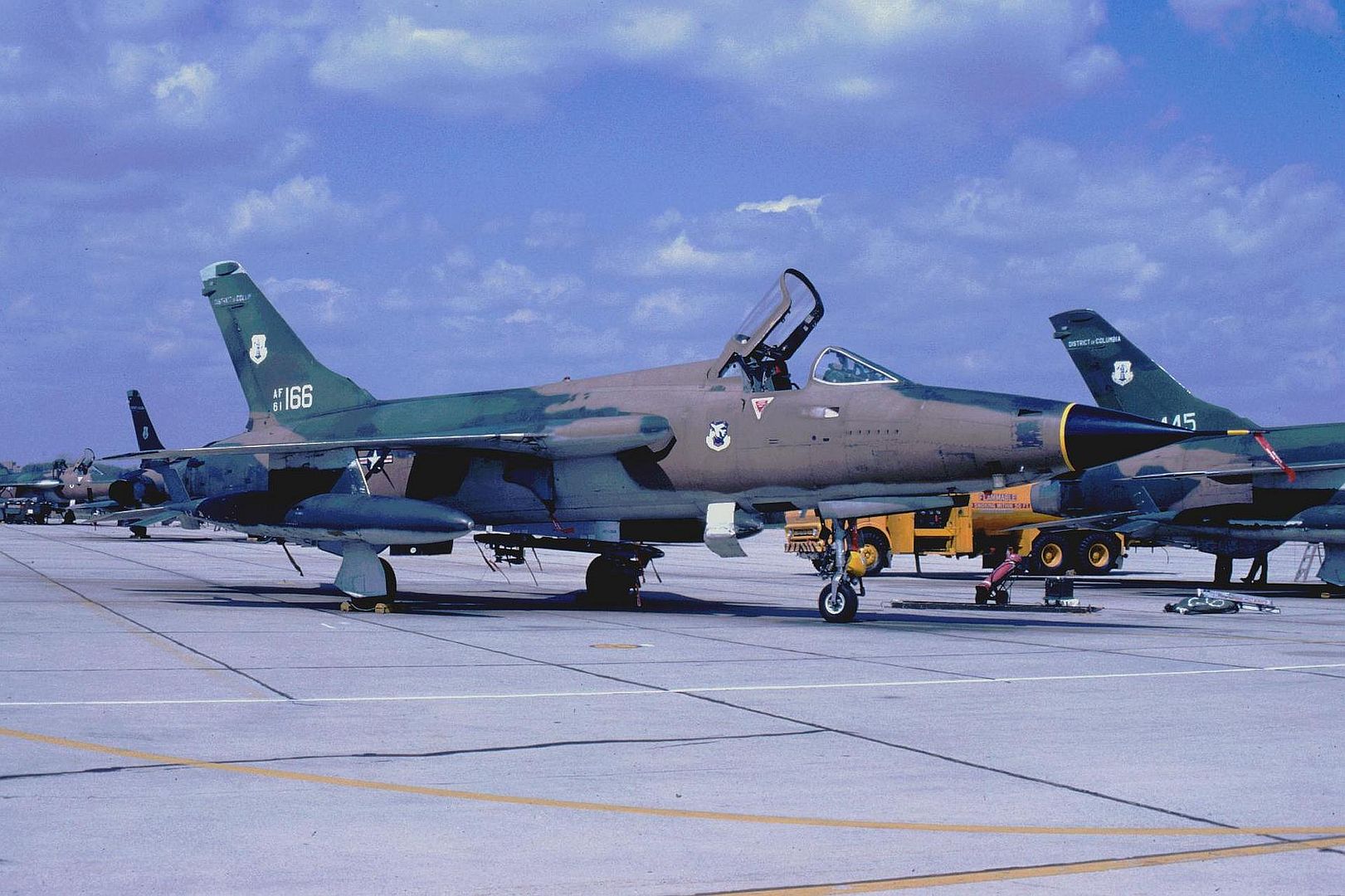
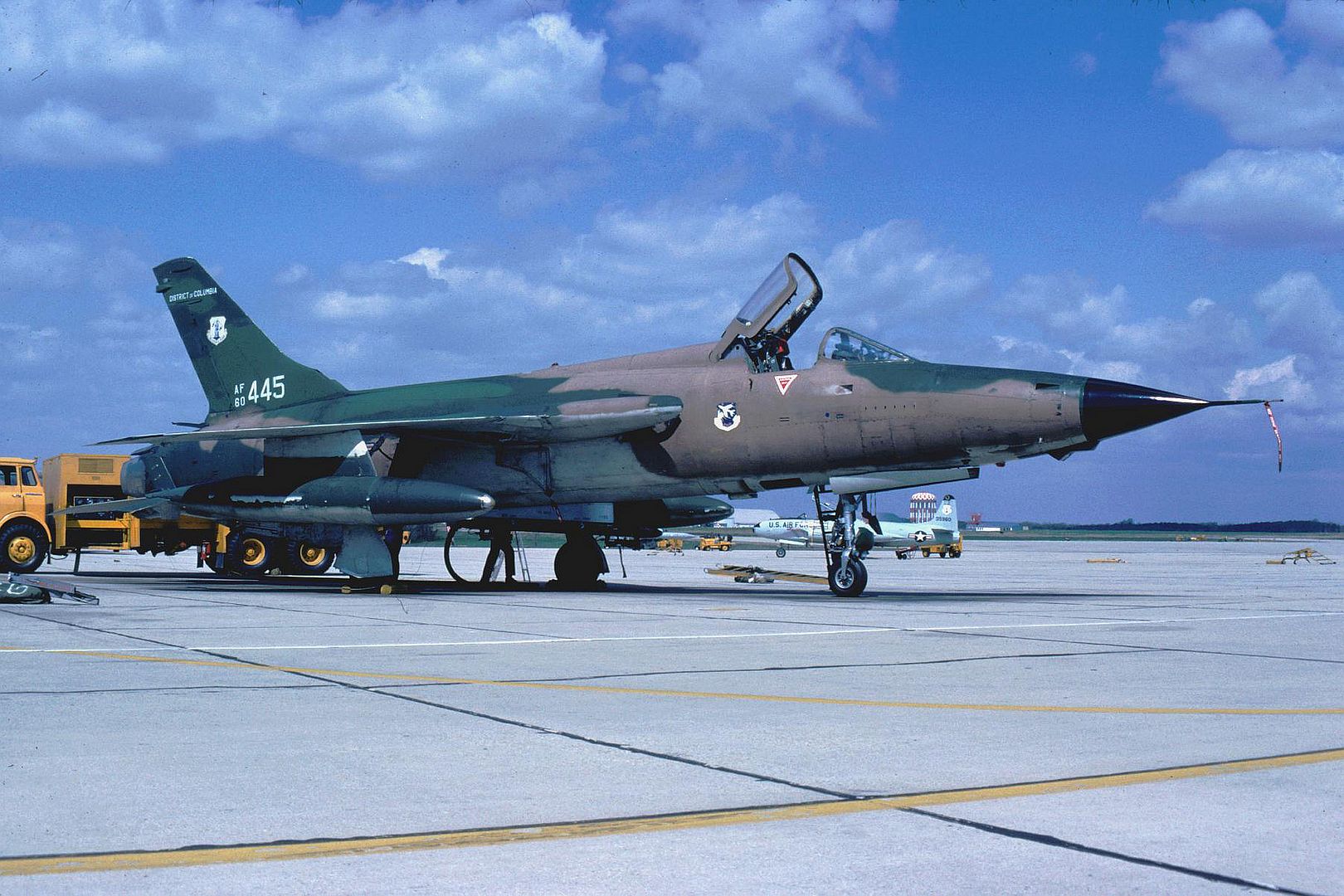
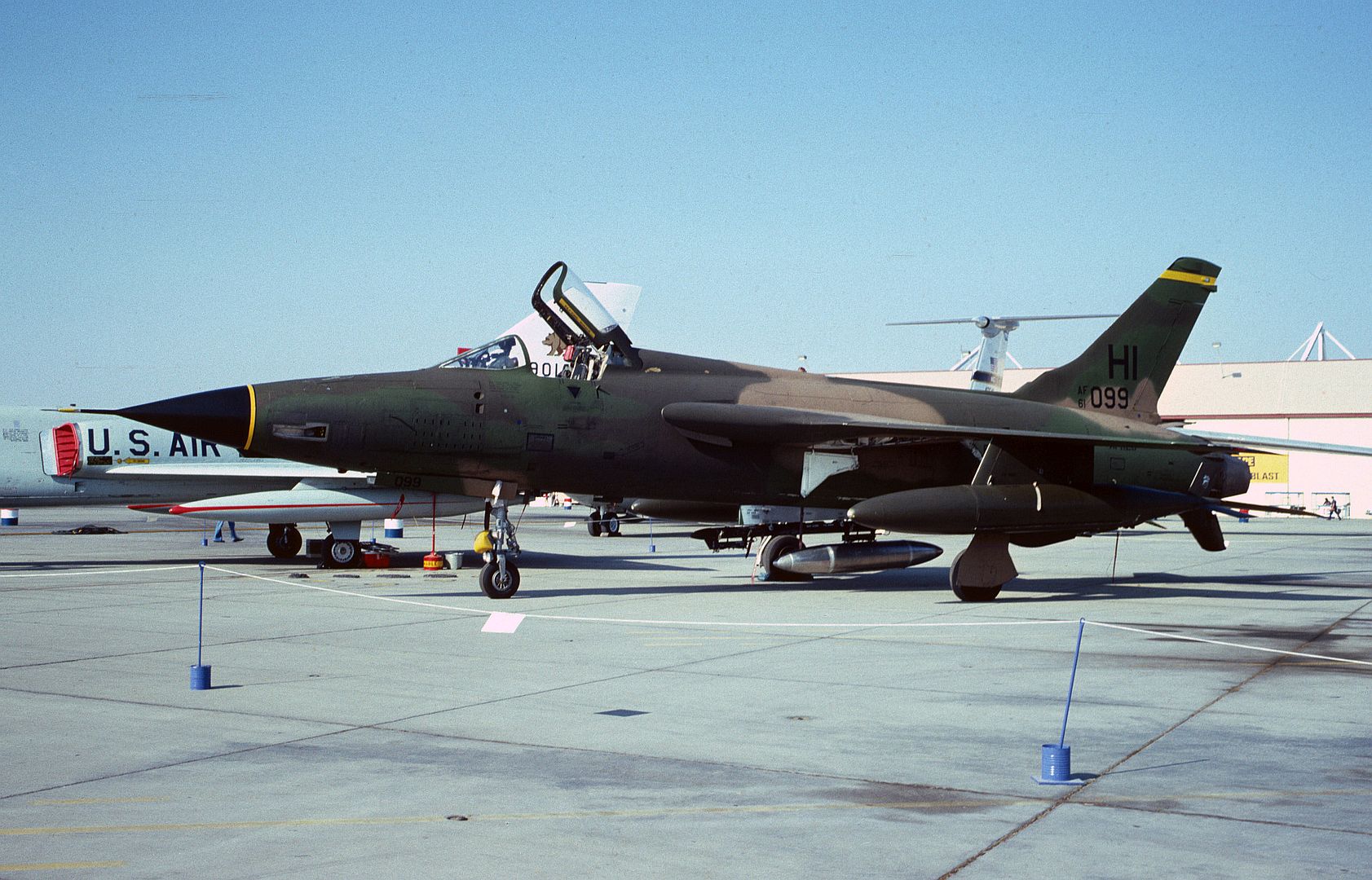


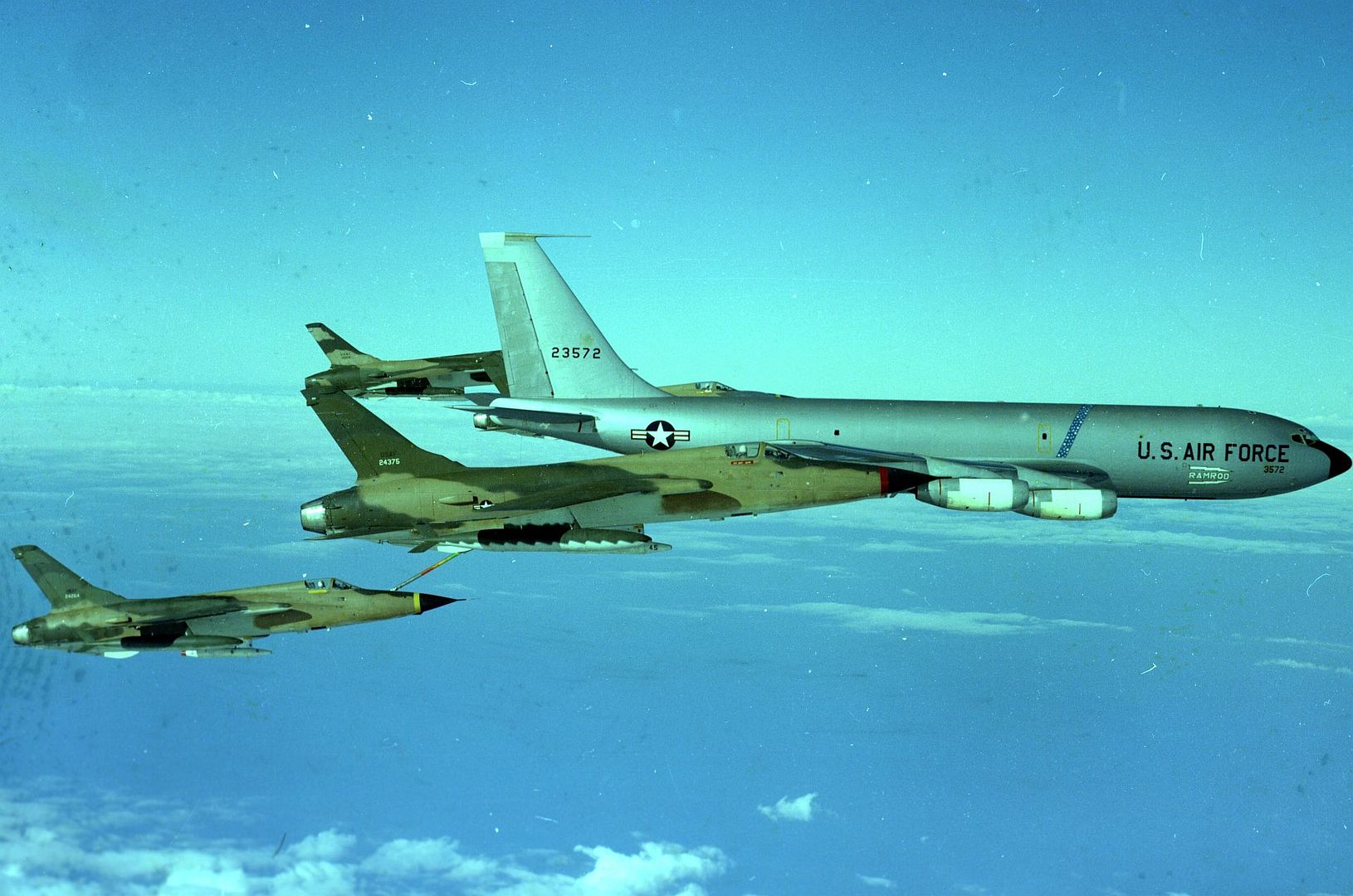
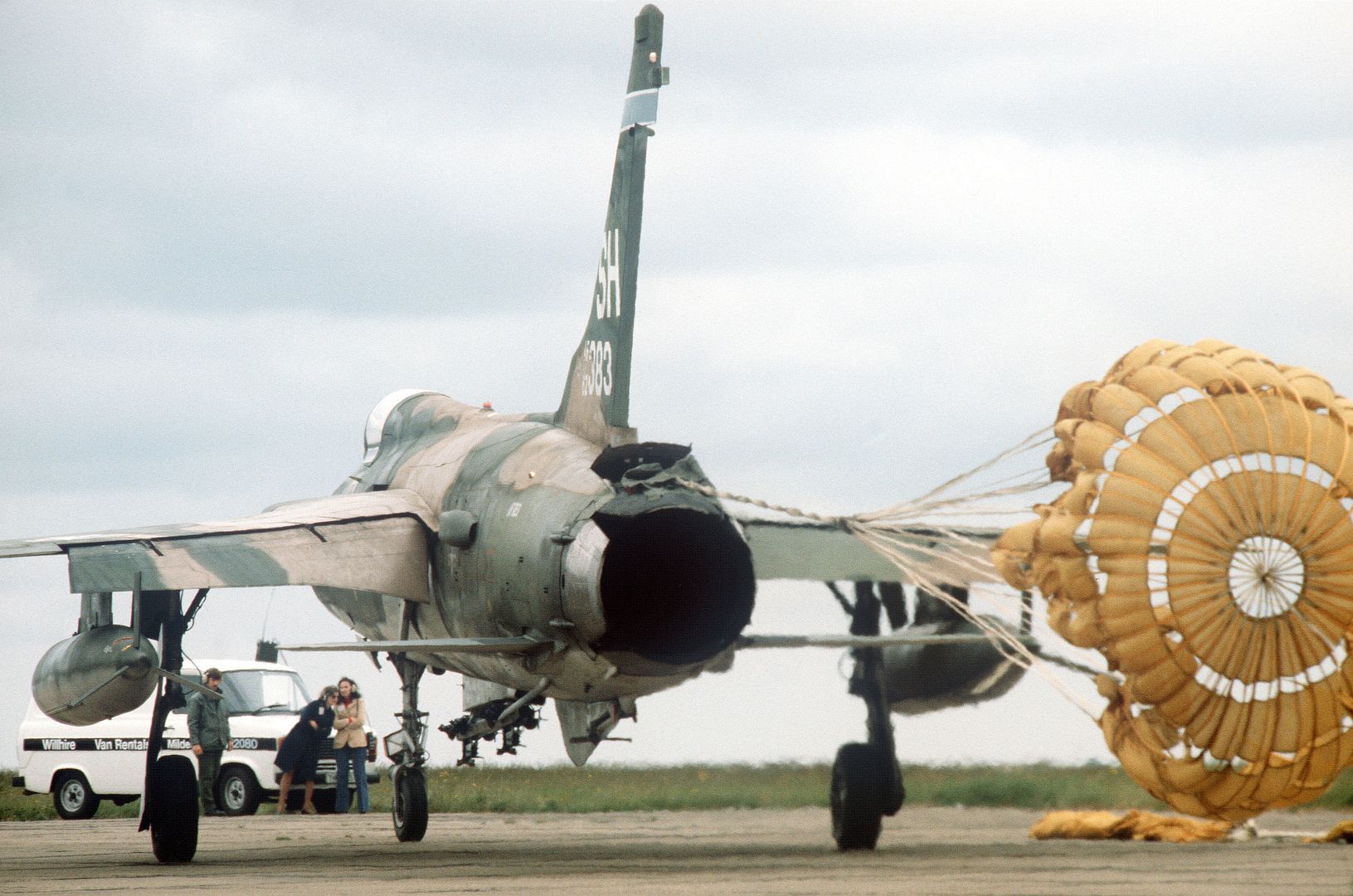
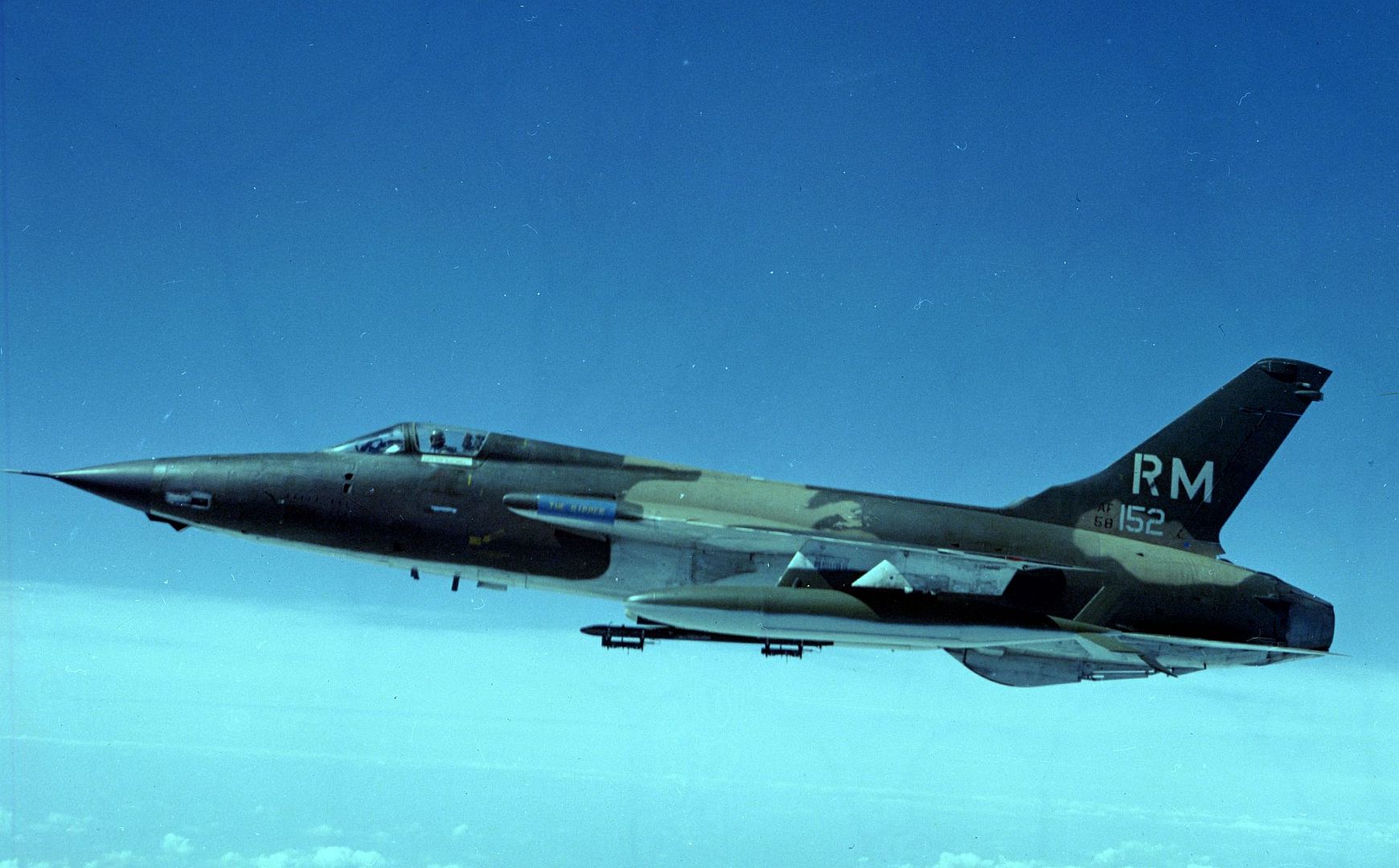
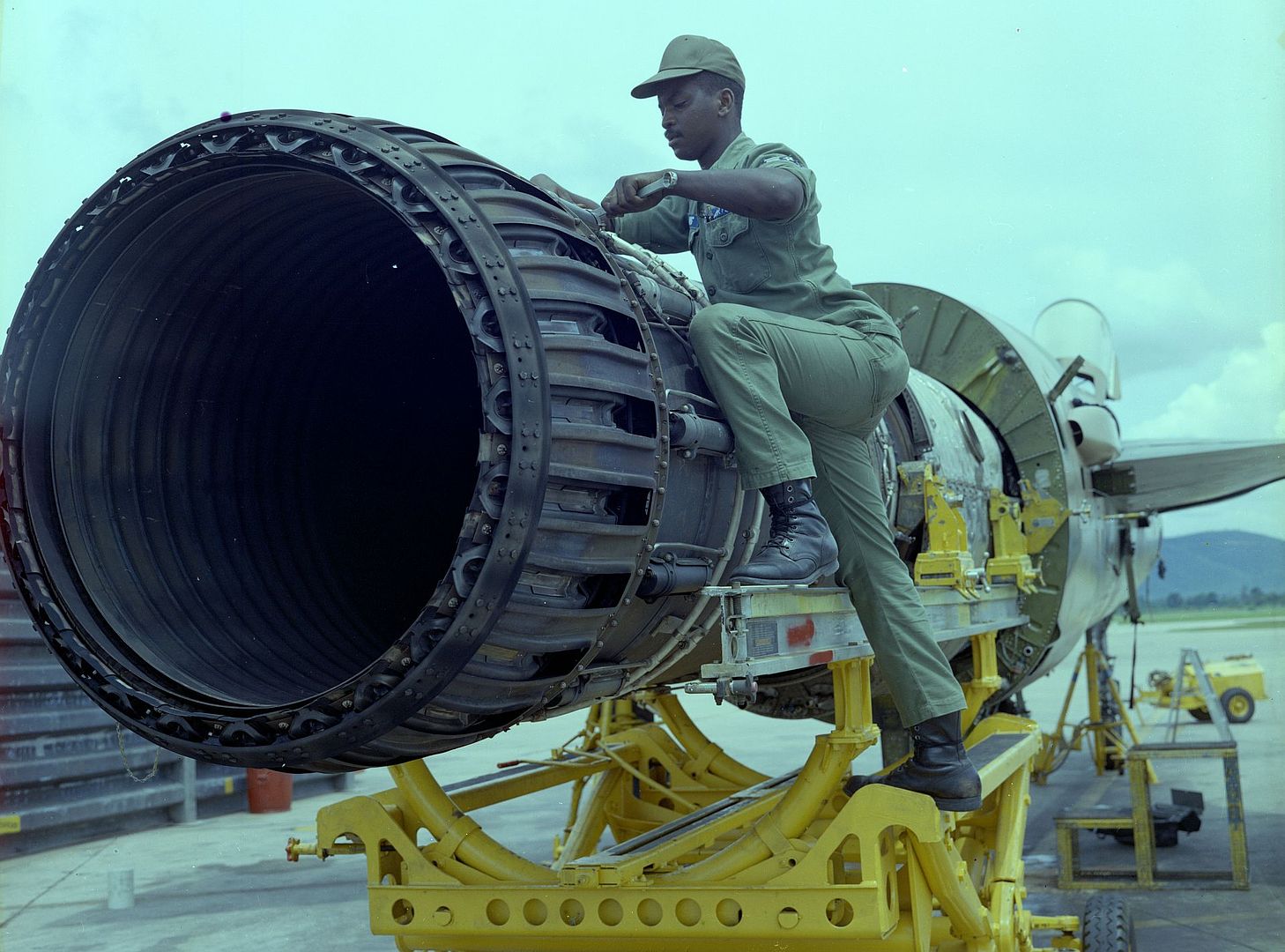
-
 Main AdminThe complexity of the bombing and navigation system of the single-seat F-105D left the Air Force in need of a two-seat training version for use in instructing new pilots in the use of these highly complex systems. The two-seat F-105C had originally been intended for this role, but its development had been terminated in 1957. A second two-seat version, the F-105E, based on the F-105D airframe but fitted with two tandem ejector seats underneath a single-piece bubble canopy, was cancelled in May of 1959 as being too expensive, freeing up funds for more F-105Ds. Nevertheless, the Air Force still perceived a need for a two-seat conversion trainer.
Main AdminThe complexity of the bombing and navigation system of the single-seat F-105D left the Air Force in need of a two-seat training version for use in instructing new pilots in the use of these highly complex systems. The two-seat F-105C had originally been intended for this role, but its development had been terminated in 1957. A second two-seat version, the F-105E, based on the F-105D airframe but fitted with two tandem ejector seats underneath a single-piece bubble canopy, was cancelled in May of 1959 as being too expensive, freeing up funds for more F-105Ds. Nevertheless, the Air Force still perceived a need for a two-seat conversion trainer.
The F-105F was the result. The F-105F was a minimal-change derivative of the F-105D, in which the two crew members were seated in tandem ejector seats underneath separate clamshell-type canopies. The cockpits were provided with dual controls. The rear cockpit was a virtual duplicate of the front cockpit (including a second R-14A radar scope), so the rear pilot could fly the mission even if the front pilot were incapacitated. A transfer system in the F-105F allowed each crew member to monitor or control all or any of the aircraft's subsystems.
The fuselage of the F-105F was about five feet longer than that of the F-105D and the tailfin and rudder were taller and larger in area. The F-105F was nearly 2000 pounds heavier than the F-105D, and it retained many of the features of the D, including the retractable midair refuelling probe. Although originally intended as an advanced trainer, the F-105F retained the full combat capability of the single-seat F-105D, including the all-weather R-14D radar system, the AN/ASG-19 Thunderstick fire control system, and the nuclear delivery mission. Externally, it had the same 5 hardpoints under the wings and the fuselage that the F-105D, and the internal weapons bay was of the same size. It had a performance that was within a couple of a percent of that of the F-105D.
The maiden flight of the first F-105D (62-4412) was on June 11, 1963. It reached a speed of Mach 1.15 on this flight. Service introduction was in December of 1963 with the 4520th Combat Crew Training Wing based at Nellis AFB and with the 4th Tactical Fighter Wing based at Seymour-Johnson AFB, where it flew alongside the F-105Ds already serving.
143 F-105Fs were built in the years 1963 to 1964. These aircraft were actually originally all ordered as single-seat F-105Ds, but before they could be built the Air Force specified that they be delivered as two-seat F-105Fs. No Thunderchiefs were actually procured as F-105Fs from the beginning.
The delivery of the last F-105F (63-8366) in January 1965 marked the end of Thunderchief production. In the early 1960s, Secretary of Defense Robert McNamara had sought to bring defense budgets under control by adopting joint service programs such as the F-111 TFX. It was decided to adapt the US Navy/Marine Corps F-4 Phantom as the Air Force's primary fighter-bomber, and the F-105 program was terminated. Later on in the 'sixties, the mounting losses of F-105s in combat over Vietnam led the Air Force to give some consideration to reopening the F-105 production line, but nothing ever came of the idea. The closing down of Thunderchief production marked the end of the line for Republic Aviation as a manufacturer of fighter aircraft.
Although the visibility from the rear cockpit was too limited to make the F-105F a practical conversion trainer, it was nevertheless a useful aircraft for check rides and in instructing new pilots in the use of the complex bombing and navigational equipment.
The F-105F is primarily remembered today for its role as a Wild Weasel aircraft, a type of aircraft originally designed for the suppression of North Vietnamese surface-to-air missile radar sites. When American bombing raids against North Vietnam began in 1964, combat losses of US aircraft began to mount alarmingly. Many of these losses were caused by the increasingly effective use by the North Vietnamese of radar-guided surface-to-air missiles. Someone in the USAF got the bright idea that the best way to defeat the surface-to-air missile threat would be to destroy or otherwise shut down their guidance radars, leaving enemy missile sites effectively blind and impotent. The project was given the name Wild Weasel, after the fierce little mammal which has a reputation of being so fearless that it pursues its prey into its very den.
The first Wild Weasel aircraft were North American F-100F Super Sabre two-seat fighter-bombers which were modified in 1965 for the role of identifying, marking, and attacking North Vietnamese SAM sites, particularly their radar installations. They were fitted with special equipment designed to detect enemy radar emissions and to determine the location of their transmitters. Once the sites were located and identified, fighter-bombers accompanying the F-100F aircraft would then attack the target with iron bombs. The F-100F Wild Weasel I program claimed credit for nine confirmed SAM radar kills. An undetermined number of other enemy radars were forced off the air as a result of Wild Weasel I activities.
After the F-100F two-seaters had proven the feasibility of the general concept, the same sort of adaptation was made to the vastly more capable F-105F two-seater. 86 F-105Fs were selected for modification as Wild Weasel III aircraft, which was over half the total F-105F production. These planes were known within the Air Force as EF-105F, but the official designation remained F-105F. The electronic weapons officer in the rear seat of the Wild Weasel F-105F operated a battery of sophisticated electronic equipment which was capable of detecting the emissions from enemy radars and determining the exact location of their sources. Once these sites were identified, the F-105F could attack them with a battery of AGM-45A Shrike antiradar missiles, which were designed to home in on an enemy radar transmission and follow it all the way to its source and destroy it. The Wild Weasel F-105F could also carry powerful jamming equipment which was designed to confuse the enemy radar installation or to misdirect any surface-to-air missiles that might be launched. Alternatively, the F-105F crew could direct other aircraft toward the missile sites, which would be attacked by iron bombs or cannon fire.
The first modified F-105F (62-4416) flew on January 15, 1966, and test and development work was completed in May. The first pilots and electronic warfare officers came from the F-100F Wild Weasel detachment, which was training at Eglin AFB in Florida. The first Wild Weasel F-105Fs left for Southeast Asia in June of 1966.
The first F-105F Wild Weasel III missions were flown in June 1966. In a typical mission, a Wild Weasel F-105F would accompany each flight of two or four F-105Ds. This helped to cut the loss rates of the single seaters tremendously. However, because of the nature of their missions, losses of the Wild Weasel F-105Fs were heavy, with five of the first eleven examples having been lost by the end of August.
North Vietnamese MiG-17 and MiG-21 fighters were also a menace, and many a bombed-up F-105D Thunderchief fell to the guns and missiles of these aircraft. In order to counter the MiG threat, a few F-105Fs were modified to carry Hallicrafters QRC-128 VHF jammers that were intended to block communications between MiG pilots and their ground controllers. The North Vietnamese were trained in Soviet tactics, which called for rigid ground control of airborne interceptors and permitted only limited pilot initiative. When communication was cut, tactics usually called for the MiG pilots immediately to return to base. The code name for this project was Combat Martin. Six of these planes were later returned to their original configuration and were eventually brought into the Wild Weasel III program.
Many targets in the North had to be attacked at night to reduce losses. Several F-105Fs were modified under the Commando Nail program with an improved R-14A radar with higher resolution which made it possible to achieve sharper target definition. In addition, the pilot's weapons release switch was modified to enable the rear seat pilot to control the bomb release. A better resolution scope was installed in the rear cockpit, and special cabin lighting was provided. Commando Nail F-105Fs operated by selected crews (Ryan's Raiders) from the 44th TFS at Korat flew numerous hazardous all-weather low-level bombing missions over North Vietnam, the first of these being on April 26, 1967. The Commando Nail F-105Fs were also used to develop tactics for the possible deployment of B-58 Hustlers to Southeast Asia. In the event, the four-engined supersonic bomber never did serve in the Vietnam conflict. Six of these Commando Nail F-105Fs were later returned to their original configurations and were brought into the Wild Weasel III program
Throughout the Southeast Asia War, the F-105F was repeatedly modified to meet changing conditions. They were equipped with armor plating, backup flight control systems, X-band beacons, new radar altimeters, and AN/ASG-19 Thunderstick gun bombsights which provided for automatic or manual and blind or visual weapons delivery, with automatic or manually-controlled weapons release. The pilot ejector seat was improved, and AN/APR-25(U)-26(V) radar homing and warning (RHAW) antennae were added to the tip of the vertical fin. Several F-105Fs were equipped with a combat camera mounted in a protrusion on the lower nose just behind the radome. Most F-105Fs were fitted in the field with ram air scoops on the rear fuselage to address an afterburner cooling problem which had resulted in some engine fires.
Although the last F-105D was withdrawn from Southeast Asia in October of 1970, the two-seat F-105F Wild Weasel remained in Southeast Asia until the end of US involvement in Vietnam. However, they were gradually replaced in their Wild Weasel role by the McDonnell F-4G Wild Weasel IV. Their final wartime role was as an escort for high-flying B-52s during the Linebacker I and Linebacker II operations, which culminated in the Christmas 1972 offensive against Hanoi that finally forced the North Vietnamese government to the conference table and ended the American involvement in the war.
The following Air Force units flew the F-105F:
18th Tactical Fighter Wing, Kadena AB
12th Tactical Fighter Squadron, 1968-? (Wild Weasel)
12th Tactical Fighter Squadron, Sept 1970-Nov 1970, detached to Korat RTAFB Ex F-105F from 355th TFW.
23rd Tactical Fighter Wing, McConnell AFB
561st Tactical Fighter Squadron, Det 1, Apr 72-Jun 72, Korat RTAFB. TDY with no wing assignment 7-72 to 12-72
563rd TFTS/TFS, July 1975-July 1977
4519th TFTS, Jan 68 to Oct 69.
35th Tactical Fighter Wing, George AFB
561st Tactical Fighter Squadron Det 1, Aug 1973-1980
562nd Tactical Fighter Squadron, Aug 1974-Dec 1980.
36th Tactical Fighter Wing, Bitburg AB, Germany
23rd Tactical Fighter Squadron
57th Fighter Weapons Wing, Nellis AFB
4537th Fighter Weapons Squadron, Feb 1966 to Oct 1971.
355th Tactical Fighter Wing, Tahkli RTAFB
333rd Tactical Fighter Squadron, Dec 1965 to Dec 1970. Wild Weasel from Nov 1968 to Dec 1970
357th Tactical Fighter Squadron, Jan 1966 to Dec 1970. Wild Weasel from Mar 1967 to Aug 1970
354th Tactical Fighter Squadron, Dec 1965 to Dec 1970 Wild Weasel from July 1966 to Apr 1971.
44th Tactical Fighter Squadron, Aug 66 to ? (Wild Weasel)
13th Tactical Fighter Squadron, Detachment 1 Wild Weasel May 1966 to Aug 1966 at Korat RTAFB (Wild Weasel)
388th Tactical Fighter Wing, Korat RTAFB
13th Tactical Fighter Squadron, May 1966 to ? (Wild Weasel)
17th WWS, Dec 1971-Oct 1974 (Ex 6010th WWS)
34th Tactical Fighter Squadron, Jan 68 to May 1969
44th Tactical Fighter Squadron, Apr 1967 to Oct 1969 Wild Weasel from Apr 1971
469th Tactical Fighter Squadron, Apr 1966 to Nov 1968.
6010th WWS Nov 1970 to DEc 1971. (Ex 12th TFS Det 1)
The following Air Force Reserve units operated the F-105F:
301st Tactical Figher Wing, Carswell AFB
457th Tactical Fighter Squadron, July 1972-Dec 1982.
607th Tactical Fighter Group, Tinker AFB
465th Tactical Fighter Squadron
Surviving F-105Fs from Vietnam were transferred to the Air National Guard as they were replaced in Air Force service by F-4Gs. In 1971, the Air National Guard received its first 8 F-105Fs. By mid-1973, only 17 F-105Fs remained in service, 5 with the Air Force and 12 with the ANG. Several examples served with the 508th TFG and with the Georgia Air National Guard until 1981, when the last Thunderchiefs were finally retired.
The following Air National Guard units operated the F-105F:
184th Tactical Fighter Group, Kansas ANG
127th Tactical Fighter Squadron
116th Tactical Fighter Wing, Georgia ANG
128th Tactical Fighter Squadron, Aug 1979 to Aug 1983
Serials of the F-105F:
62-4412/4447 Republic F-105F Thunderchief
63-8260/8366 Republic F-105F Thunderchief
Specification of the F-105F Thunderchief:
Engine: One Pratt & Whitney J75-P-19W turbojet, rated at 17,200 lb.s.t. dry and 26,500 lb.s.t. with afterburner. Performance: Maximum speed: 1386 mph at 38,000 feet (Mach 2.1), 876 mph at sea level (Mach 1.15). Initial climb rate was 34,500 feet per minute (at 39,350 pounds). Combat radius was 740 miles with 8 750-pound bombs. Fuel: Total internal fuel capacity was 1160 US gallons in seven tanks (including 25 gallons in the fuel lines). The internal weapons bay can accommodate a 390-US gallon fuel tank in place of the "special store". The fuel load could be further augmented by two 450 US-gallon drop tanks on the inner underwing pylons and an additional 450 or 600 US gallon drop tank carried on a pylon underneath the fuselage, bringing total maximum fuel capacity to 3100 US gallons. Dimensions: wingspan 34 feet 11 1/4 inches, length 69 feet 7 1/3 inches, height 20 feet 2 inches, wing area 385 square feet. Weights: 40,073 pounds loaded (clean), 54,027 pounds maximum takeoff. Armament: Armed with one 20-mm M61A1 rotary cannon with 1029 rounds. Up to 8,000 pounds of ordinance could be carried in the internal weapons bay. In addition, a further 6000 pounds of ordinance could be carried on external weapons racks (four underneath the wings, one underneath the fuselage). Typical weapons load include 16 750-pound bombs, 9 LAU-3/A or LAU-18/A rocket pods, or four AIM-9B Sidewinder infrared homing missiles in the intercept role.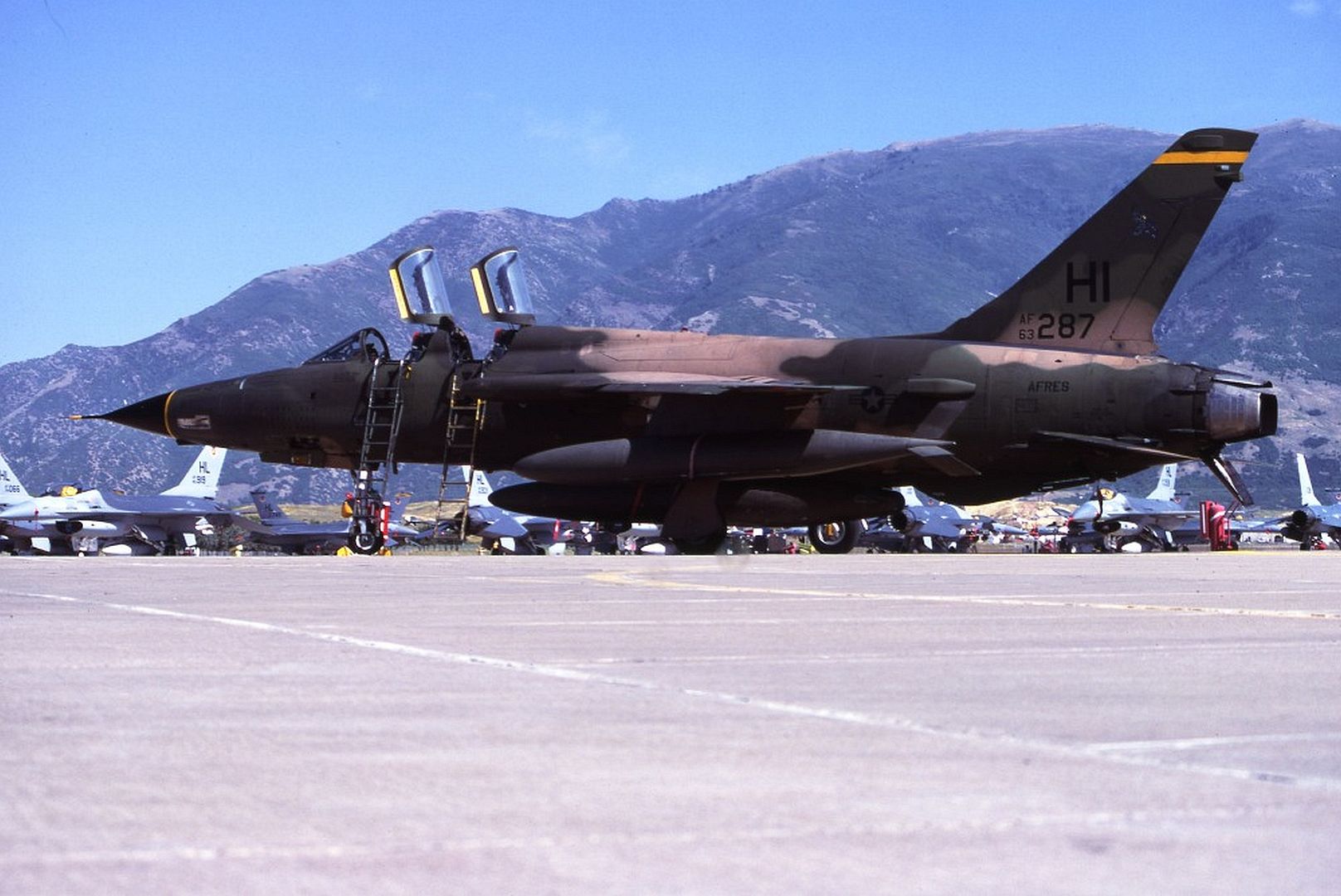

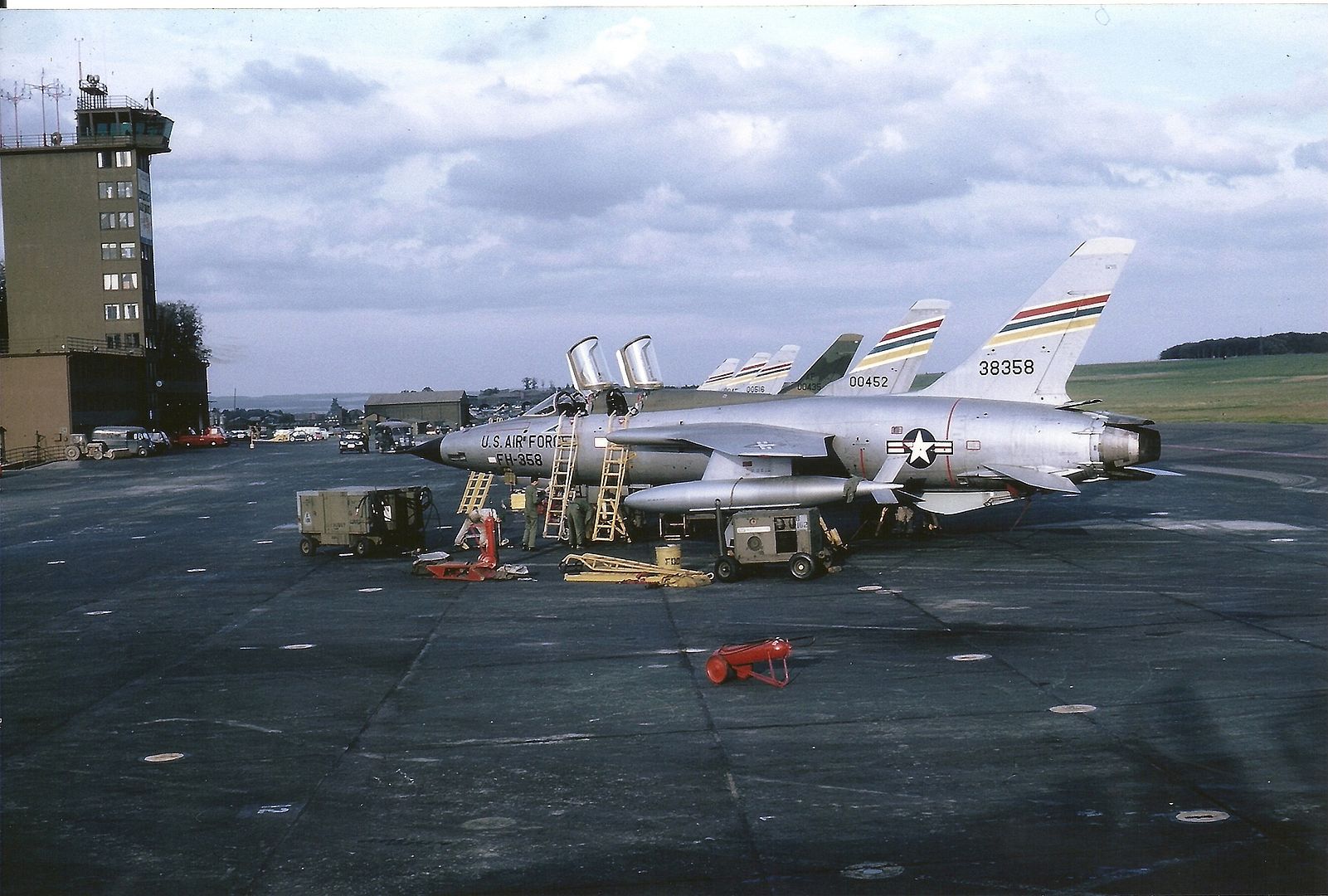

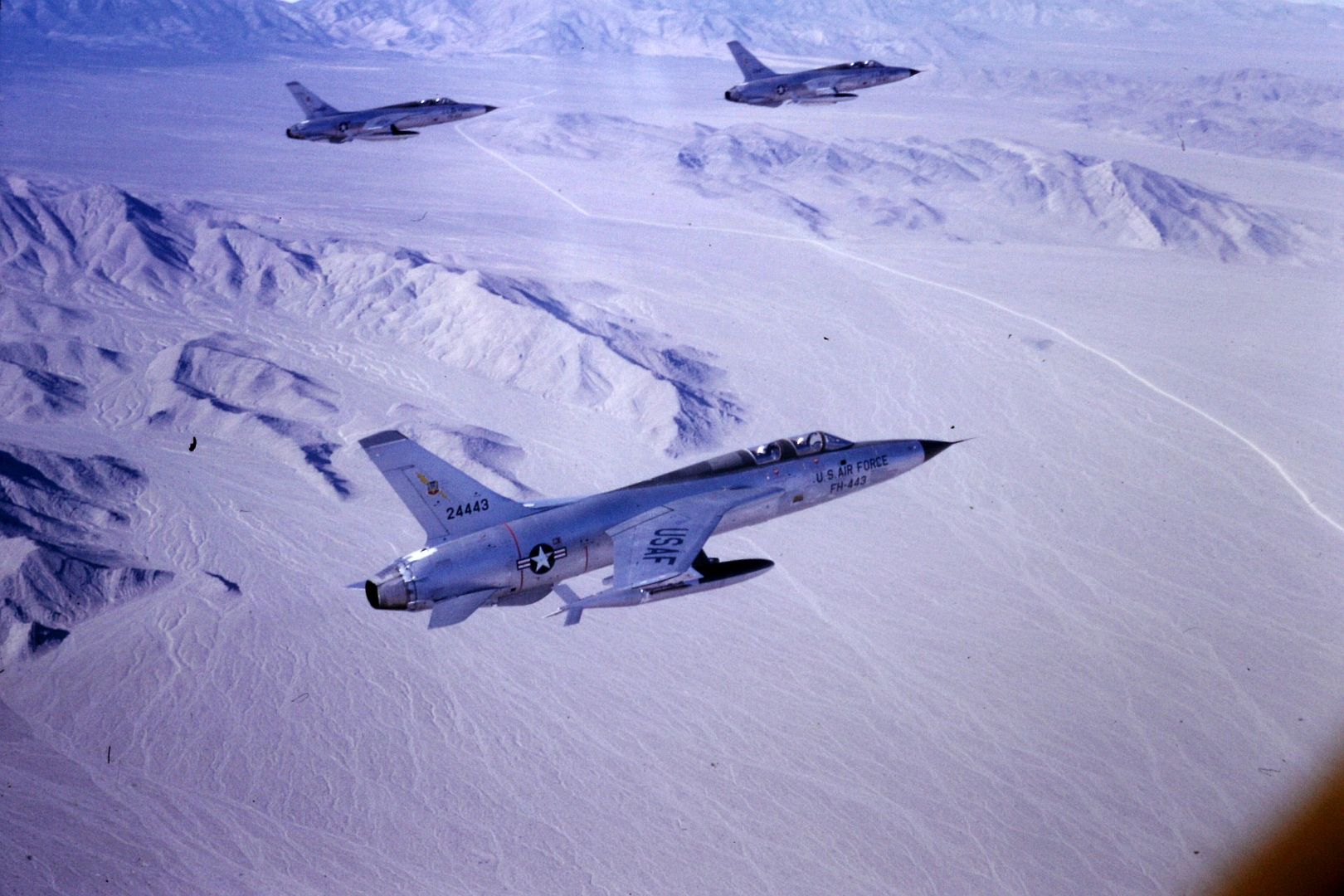
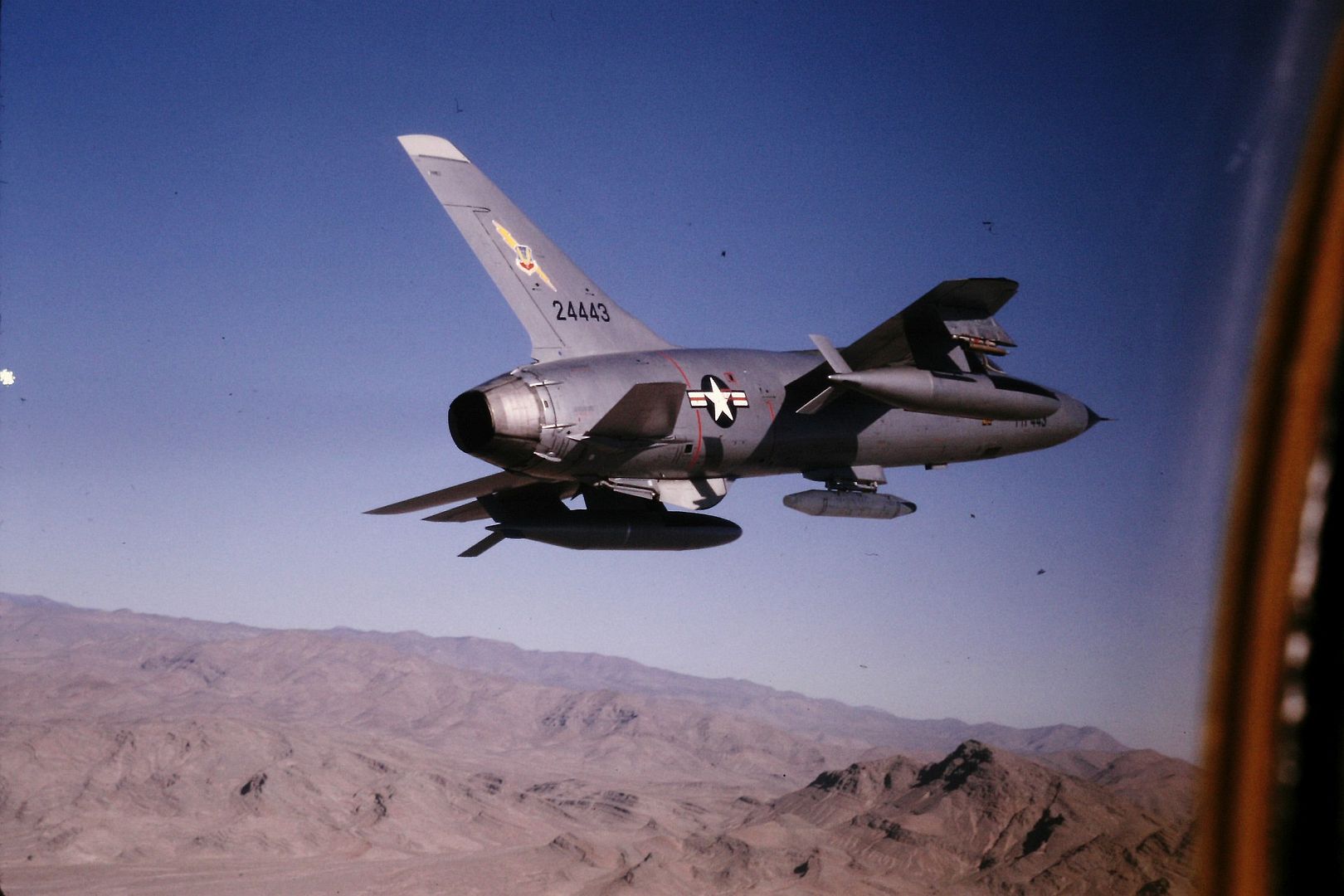
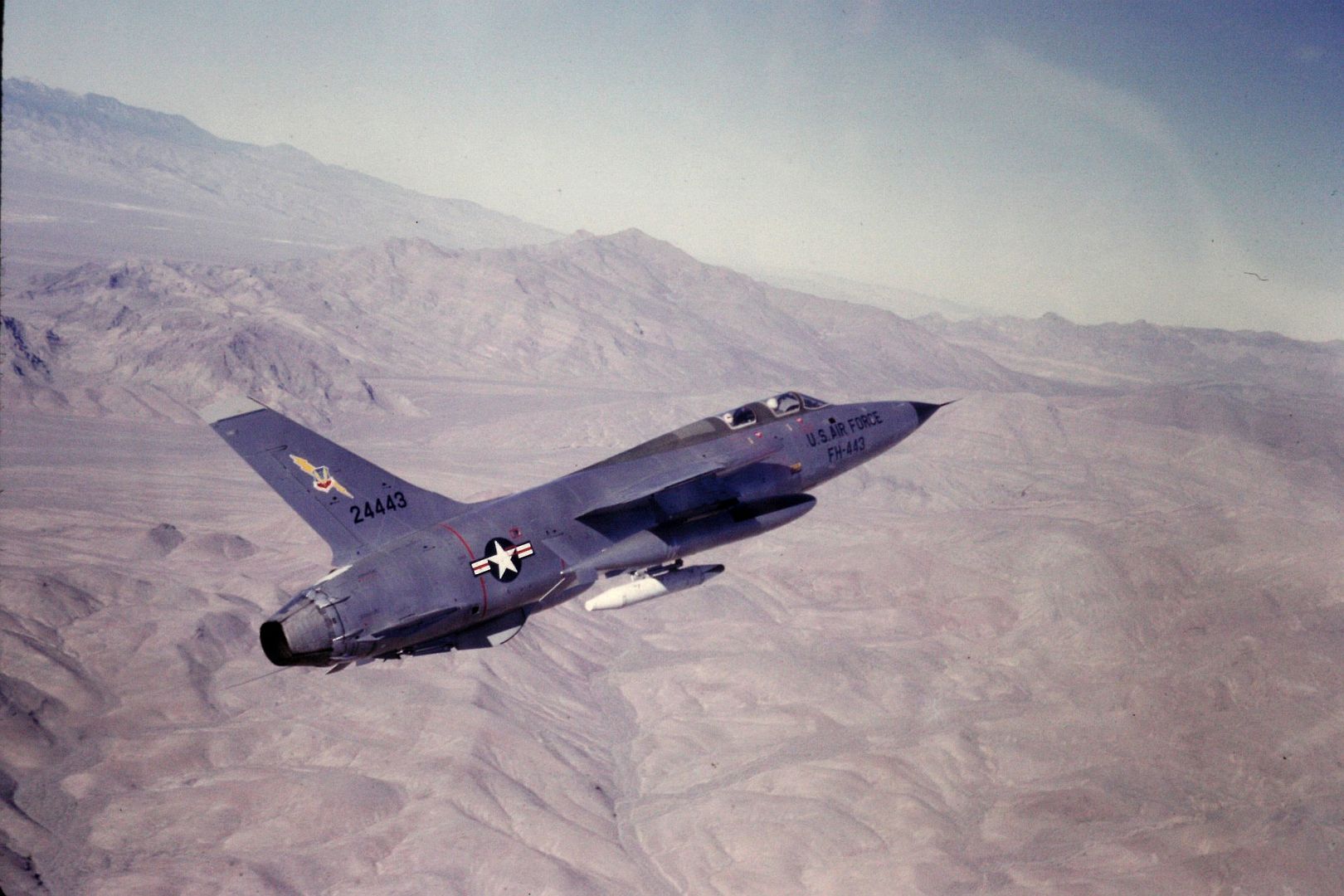

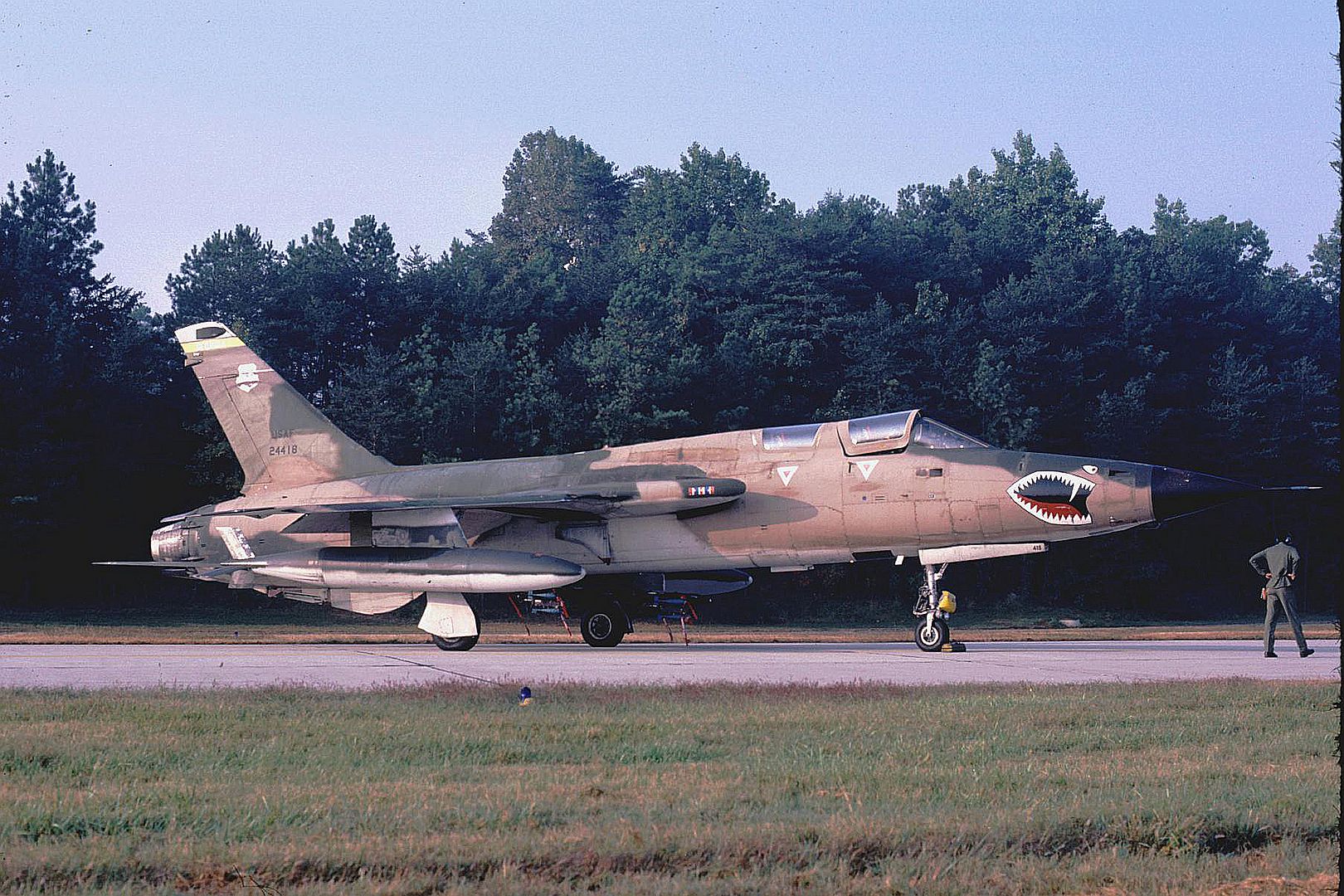

-
 Main AdminThe F-105G was the designation given to Wild Weasel F-105Fs which were fitted with greatly improved avionics. The designation EF-105F was temporarily applied to these aircraft, but their designation was eventually changed to F-105G.
Main AdminThe F-105G was the designation given to Wild Weasel F-105Fs which were fitted with greatly improved avionics. The designation EF-105F was temporarily applied to these aircraft, but their designation was eventually changed to F-105G.
The F-105G was fitted with the AN/APR-35, AN/APR-36, AN/APR-37, and AN/ALR-31 Radar Homing and Warning (RHAW) systems. Installation of the AN/ALR-31 required that the wingtips be redesigned, in which a pair of antennas took the place of the navigational lights, which were moved to the leading edge of the wingtip. In addition, the Itek APR-36 radar homing and warning system of Wild Weasel F-105Fs was replaced by the Itek Radar Direction Finding and Homing system, and the Bendix APS-107 target acquisition set was installed. The F-105G also carried extra sensing antennae on the nose. Among these were four triangular-shaped antennae located on the nose just behind the main radome. Most F-105Gs were fitted with a combat camera mounted in a protrusion fitted underneath the nose just behind the radome.
The F-105G was also fitted with two long, cylindrical blisters for internally-mounted self-protection jammers that were faired into the sides of the lower fuselage. This freed up the outer underwing pylons that were usually used to carry noise jamming pods such as the Hughes ALQ-71 or General Electric ALQ-87 so that they could now carry additional ordnance such as more Shrikes. These blisters carried the Westinghouse AN/ALQ-105 electronic countermeasures jamming transmitters. A cooling scoop for the associated electronics was mounted on the fuselage belly just ahead of the weapons bay.
It is often said that the presence of the side blisters is what distinguished an F-105G from and F-105F. However, it is more correct to say that it is the presence of the AN/ALR-31 RHAW set that distinguished a F-105G from an F-105F. The presence of this new set could be demonstrated by the presence of wingtip sensors that displaced the aircraft's navigation lights, which were moved further forward on the wing leading edges. About 14 early F-105Gs were were fitted initially with the AN/ALR-31 system but without side blisters. In addition, some F-105Fs were modified with side blisters prior to being brought up to F-105G standards (e. g. being retrofitted with AN/APR-35 and APS-107) while others received ALQ-105 and AGM-78 capability simultaneously.
Fourteen of the F-105Gs were further modified to carry and launch the General Dynamics AGM-78A Standard ARM ModO anti-radar missile. The Standard was an anti-radiation missile designed to have a higher performance, longer range, and larger warhead that that of the Shrike, which was at that time giving indifferent results in the SouthEast Asian war. It was based on the Standard RIM-66A ship-based surface-to-air missile, and fitted with a seeker head from the AGM-45 Shrike. It flies on a dual-thrust motor and steers with tail controls and very low aspect ratio fixed wings. The missile was 180 inches long, had a wingspan of 43 inches, and had a diameter of 13.5 inches. Launch weight was about 1400 pounds, maximum speed was Mach 2.5, and range was up to 35 miles. The Mod0 was fitted with the T1 seeker used by the Shrike, but this was replaced by the Maxson broad-band seeker of the main(Mod1) production version, the AGM-78B. This seeker is designed to attack search, GCI, SAM and other radar systems and is intended to enable the launching aircraft to attack from any direction and to turn away and get outside the lethal radius of enemy SAMs. In addition, later variants of the Standard could continue unerringly toward its target even if the enemy radar was switched off, having had placed in its computer memory the precise coordinates of the target before launch. Between November 1968 and June 1969, another 16 F-105Gs were modified to launch the AGM-78B. The Standard was so large and heavy that a special heavy-duty underwing pylon had to be developed to carry the missile. The Standard was typically carried underneath the inboard underwing pylons or underneath the centerline pylon. Sometimes, both Standards and Shrikes were carried, with the smaller Shrike being carried on the outboard underwing pylons.
Because of the additional electronic equipment, the F-105G had a slightly smaller internal fuel capacity than the F-105F. Total internal fuel capacity was 1051 US gallons, as compared to 1160 US gallons for the F-105F.
The first F-105Gs went to the 357th TFS of the 355th TFW based at Tahkli RTAFB during the second half of 1967. The 12th Tactical Fighter squadron of the 18th Tactical Fighter Wing, which had been detached to Korat RTAFB from Okinawa, was also equipped with the F-105G. Also provided with the G was the 17th WWS and the 6010th WWS (Ex 1th TFS Detachment 1), both from the 388th TFW based at Korat RTAFB. Unlike the single-seat F-105Ds which had been withdrawn from Southeast Asia in 1970, the F-105Gs remained in Vietnam until the end of US involvement in that unhappy conflict.
Following the US withdrawal from Vietnam, two F-105G squadrons (the 561st and 562nd) served with TAC's 35th TFW at George AFB until they were replaced by F-4Gs in 1980. This marked the end of Thunderchief service with the USAF. The surviving F-105Gs were passed on to the 128th TFW of the Georgia Air National Guard, which operated them until 1983.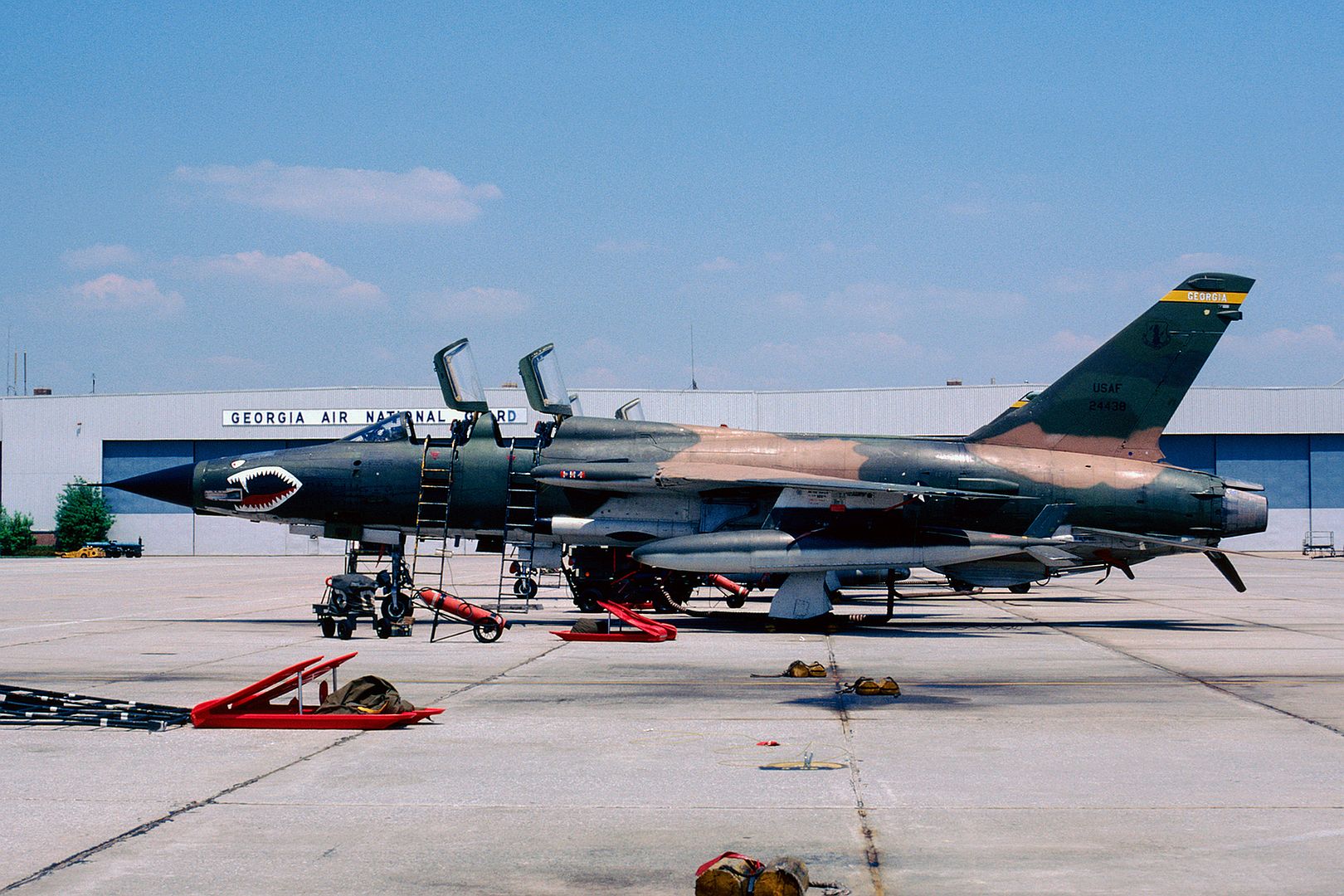
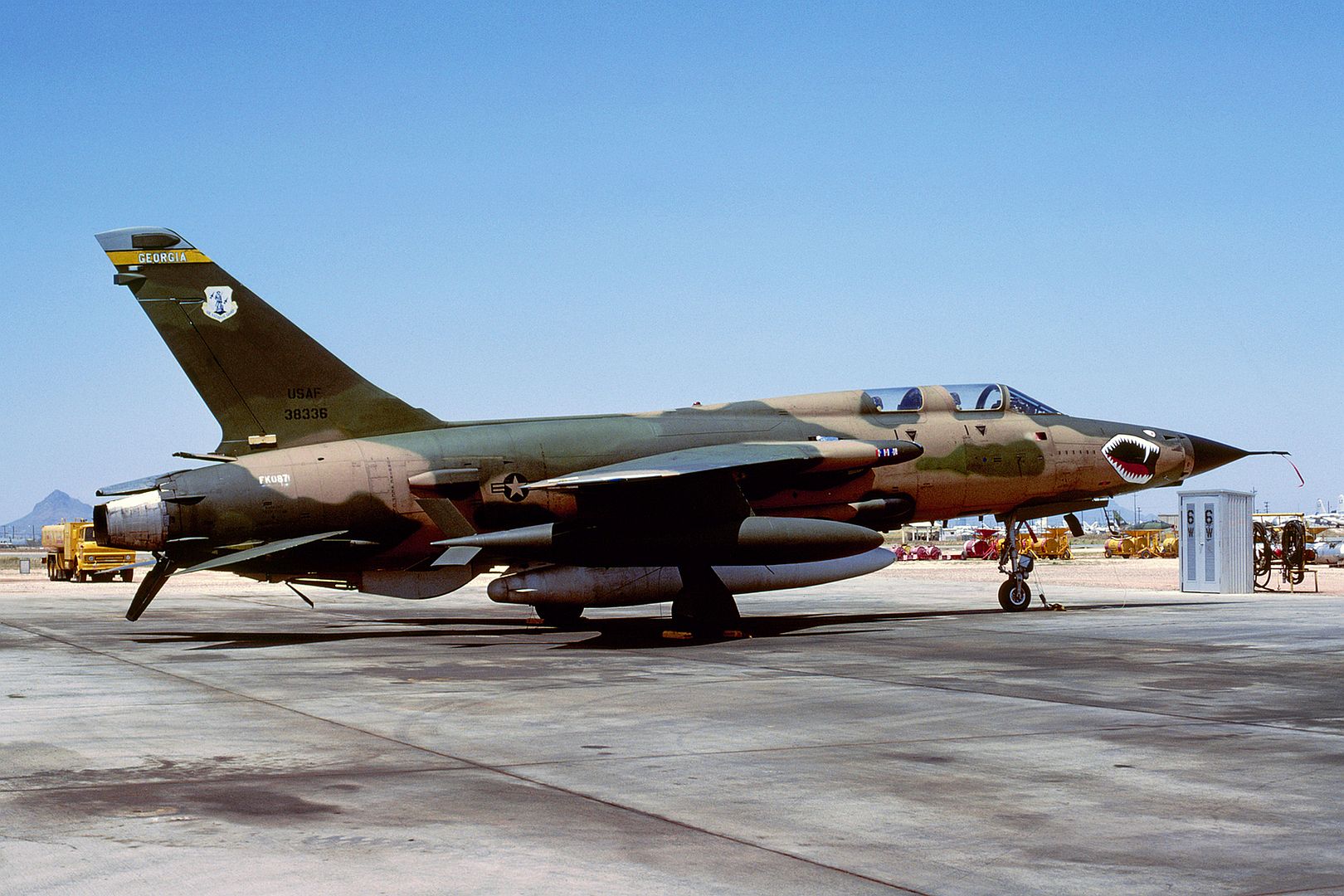
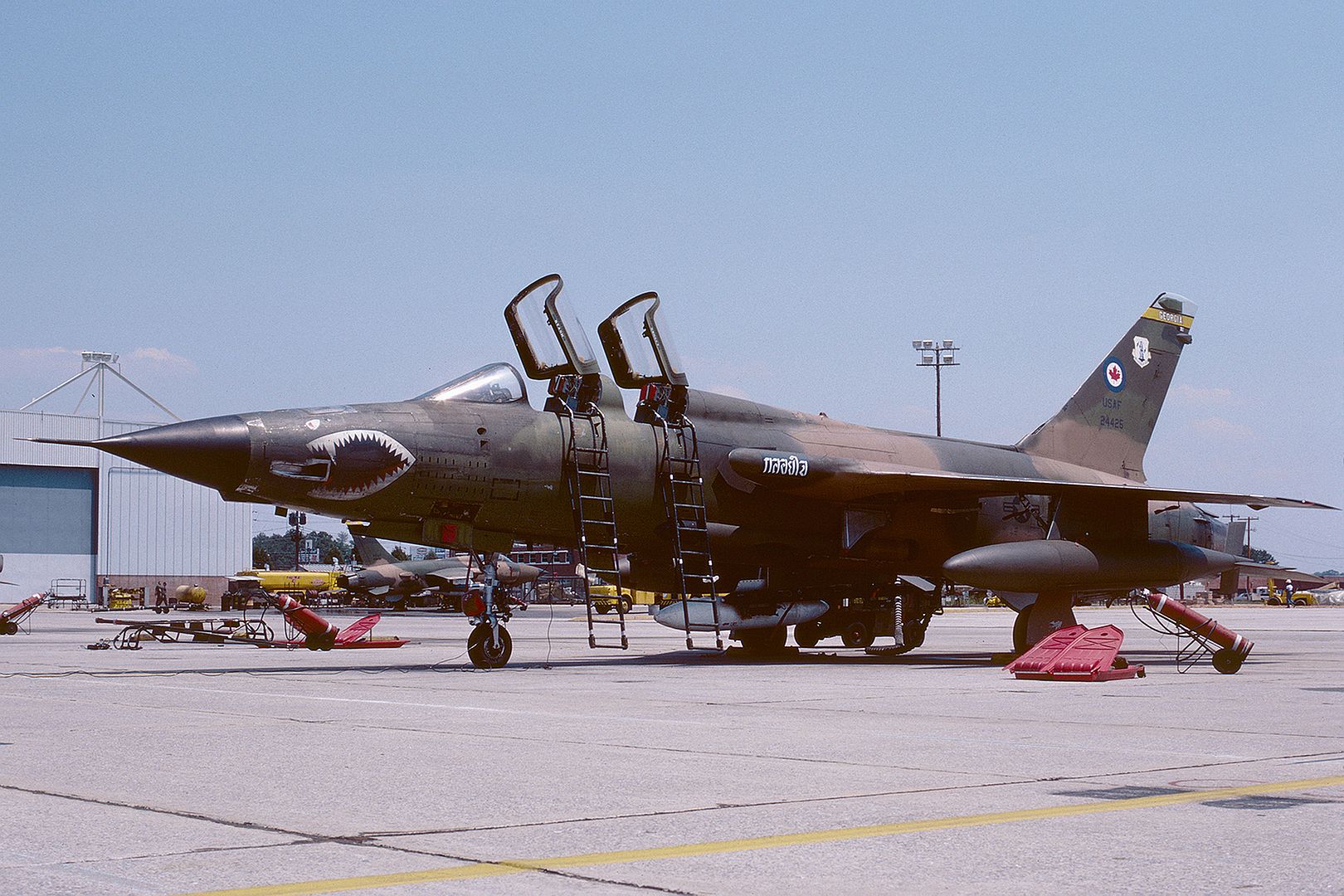
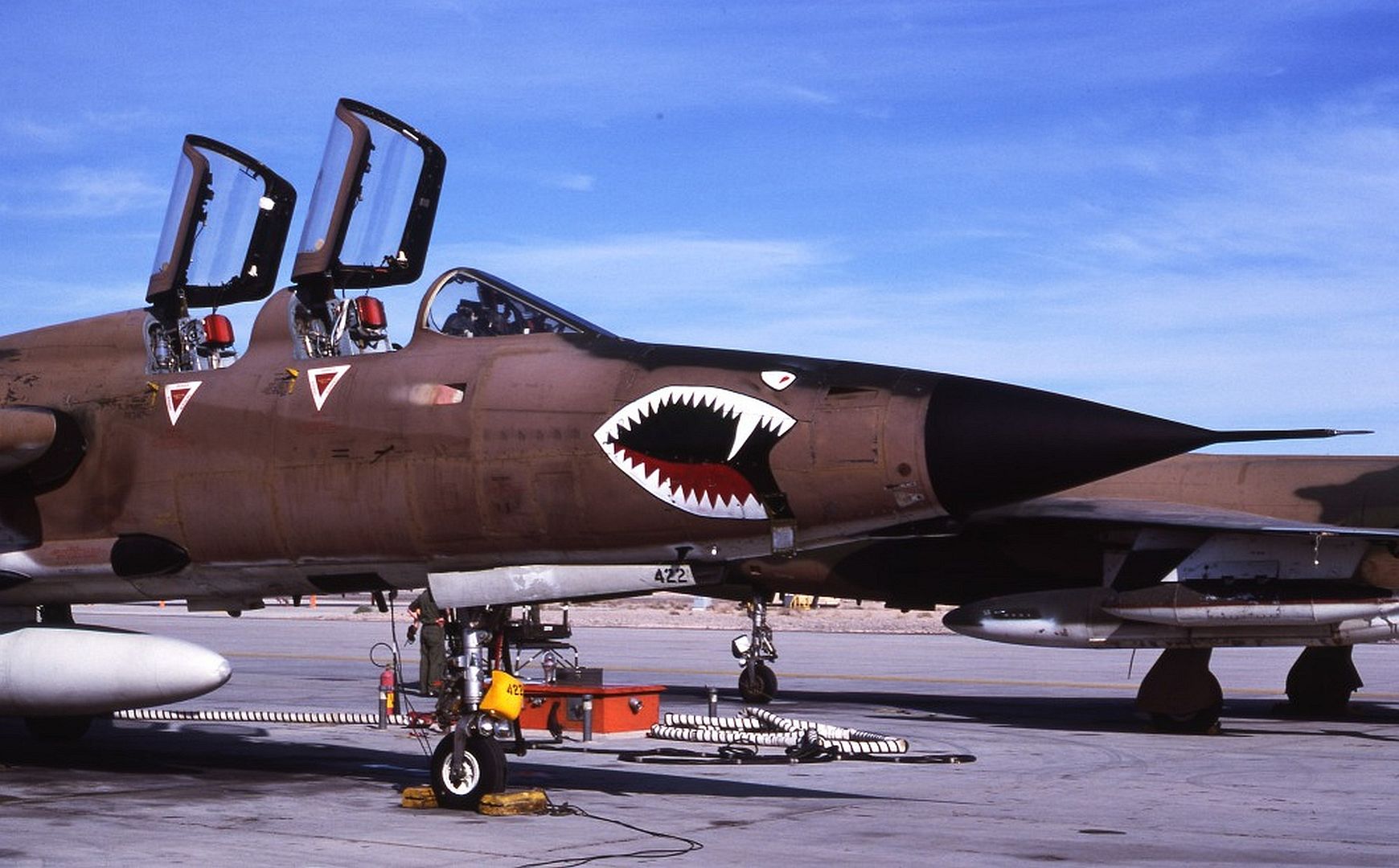
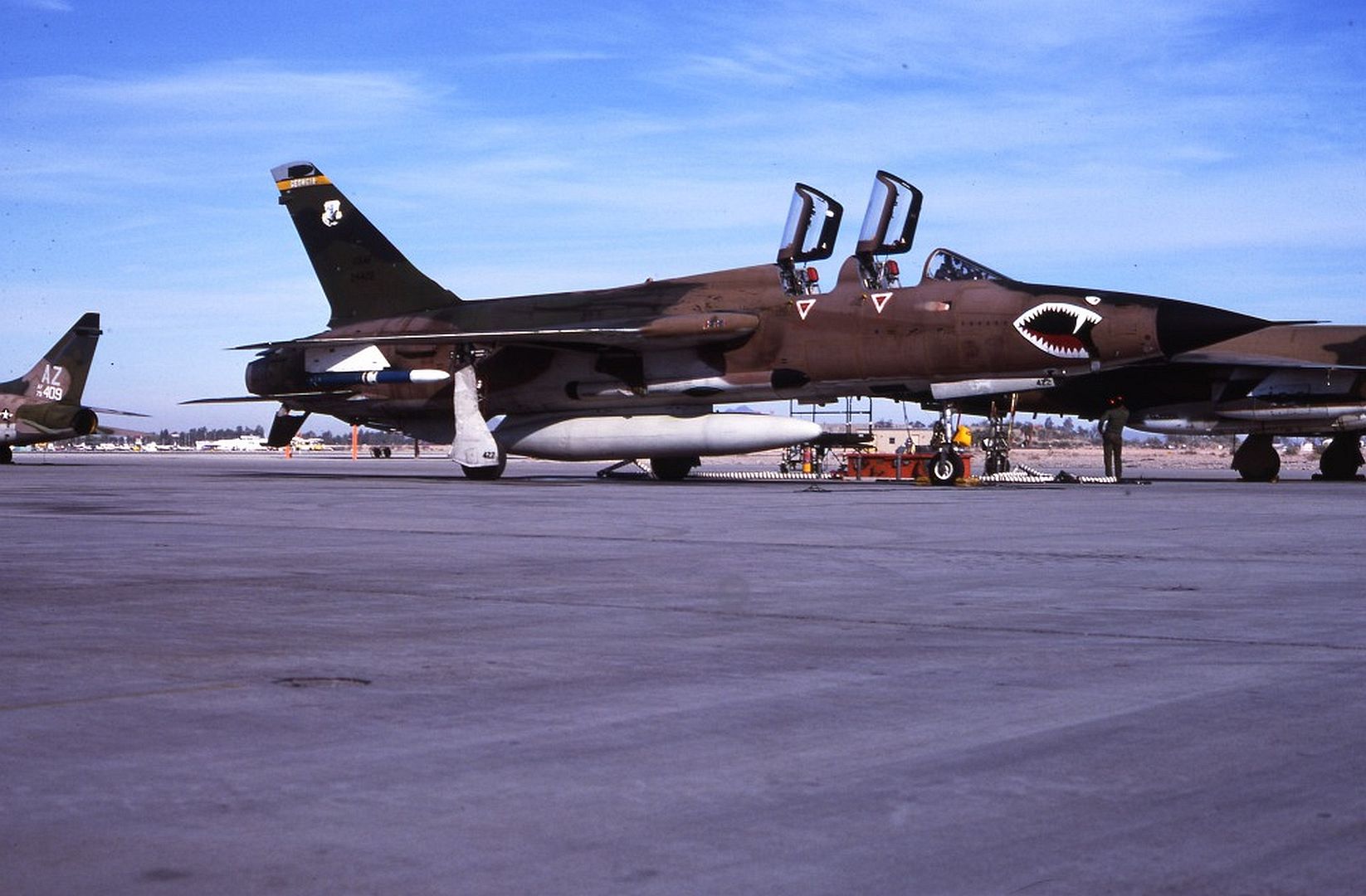
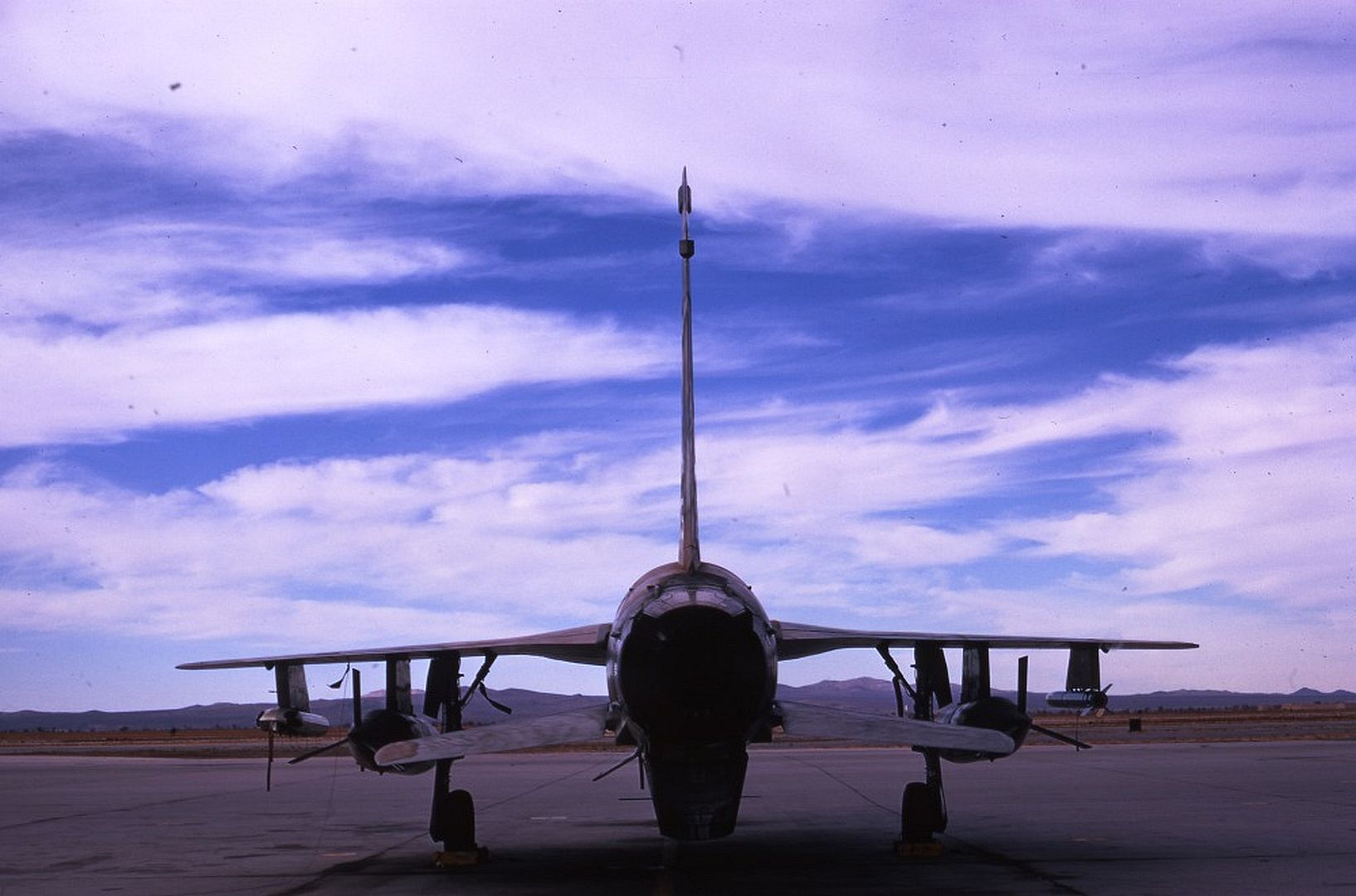
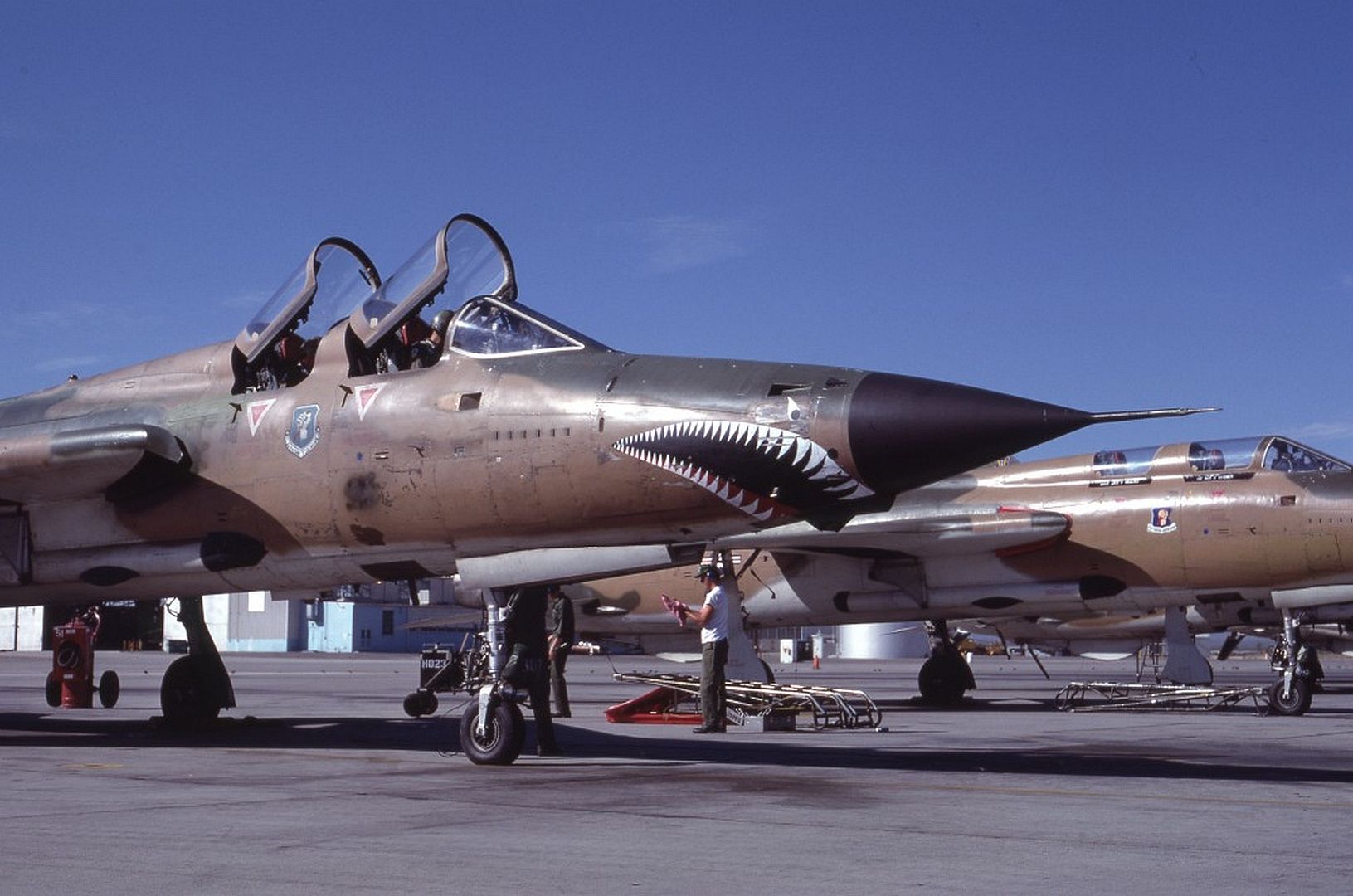
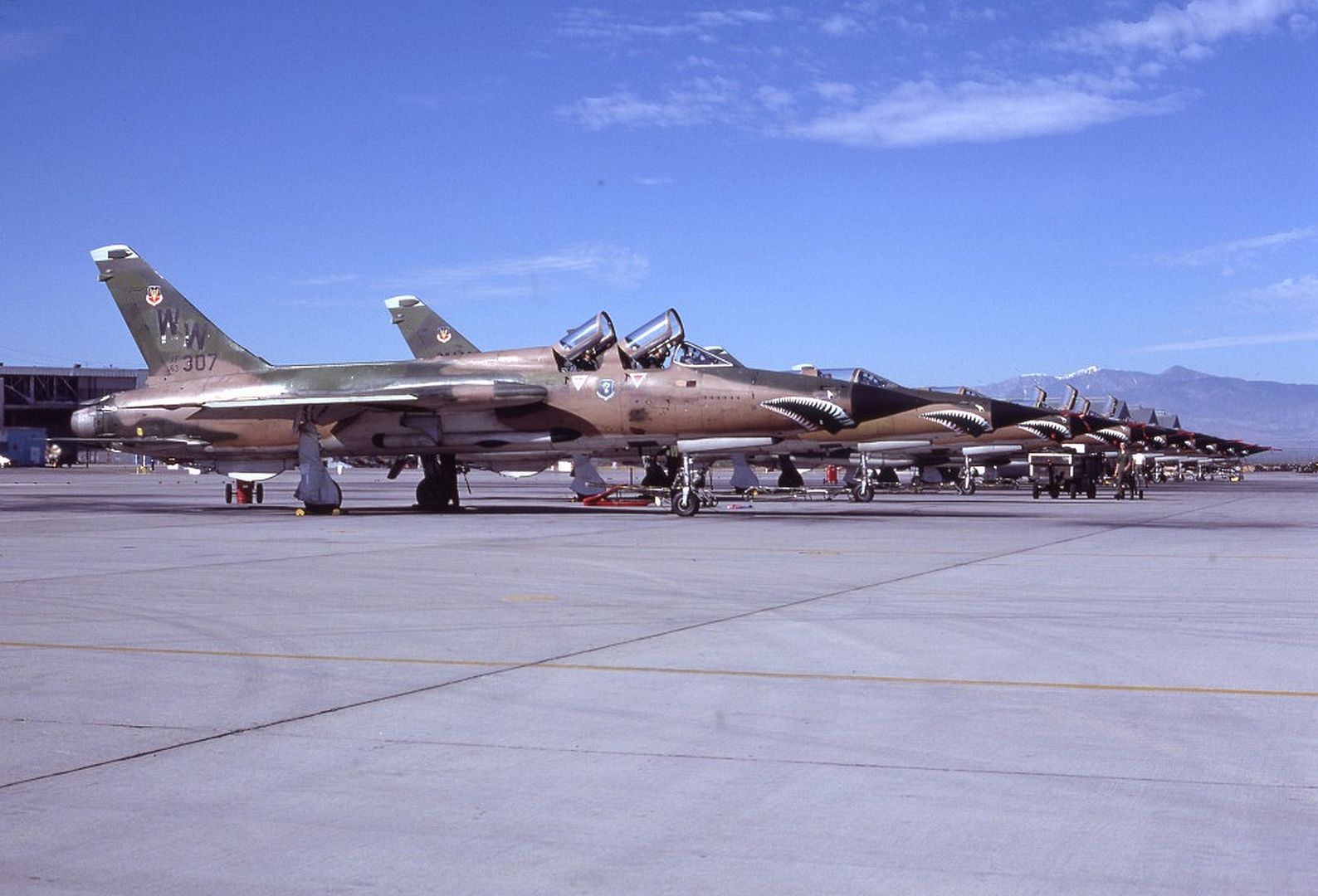
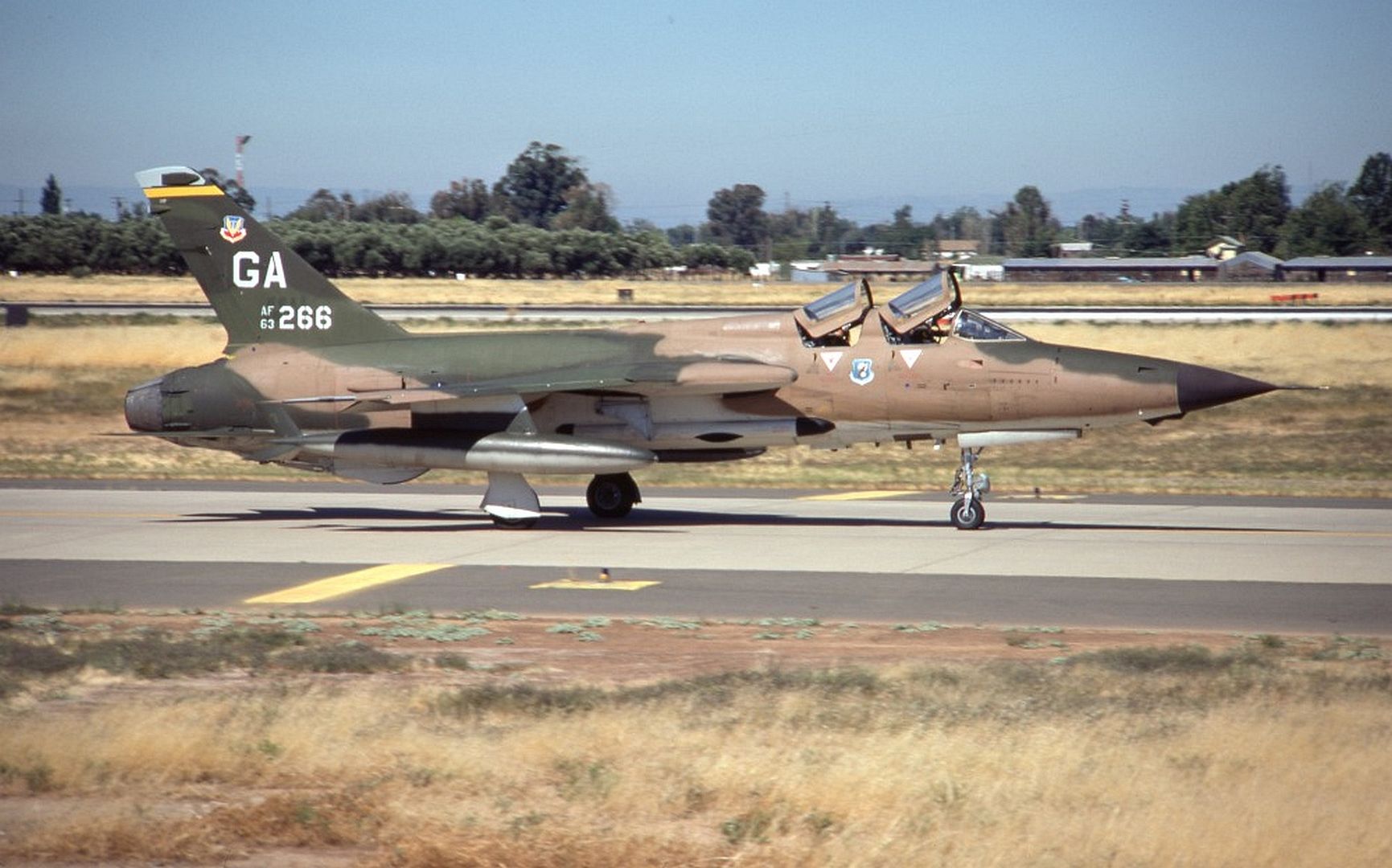
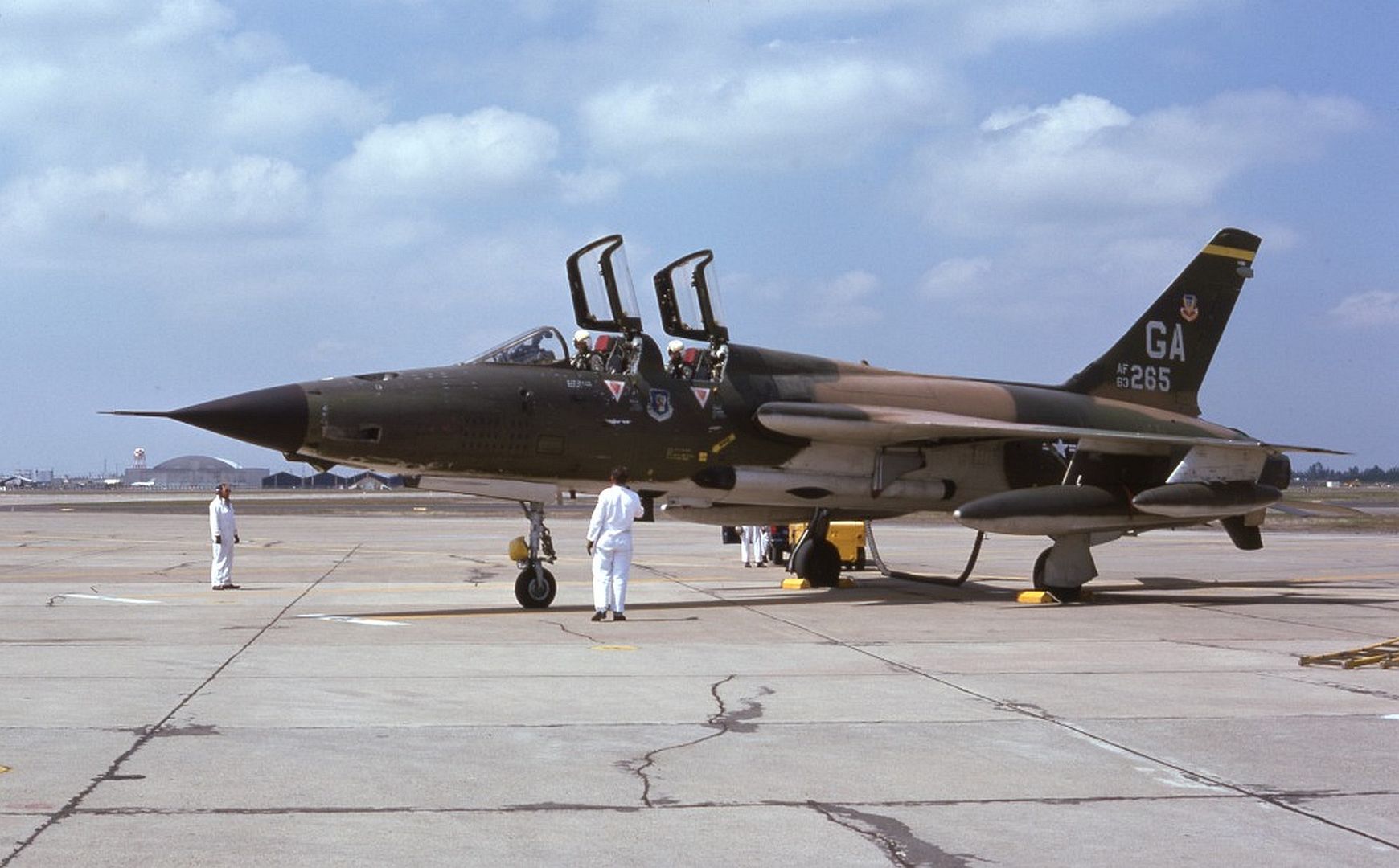
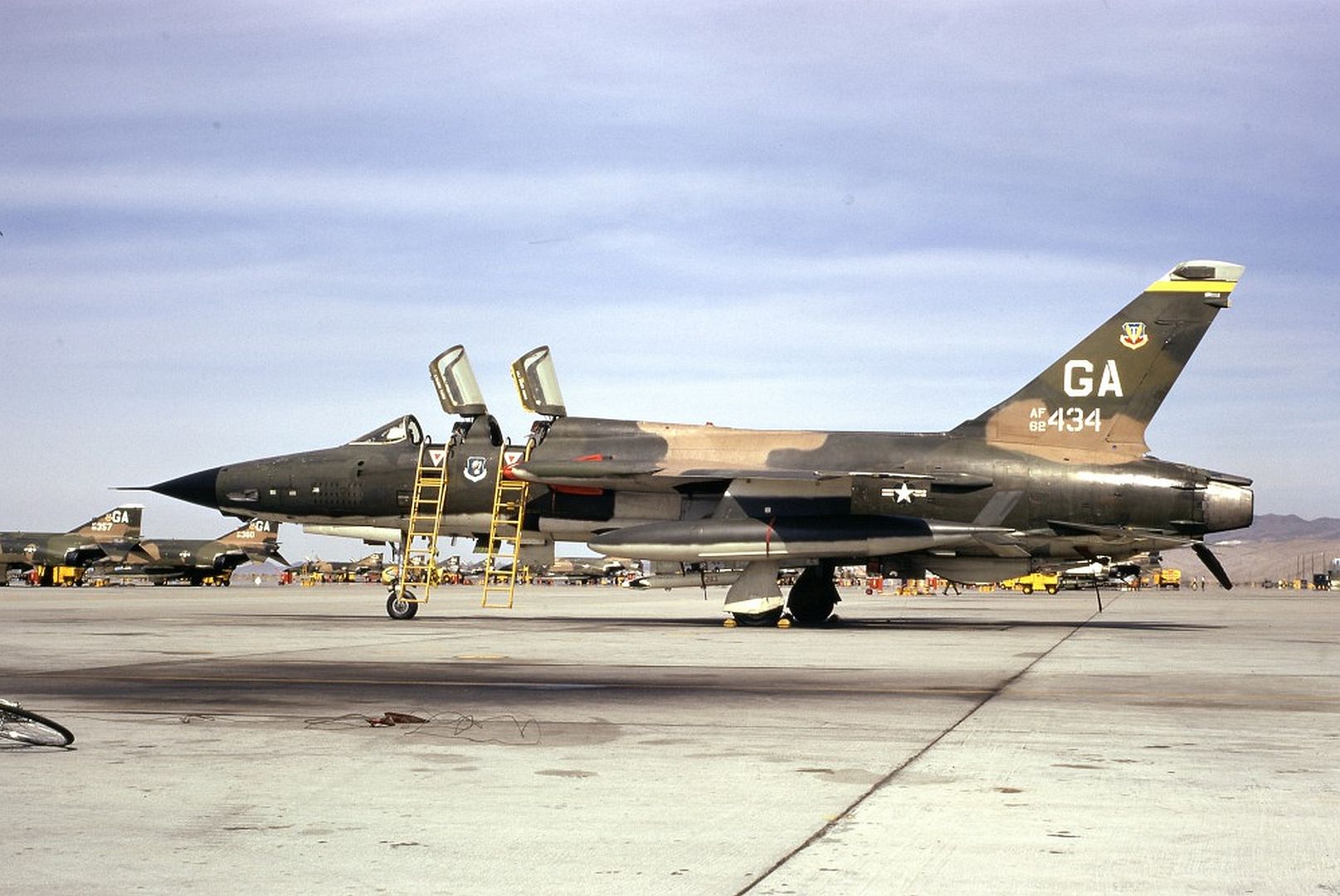
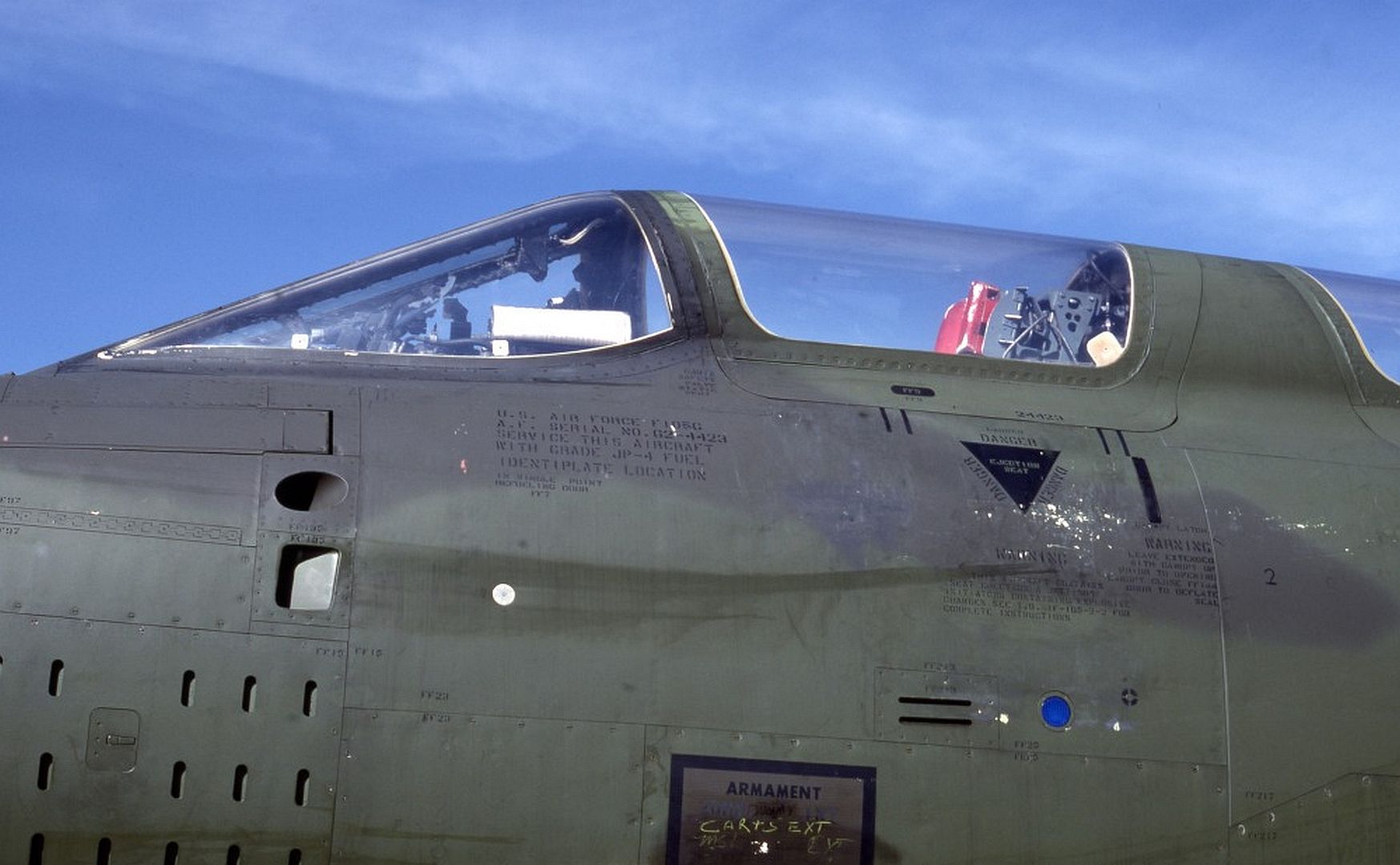


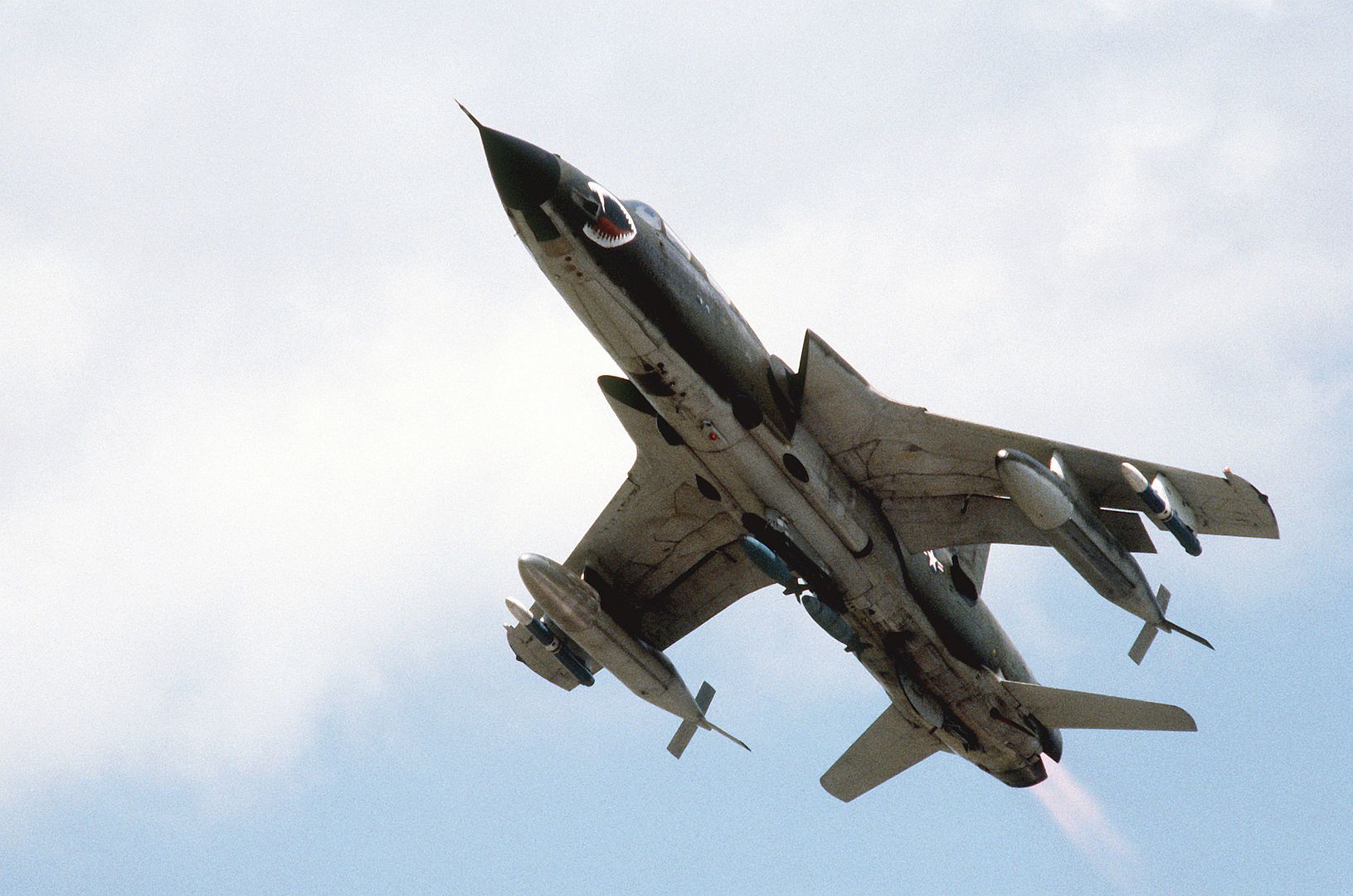
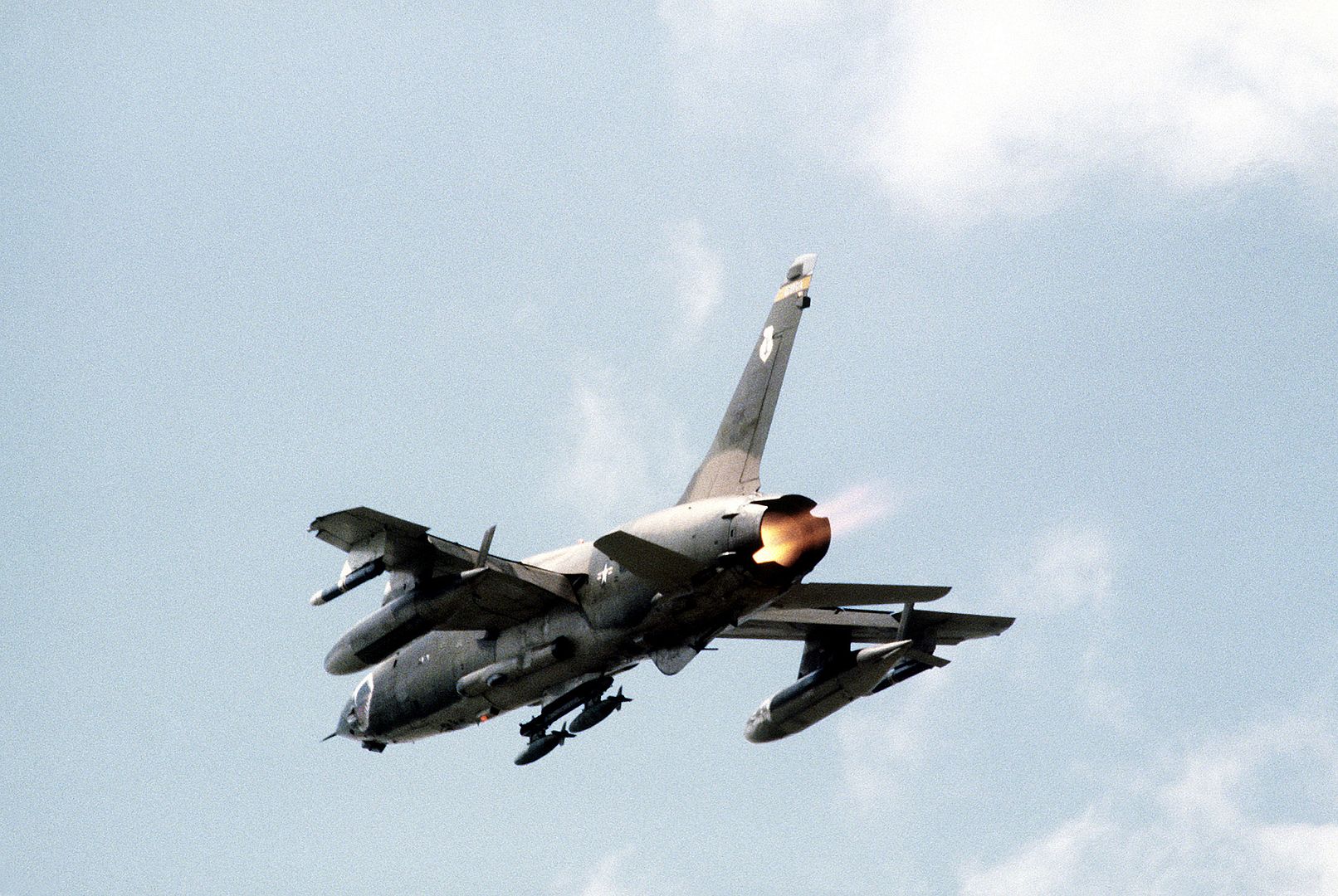
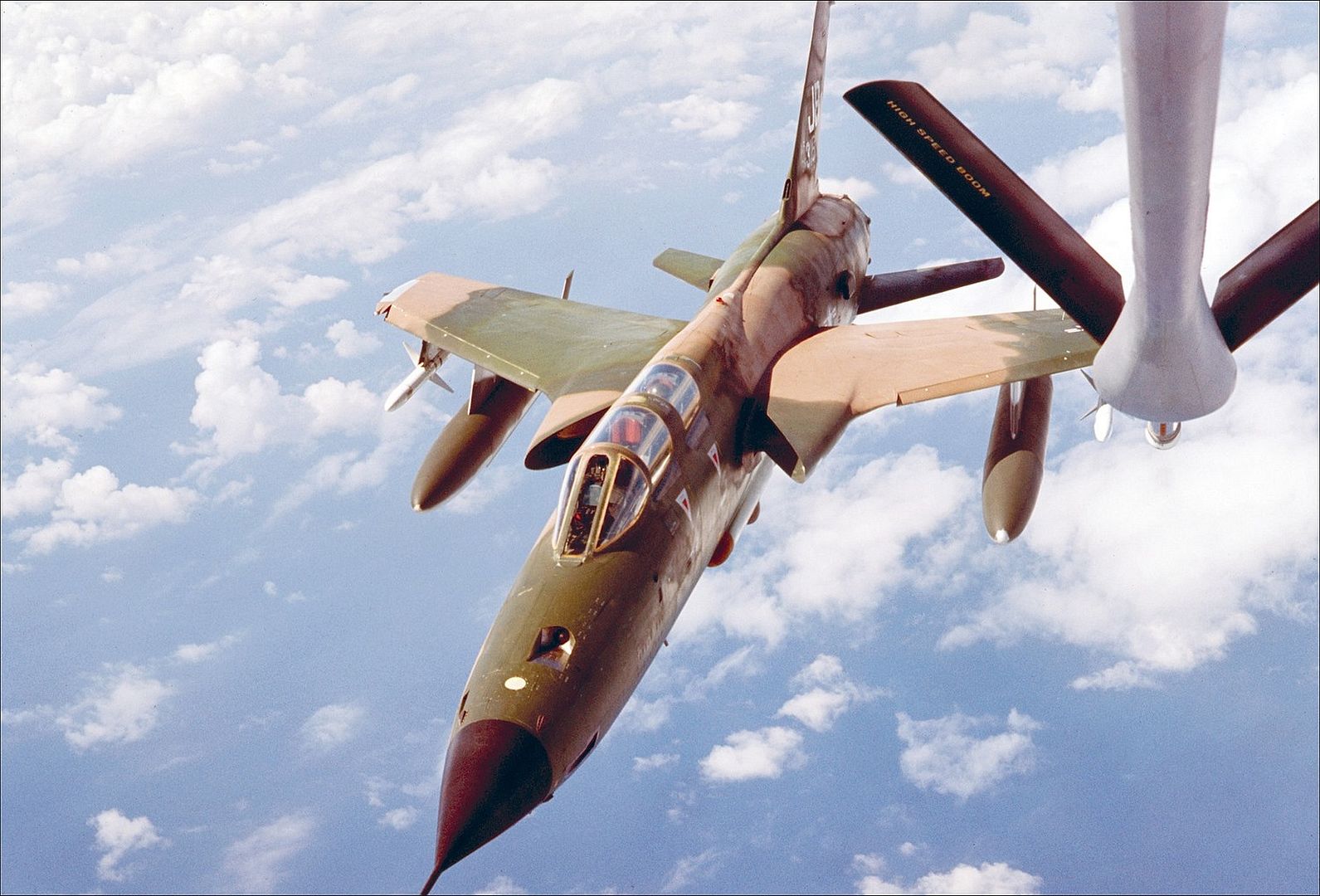
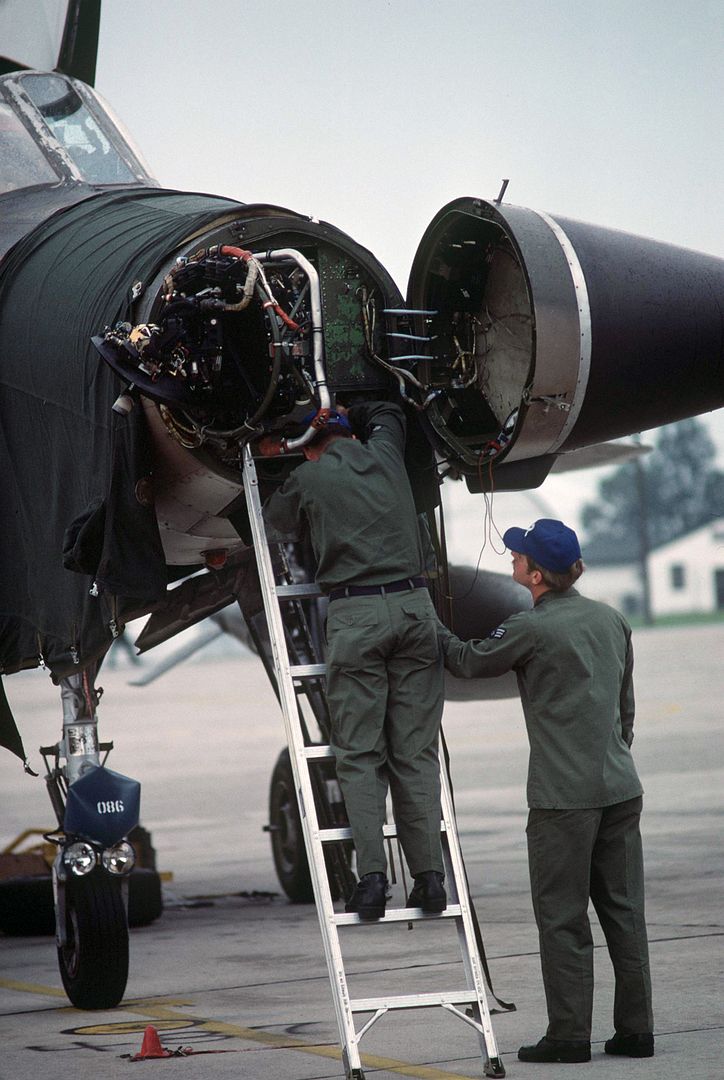

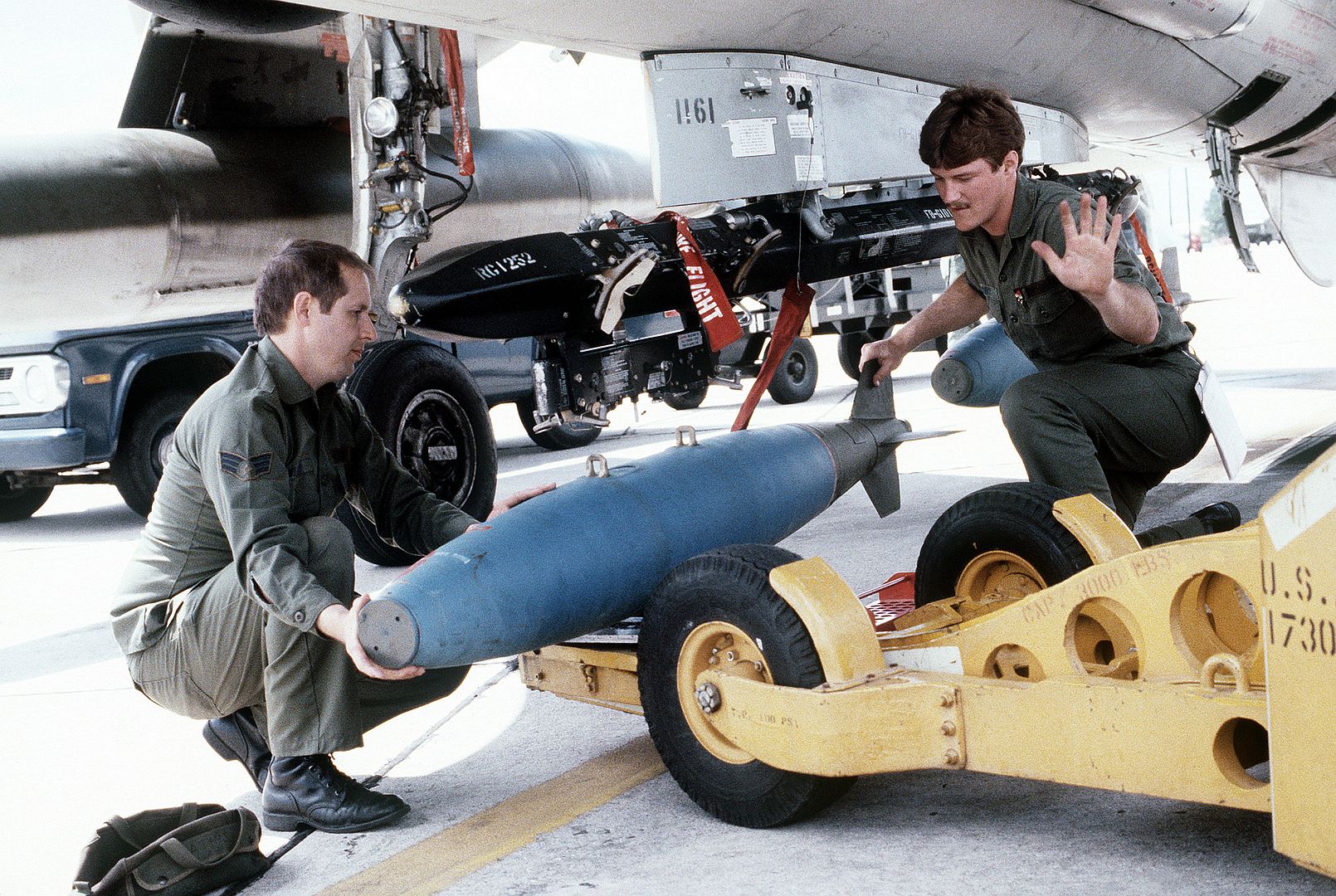
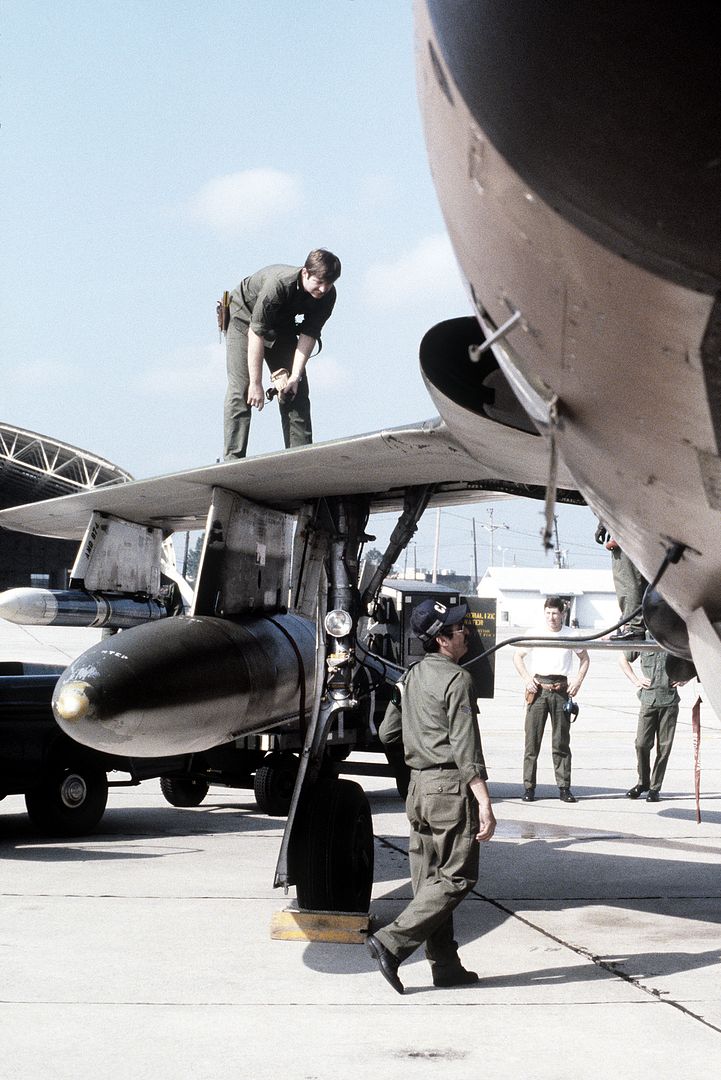
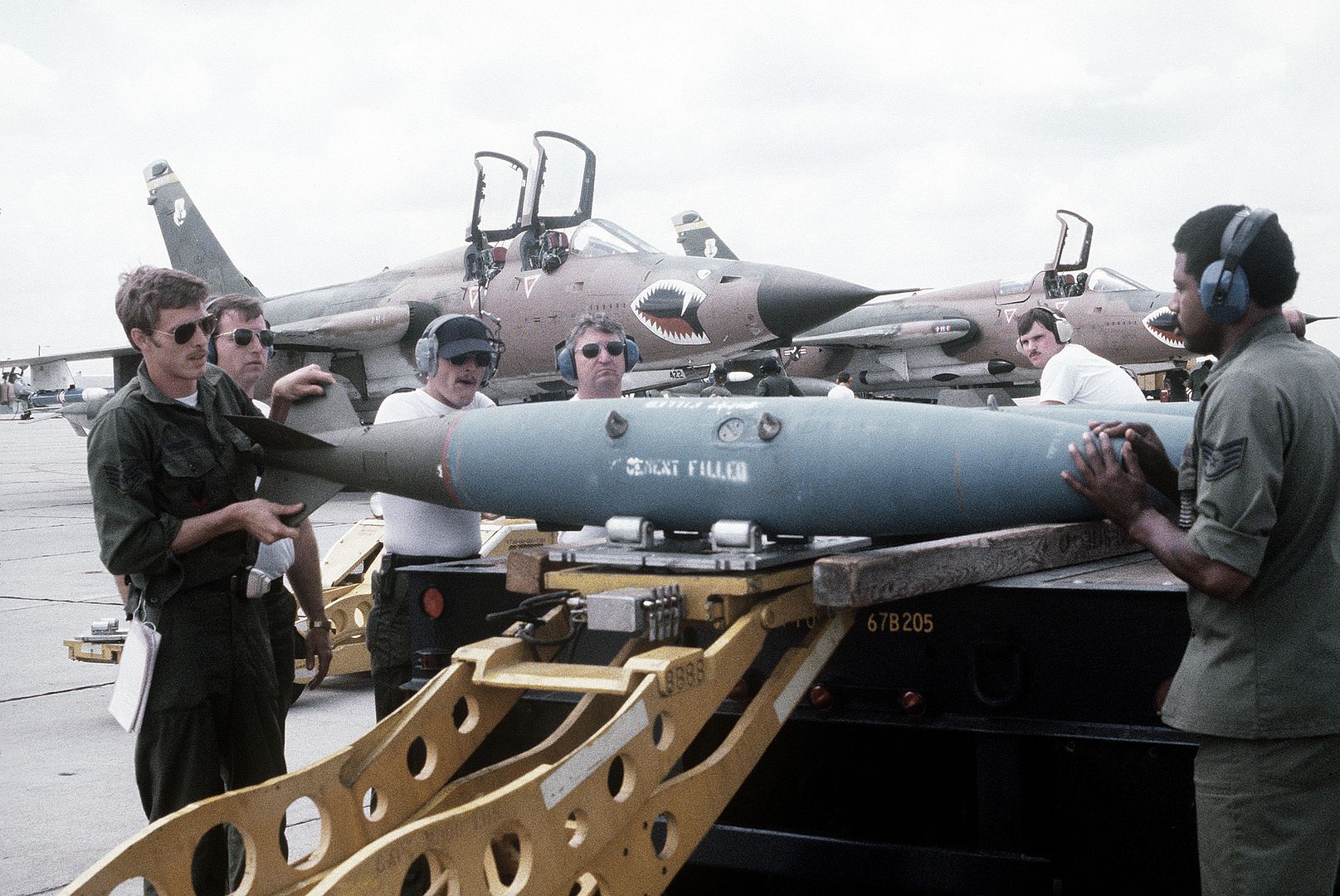
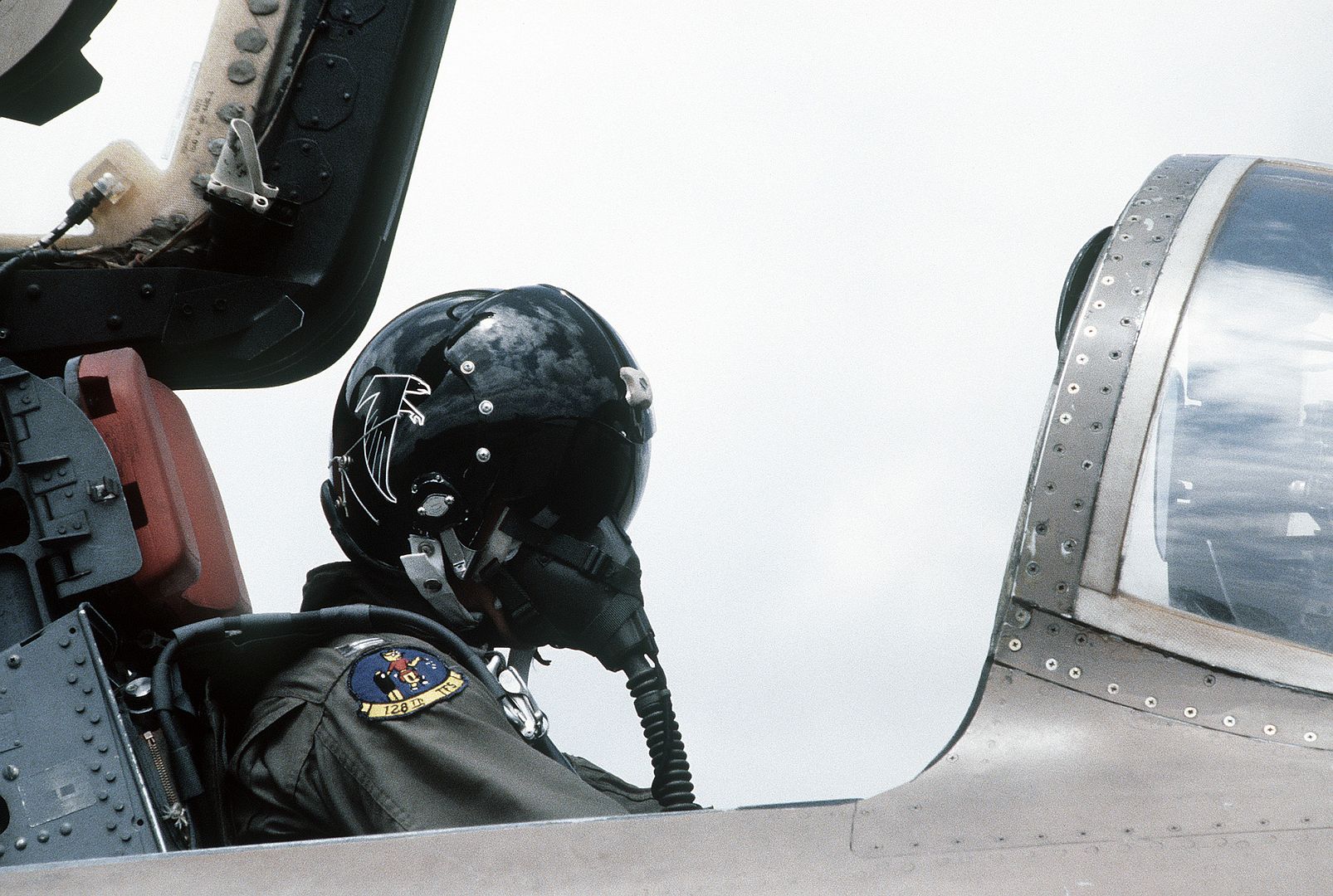
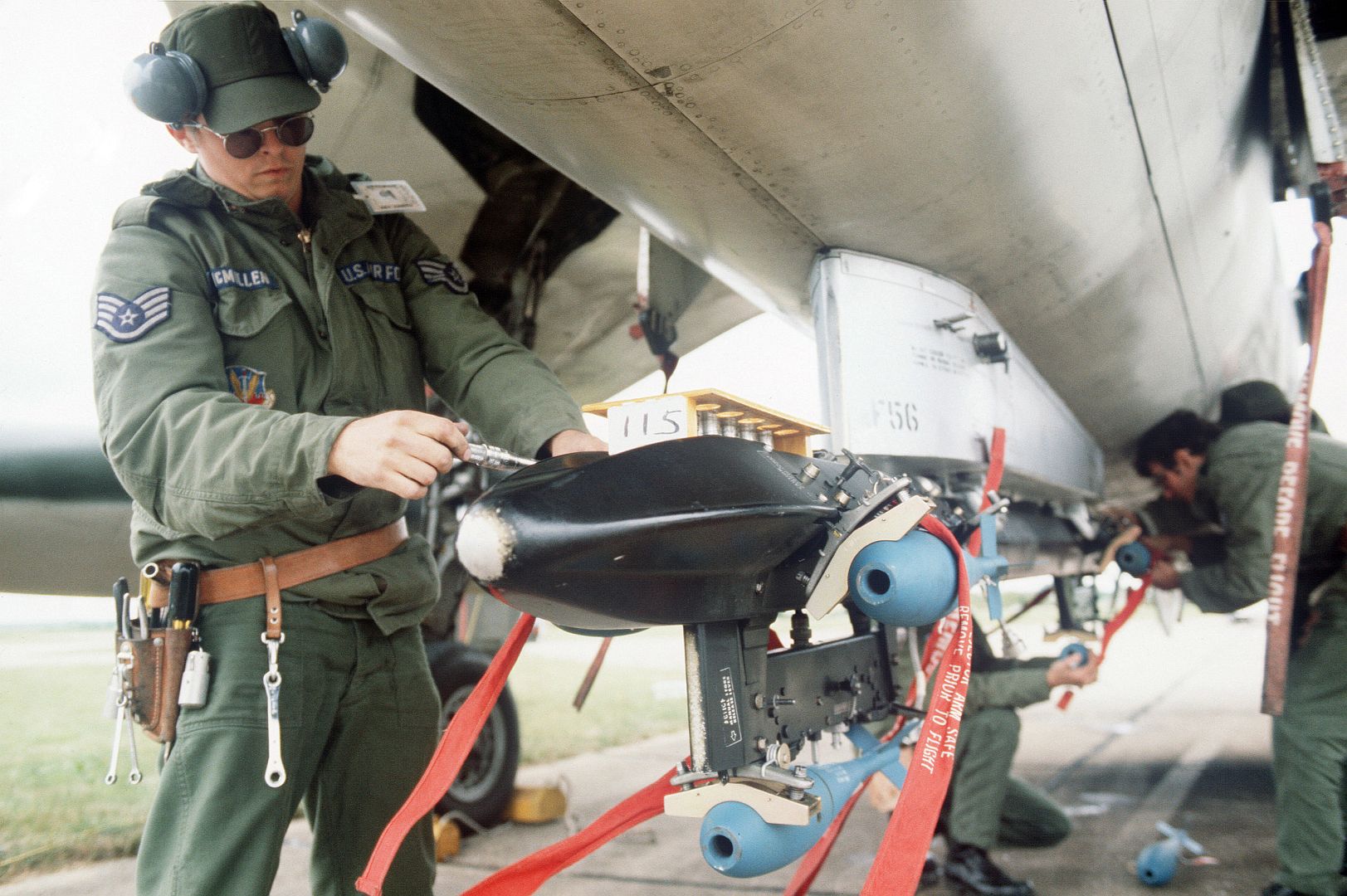

Post a reply
- Go to Previous topic
- Go to Next topic
- Go to Welcome
- Go to Introduce Yourself
- Go to General Discussion
- Go to Screenshots, Images and Videos
- Go to Off topic
- Go to Works in Progress
- Go to Skinning Tips / Tutorials
- Go to Skin Requests
- Go to IJAAF Library
- Go to Luftwaffe Library
- Go to RAF Library
- Go to USAAF / USN Library
- Go to Misc Library
- Go to The Ops Room
- Go to Made in Germany
- Go to Campaigns and Missions
- Go to Works in Progress
- Go to Juri's Air-Raid Shelter
- Go to Campaigns and Missions
- Go to Works in Progress
- Go to Skinpacks
- Go to External Projects Discussion
- Go to Books & Resources
